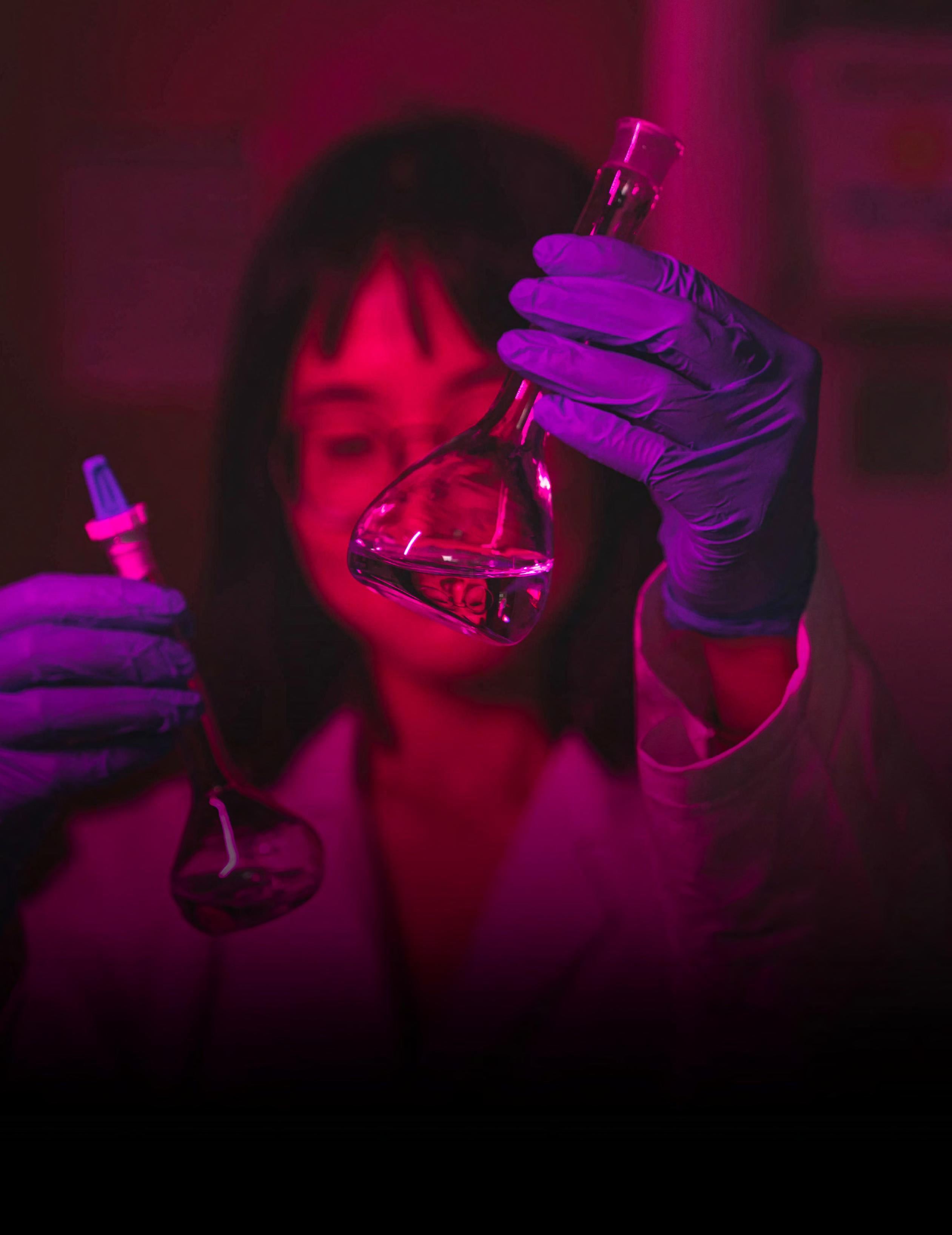
Cullen College of Engineering Magazine • Fall 2022 ENGINEERED FO R WHAT ’S NEXT.
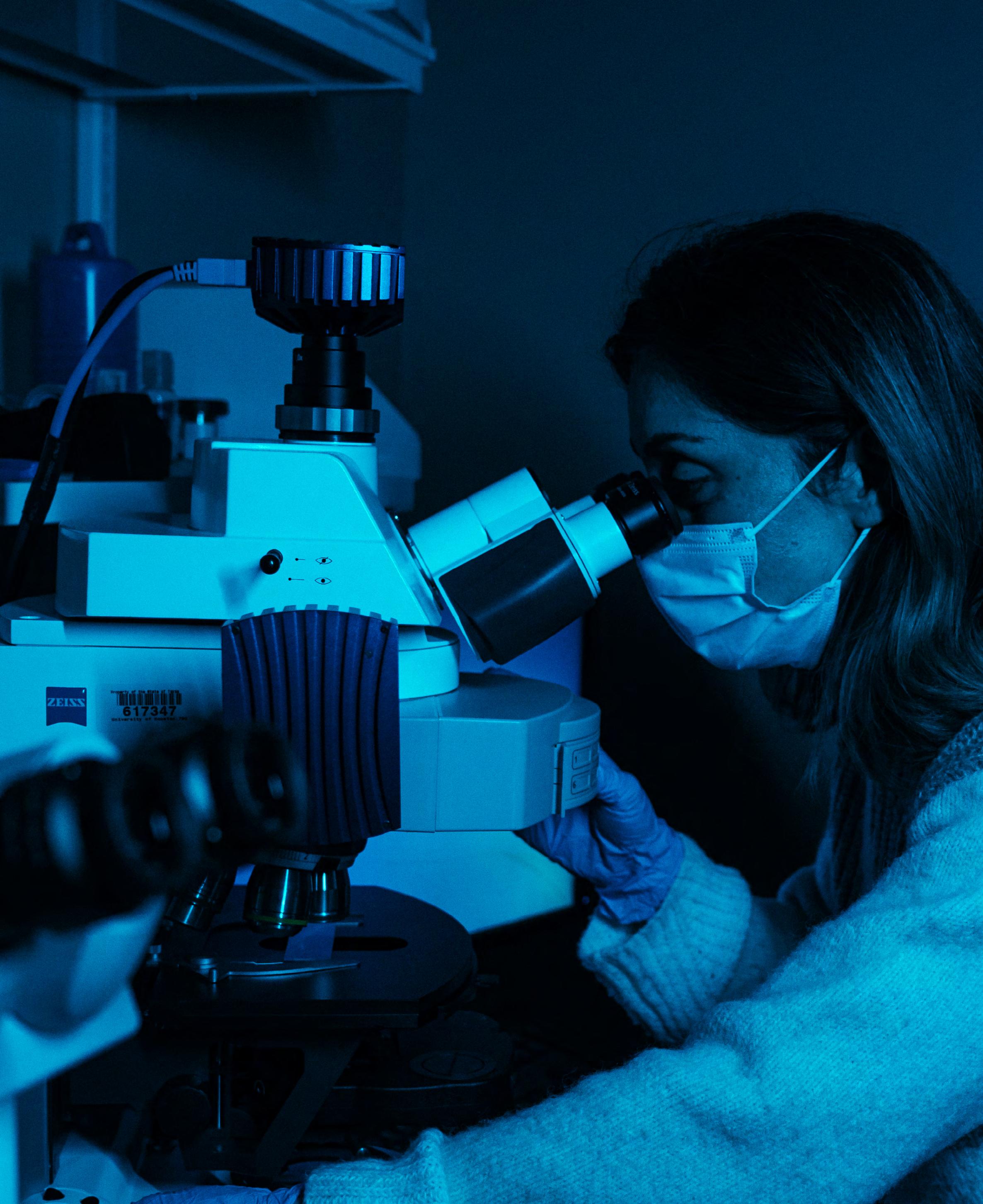
 University of Houston Cullen College of Engineering
University of Houston Cullen College of Engineering
1
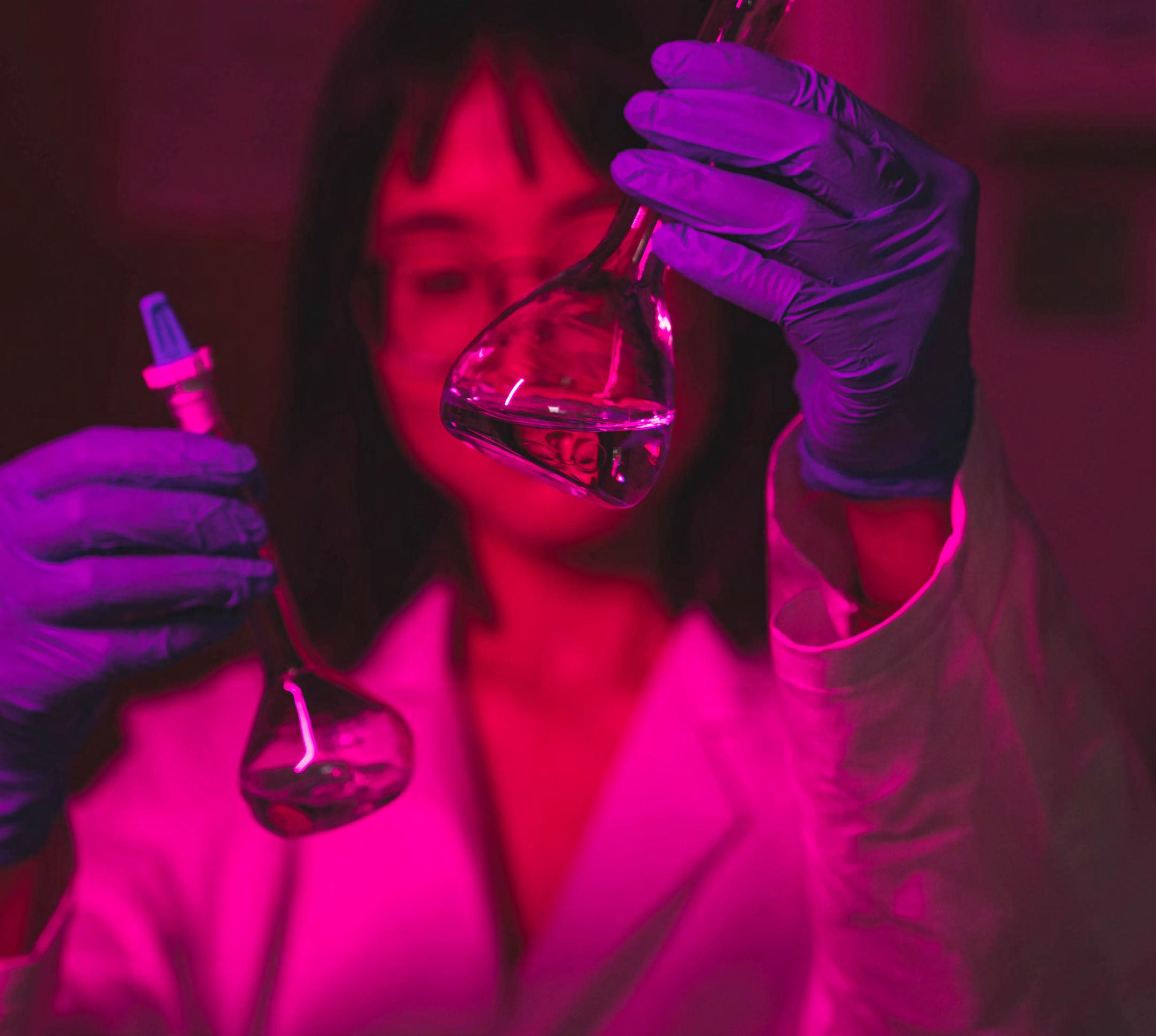
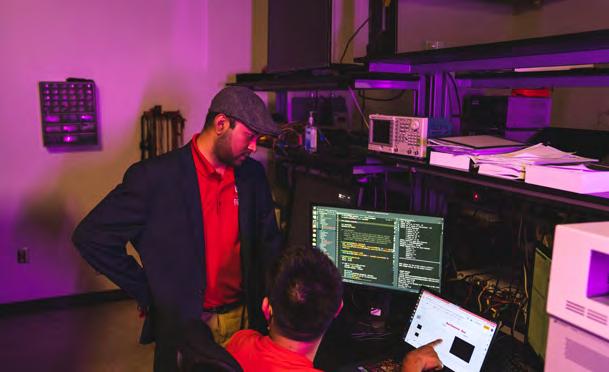
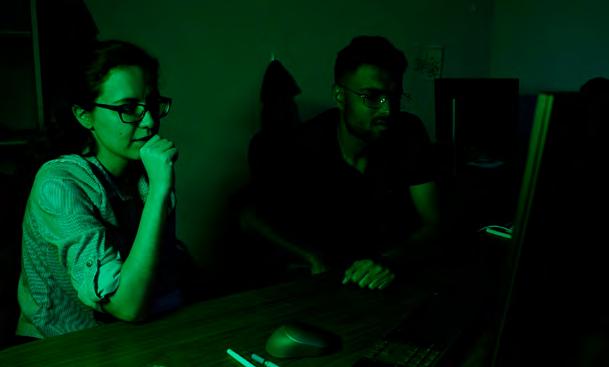

PARAMETERS Fall 2022 I www.egr.uh.edu Cullen College of Engineering Elizabeth D. Rockwell Dean Joseph W. Tedesco Associate Dean for Research & Facilities Hanadi Rifai Associate Dean for Graduate Programs & Computing Facilities Suresh K. Khator Associate Dean for Undergraduate Programs and Distance Learning JR Rao PARAMETERS Parameters is published biannually by the University of Houston Cullen College of Engineering, Office of Communications. Associate Dean of Administration Roshawnda Anderson Executive Director of Communications Rachel Knudsen Communications Manager Inez Hutchinson Graphic Designer Rachel Knudsen Senior Writer/Editor Stephen Greenwell Photographer/Videographer Andrew Dees Contributing Writers & Editors John Lienhard | Aria Shankar Laurie Fickman | Sally Strong Karn Dhingra Stock imagery provided by iStock and Freepik Contact us: University of Houston Cullen College of Engineering Office of Communications Engineering Building 2 4222 Martin Luther King Blvd, Suite E311 Houston, Texas 77204-4009 Those wishing to reprint articles or photographs should contact the director. Use the credit line: Reprinted with permission of the University of Houston Cullen College of Engineering. Clippings are appreciated. The University of Houston is an Equal Opportunity/Affirmative Action institution. Minorities, women, veterans and persons with disabilities are encouraged to apply. ENGINEERED FO R WHAT ’S NEXT. PG. 50 PG. 52 PG. 56 PG. 60Powering the Earth, Moon and Beyond Taking Chances Stable Ground 2 PARAMETERS Fall 2022
Academic Departments
Biomedical Engineering
Chairman: Metin Akay Web: www.bme.uh.edu 832-842-8813

Chemical & Biomolecular Engineering
Chairman: Triantafillos (Lakis) Mountziaris Web: www.chee.uh.edu 713-743-4300
Petroleum Engineering Chairman: Mohamed Soliman Web: www.petro.uh.edu 832-842-4848

Civil & Environmental Engineering

Chairman: Roberto Ballarini Web: www.cive.uh.edu 713-743-4250
Electrical & Computer Engineering
Chairman: Badri Roysam Web: www.ece.uh.edu 713-743-4400
Industrial Engineering Chairman: Gino Lim Web: www.ie.uh.edu 713-743-4180
Mechanical Engineering Chairman: Pradeep Sharma Web: www.me.uh.edu 713-743-4500
Office of Advancement
Mail: University of Houston Cullen College of Engineering Engineering Building 2 4222 Martin Luther King Blvd, Suite E421 Houston, Texas 77204-4007
Attn: Margarita Frinsco Web: advancement.egr.uh.edu
University of
UHEngineering @uhengineering uhengineering UHCullenCollege University of Houston Cullen College of Engineering 4 > ENGINEERING SNAPSHOTS 11 > COLLEGE NEWS 12 > LEAD NEWS 66 > FACULTY NEWS 80 > STUDENT NEWS 94 > ALUMNI NEWS 100 > CULTURE & EVENTS 109 > LAST WORD IN EVERY ISSUE PG. 44 PG. 20 PG. 66 Reconceptualizing Early Mesoamerica Exploring the Secret Lives of Fungi The Electrifying Pradeep Sharma University of Houston Cullen College of Engineering Magazine
of Houston Cullen College
Engineering 3
DEAN’S LETTER
As Dean of the Cullen College, one of my greatest points of pride is the quality of our industrious faculty community. The need for state-of-the-art engineering has increased tremendously in the 21st century, and we are doing our part in keeping up with this demand by investing in vibrant, promising academic talent.
The hiring and retention of star faculty, including prestigious Nation al Academy of Engineering members, has been a top priority for us over the past decade. The Cullen College of Engineering currently has 16 National Academy of Engineering faculty members, the newest of which is our very own mechanical engineering department chair man, Dr. Pradeep Sharma.
Additionally, we are also making a concerted effort to recruit more women and minorities into our faculty ranks. Currently we are on par with national averages in these areas, but continue to strive for improvement. It simply isn't enough to keep up. We hope to lead this important effort and set an example for our peers. Incentives for recruitment and retention include competitive research endow ments and professorships, opportunities with industry to promote entrepreneurship and innovation, research proposal and grant writ ing support, and networking events and workshops for female and minority faculty groups.
As a testament to the great quality of our faculty, we have received 24 Faculty Early CAREER Development Awards over the last elev en years from the National Science Foundation. These prestigious awards are given to support the work of early-career faculty who have been identified as outstanding leaders in their fields at a na
tional scale. We are also seeing an increase in recognition for work beyond our research enterprise, including but not limited to diver sity efforts, student success and more. This is just a fraction of how we are doing our part to elevate the University of Houston to a Top 50 institution.

In this issue of Parameters, we highlight some of the rising stars to have recently joined the Cullen College, along with their incredible work. From groundbreaking advancements in cancer treatments, to powering infrastructures for our world and beyond, I am excited to see what work will continue to come out of our College in the years to come. I hope you enjoy reading about their innovative projects, and if you see opportunities for collaboration, do not hesitate to reach out. Here at the Cullen College, it is our mission to empower today's bright minds so that together, we can power a new possible. This is how through it all, we are engineered for what's next.
Warm regards,
Joseph W. Tedesco, Ph.D., P.E. Elizabeth D. Rockwell Dean and Professor
ENGINEERING SNAPSHOTS
4 PARAMETERS Fall 2022
Texas
California
New 1.38%
Washington – 1.22%
Illinois 1.21%
Colorado - .93%
Michigan - .87%
Massachusetts - .8%
Pennsylvania - .79%
Florida - .67%
66% of Cullen College alumni are currently employed in an engineering field. 78% reside in Texas. Top locations are:
– 78.6%
– 5.15%
York –
–
On average, Cullen College graduates make potential wages upwards of $113K. Top companies where Cougar Engineers are employed: Schlumberger Limited Chevron Corporation Royal Dutch Shell PLC Halliburton Baker Hughes Hewlett-Packard ExxonMobil Corporation Intel Corporation Amazon.com, Inc. Top reported skills by alumni: Microsoft Office MATLAB Research Proficiency Management AutoCAD Data Analysis Project Engineering Leadership Operations Data collected from a pool of 7,500 alumni who graduated between 1995 and 2021. Data populated by Emsi, 2022. We caught up with Cullen College alumni to learn more about their impact in the workforce. Check out where all the Cougar Red is spreading: COOGS AT WORK ON THE JOB University of Houston Cullen College of Engineering 5
ON THE FIVES
BY STEPHEN GREENWELL
5 YEARS BACK...
A story in “The Houston Dream,” Fall 2017 issue, shone a spotlight on the work of Bionka Edmundson and Jameel Jordan with a cooperative program between the University of Houston and iEducate, which pro vides tutors to H-Town schools. Both were at Blackshear Elementary in Houston's Third Ward, a Title I campus where 100 percent of the 536 students at the time qualified for food stamps. Since that time, Edmundson – who earned her B.S. in 2017 in Petroleum Engineering – worked for two years as a field engineer. Since August 2021 though, she has been a sixth grade teacher at the Spring Leadership Academy. In that role, she has been
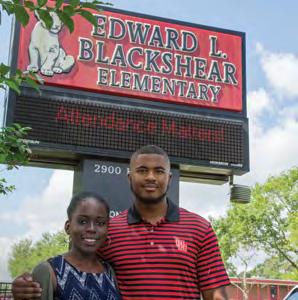


nominated for Rookie Teacher of the Year and Teacher of the Year. Jordan earned his Petroleum Engineering de gree in 2018, and has been a system engineer for Northop Grumman – an aerospace and defense company with yearly revenue of more than $30 bil lion – for four years.
10 YEARS BACK...
Toby Weber wrote a feature on the work of the National Center for Air borne Laser Mapping, which was in its 10th year of operation. “Geosens ing Engineering” looked at the work done by Ramesh Shrestha, Bill Carter, Craig Glennie, Hyongki Lee and Saurabh Prasad using aerial radars and laser arrays on a variety of tasks – from finding lost cities in Honduras, to mapping landmasses from space. All five remain with the university, although Shrestha and Carter are now emeritus investigators. In recent years, Pietro Milillo and Juan Carlos Fernandez Diaz have joined the
An image produced using LIDAR data in Ramesh Shrestha's lab of a lost city in Honduras.

College, and provided insight into the erosion of ice from arctic glaciers and the mapping of nearly 500 ancient villages and sites of Mesoamerica.

GEOSENSING Engineering
A look back at past stories and interview subjects, and what those Cougars are up to now...
University
Pictured left: A recent image of Jameel Jordan. Pictured right: Bionka Edmundson and Jameel Jordan at Blackshear Elementary in 2017.
of Houston Cullen College of Engineering Fall 2012
Tools for Uncovering the Earth
ENGINEERING SNAPSHOTS
6 PARAMETERS Fall 2022
Fall
emerging ENERGY SOLUTIONS
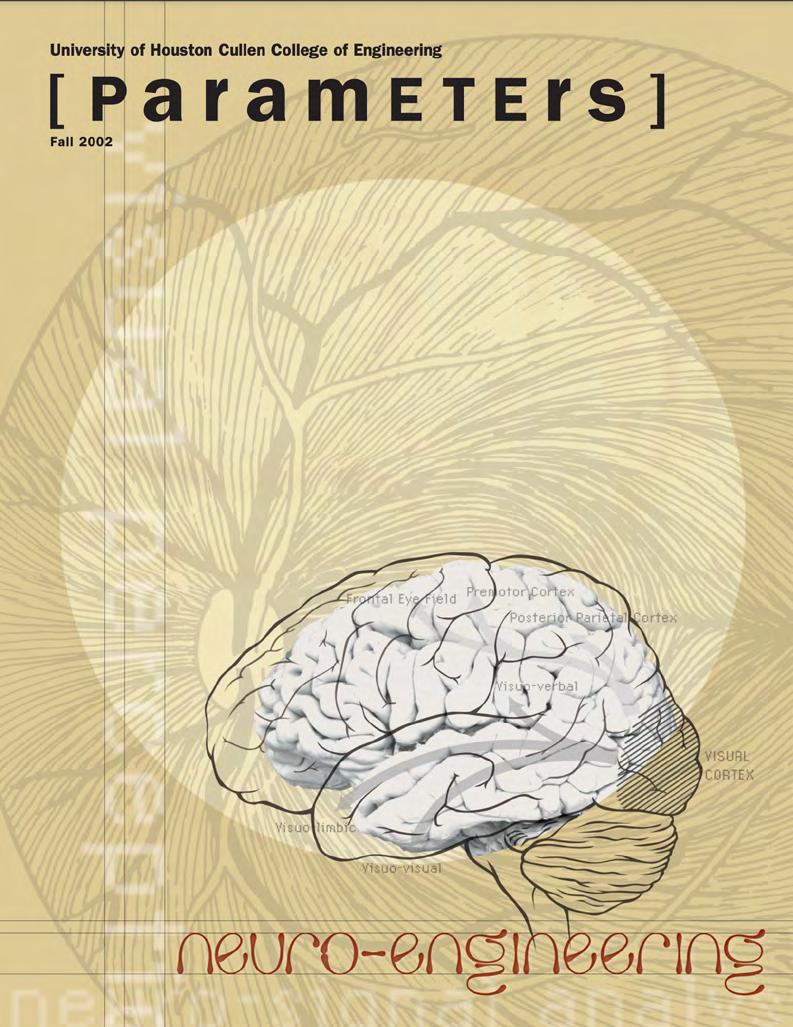

Mitch Bunnell, a 1985 Electrical En gineering graduate, was profiled for being the CEO of Pixelux. The compa ny developed Digital Molecular Mat ter technology for video games and CGI. In the years after the profile, the technology was used in blockbuster movies like Avatar and Skyfall, and games like Star Wars: The Force Un leashed. The company was recognized with an Academy Award in 2015. Also 15 years ago, the Department of Chemical Engineering was renamed to the Department of Chemical and Biomolecular Engineering. Accord
ing to Mike Harold, the Dow Chair Professor and Department Chair at the time, the change was to reflect the direction of the field of chemical engineering. “We’re expanding into different areas, notably biotechnolo gy. Biomolecular engineering is a re flection of one component of biotech where chemical engineers are mak ing an impact,” he said. Since then, the department received a generous gift from an alumni in 2020, and is now known as the William A. Brook shire Department of Chemical and Biomolecular Engineering.
This issue featured a “Spotlight on Stu dents” that included Kathleen Akkerman, who was balancing the rigors of an engineering career with a music minor. While working a summer intern ship at NASA and participating in eight different engineering societies, she also played the viola in a community orches tra and performed professionally in a string quartet. She graduated with her B.S. in Electrical Engineering in 2003 and earned her master's degree in 2005. Since graduating from UH, Kathleen has worked in engineering leadership roles at several aerospace and defense companies in California over the past 17 years. In 2018 she became the Chief Engineer for Antcom Corporation in Tor rance, which specializes in antennas for GPS navigation and airborne commu nications. In August 2022, she took on a new challenge as Engineering Direc tor at Ducommun, where she will lead the development of radar components, high-reliability motors, and human-ma chine interface products.
She is also now Kathleen Fasenfest, after marrying Benjamin Fasenfest, another Cougar alum from the Cullen College of Engineering. Kathleen and Ben have a son named Maxwell who is still learning the famous equations. The family enjoys ice hockey, skiing and hiking together, and they're generally active outdoors each weekend. Kathleen continues to play the viola as a member of the Beach Cities Symphony Orchestra. YEARS BACK...
When it came to her time at the univer sity, Kathleen said, “UH prepared me for leadership and gave me a place to grow. Working with Fritz Claydon and Stu art Long were formative experiences

that allowed me to experience research firsthand and to gain confidence in my self. My UH experience prepared me for whatever I’ve wanted to do, from interning at NASA to innovating at the national laboratories to driving change at multi-national corporations.”
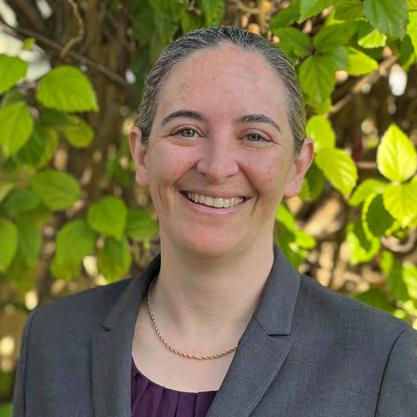
“Get involved in the extra-curricular activities, the internships, and the undergraduate research programs. These programs will give you experiences to draw upon in the working world and will help connect the dots between courses to see how it all fits together. The people you meet and the things you achieve together will help you learn to form and guide teams throughout your career.”
For current students, Kathleen offers this advice:
Kathleen Fasenfest with son Maxwell.
University of Houston Cullen College
University of Houston Cullen College of Engineering
2007
15 YEARS BACK...
20
of Engineering 7
IN THE MEDIA SPOTLIGHT
TVO ARTS
HIGHLIGHTS UH BRAIN RESEARCH

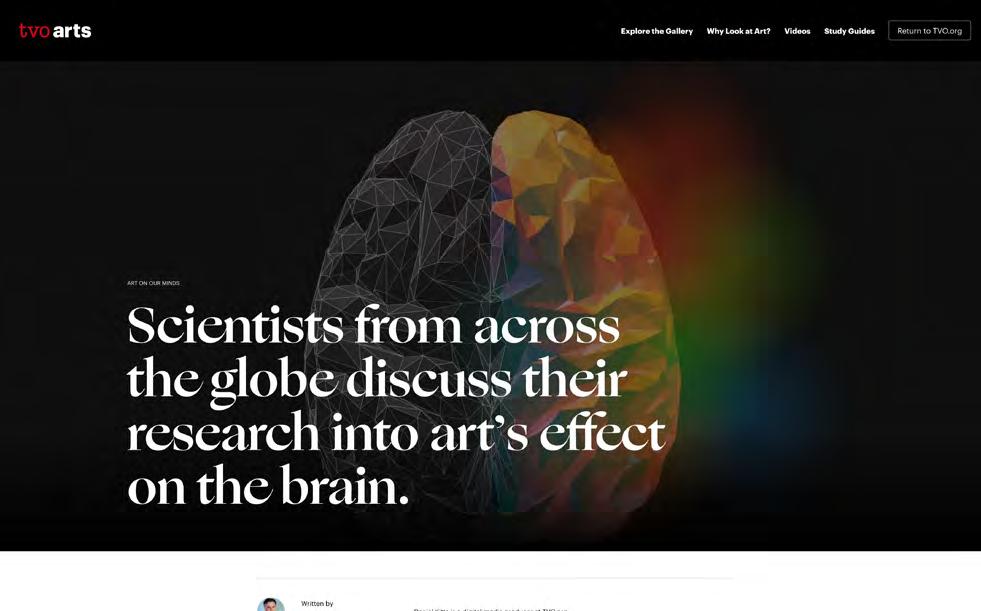
TVO Arts featured the work of Jose Luis Contreras-Vidal, Hugh Roy and Lillie Cranz Cullen Distinguished Professor and Director of the NSF IUCRC BRAIN Center, and his research team in an article for its Art On Our Minds section. Contreras-Vidal has conducted numerous studies that look at how our brains experience works of art and how its therapeutic properties can potentially be applied to individuals with brain injuries and mental illness.
VIEW ONLINE AT: www.tvoarts.org/articles/effect-of-art-on-the-brain
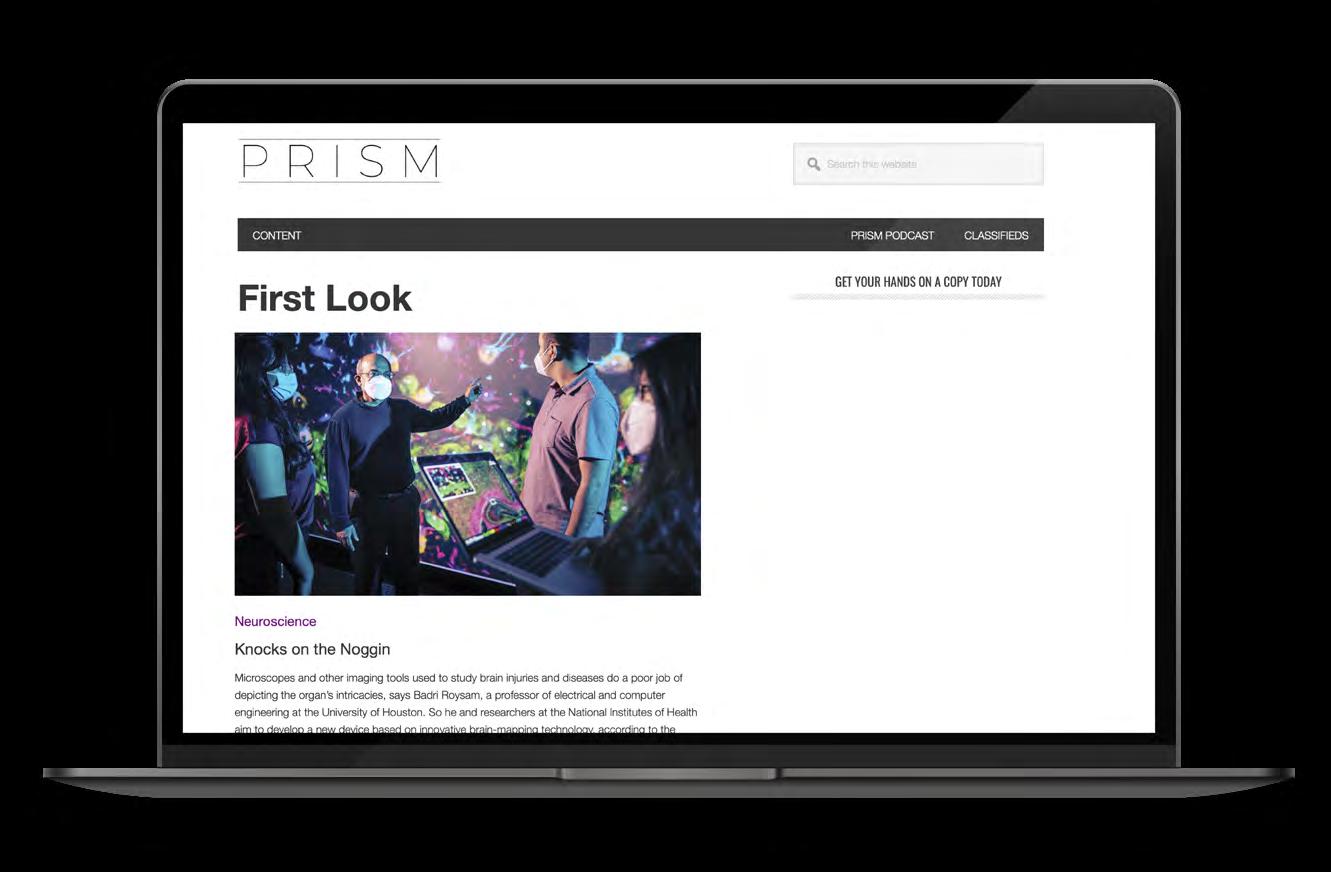
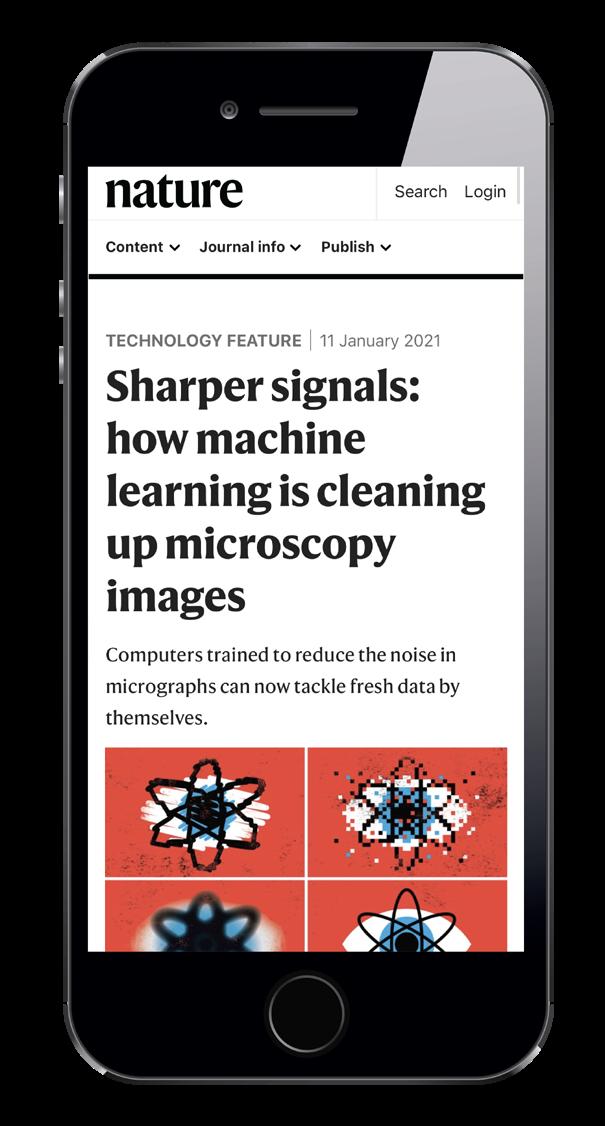
TROUBLE IN THE ARCTIC GOES VIRAL
After releasing new findings concerning the world’s glaciers, more specifically regarding the record-high rate at which they are melting, Pietro Milillo, an assistant professor of civil and environmental engineering, has caught the attention of numer ous media outlets. His research was published in Nature Geosci ences earlier this year, and has since been featured on Wired. com in an online article and in National Geographic España



COVERED BY:
WIRED.com: www.wired.com/story/seri ous-salty-trouble-may-be-brew ing-under-antarctic-glaciers/ National Geographic España: www.nationalgeographic.com. es/ciencia/cientificos-docu mentan-perdida-hielo-glacia res-antartida-como-nunca-an tes_17856
INSPIRING CANCER RESEARCH GARNERS ATTENTION

Houston Innovationmap recently spotlighted Gül Zerze, an assis tant professor of chemical and biomolecular engineering at the Cul len College of Engineering. Zerze was recruited to the University of Houston earlier this year. Zerze brought a $2 million grant from the Cancer Prevention and Research Institute of Texas with her at the time of her hiring. The grant will be used to fund Zerze’s inspiring work which will test a first-of-its-kind breast cancer drug. Zerze’s work also caught the attention of Culturemap Houston, featured in an online article in March.

READ MORE ONLINE AT:
Houston Innovationmap houston.innovationmap.com/university-of-houston-gul-zer ze-cprit-2656845658.html
Culturemap Houston houston.culturemap.com/news/innovation/03-08-22-universityof-houston-breast-cancer-drug-gul-zerze/
ENGINEERING SNAPSHOTS
UH NEWCOMER’S
8 PARAMETERS Fall 2022
YAN YAO ON THE FUTURE OF ELECTRIC VEHICLES
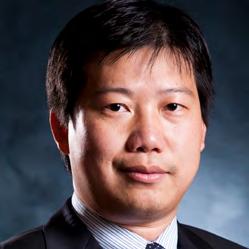
Yan Yao, Cullen College of Engineering Professor of Electrical and Computer Engineering, gave KPRC Channel 2 Investigates an inside look at his research lab and his revolutionary work on new lithium and transition metal-free batteries that last longer and charge faster. These power sources have the potential to be a game changer for the electric vehicle market by bringing down charging costs, which are currently considerably high.
VIEW ONLINE AT: www.click2houston.com/news/investigates/2022/03/17/confront ing-the-problems-texans-have-with-electric-vehicles/?outputType=amp


STANKO BRANKOVIC TALKS
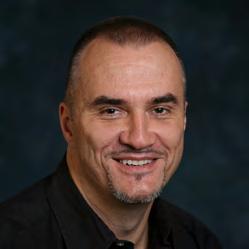
NUCLEAR SAFETY WITH KPRC 2
Shortly after the onset of the Russian war in Ukraine, Stanko Bran kovic sat down with KPRC Channel 2 Investigates to put worries re garding the safety of American nuclear facilities to bed. Brankovic, an electrical and computer engineering professor and Fellow of the Electrochemical Society, explained how these facilities are tested to withstand natural disasters and threats, including cyber-attacks. Bran kovic’s work centers on finding ways to produce nuclear energy in the safest possible environment.

THE 10 MOST DANGEROUS HARRIS COUNTY INTERSECTIONS
Houston media outlets took notice of the work done by a UH stu dent study at the Cullen College of Engineering. Lead study author Ashutosh Agrawal, an associate professor of mechanical engi neering, speculates that motorists may be less alert due to pan demic stressors, and that adding flashing signs warning drivers of the hazardous intersections could be helpful. Making roads safer for Houston drivers was the reason Agrawal and his team of five biomedical engineering undergraduate students (William Walk er, Alexa Truong, Alex Neagu, Anaga Ajoy, Anique Siddiqui) wanted to conduct the study. Both KPRC Channel 2 and KHOU 11 covered the study on their primetime news hours.

COVERED BY:
KHOU 11
www.khou.com/article/traffic/10-most-dangerous-houston-intersections /285-1b59c5f0-c14f-4113-84ef-e9dfc092a26e
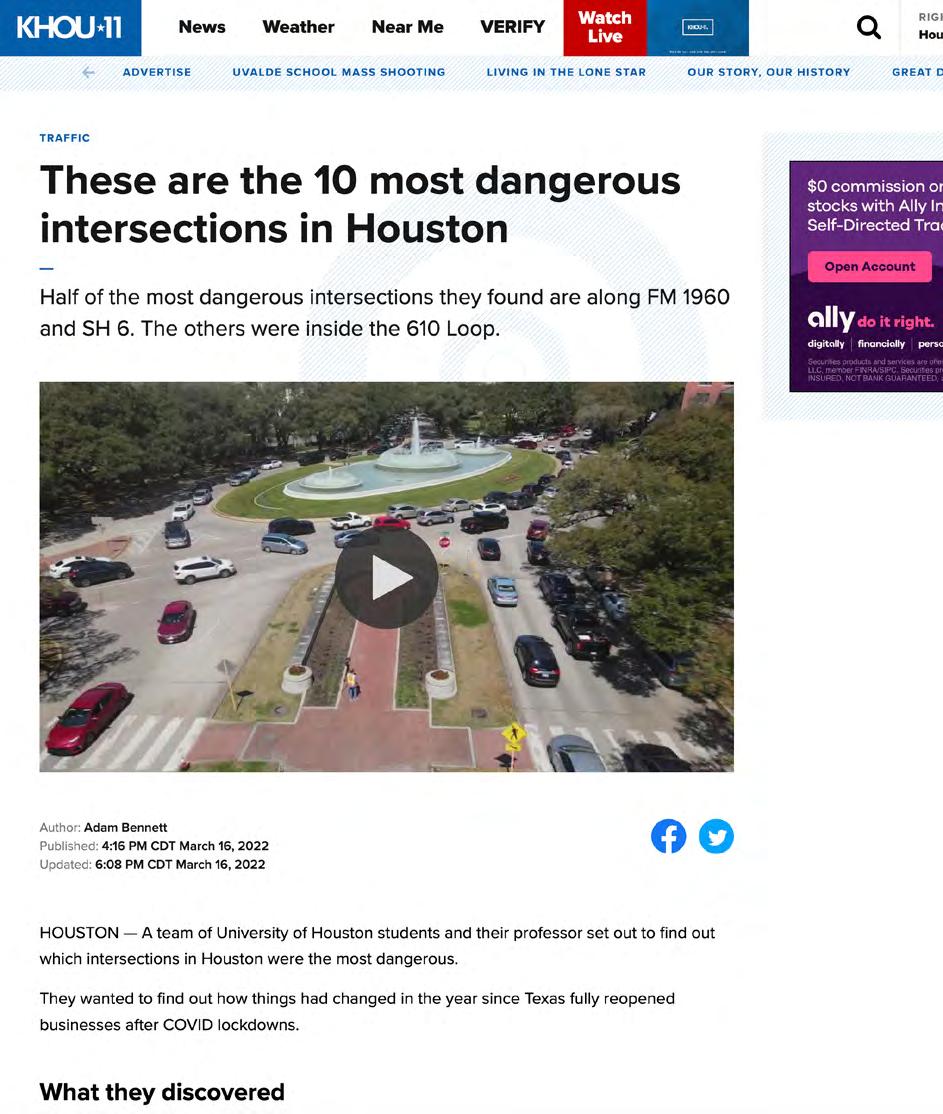
KPRC Channel 2
www.click2houston.com/news/local/2022/03/16/uh-student-study-re veals-10-most-dangerous-harris-county-intersections/?utm_source= facebook&utm_medium=social&utm_campaign=snd&utm_content=k prc2&fbclid=IwAR2nH1Y2bAm665rl0h62g1WOKodM-E89TqroKxt0fYM lOj1b-mNhfkPYNeo
University Houston
LEARN MORE ONLINE AT: www.click2houston.com/news/investigates/2022/03/11/amid-russiaukraine-conflict-kprc-2-investigates-asked-questions-and-got-answersabout-the-safety-of-american-nuclear-facilities/ | View Cullen College videos online at youtube.com/UHCullenCollege
of
Cullen College of Engineering 9

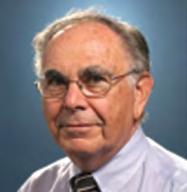



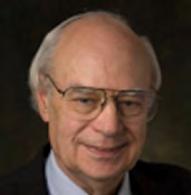
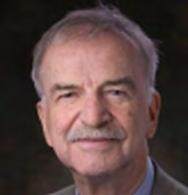



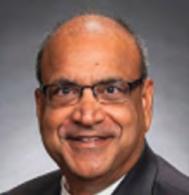





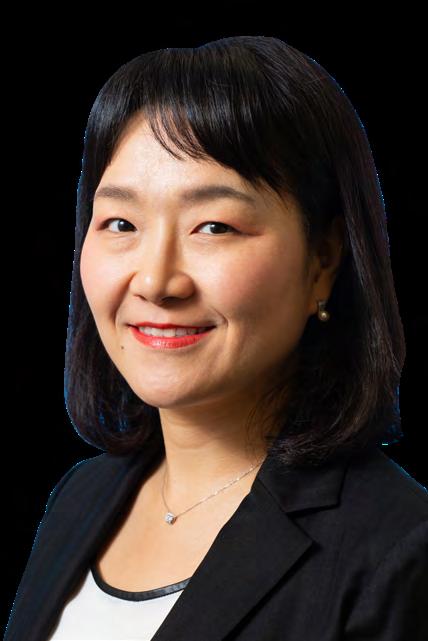
ENGINEERING SNAPSHOTS 16 National Academy of Engineering Members 1 2 3 4 5 6 8 9 10 12 13 14 1) Dan Luss; 2) Jerome Schultz; 3) James M. Symons; 4) Benton F. Baugh; 5) Charles D. Cutler; 6) John H. Lienhard; 7) Christine A. Ehlig-Economides; 8) Kaspar Willam; 9) Jamal J. Azar; 10) S.M. Farouq Ali; 11) Andrea Prosperetti; 12) Kaushik Rajashekara; 13) Ganesh Thakur; 14) Birol Dindoruk; 15) Hao Huang; 16) Pradeep Sharma 11 7 +$40M in research expenditures 120+ active laboratories UH ENGINEERING BY THE NUMBERS 146 TOTAL FACULTY 24 NSF CAREER AWARDS 1,253 graduate students 3,O23 undergraduate students+ 4,276 total students 635 B.S. 242 M.S. 90 Ph.D. DEGREES AWARDED IN 2021-22 ACADEMIC YEAR 29 research centers, institutes and consortiums received since 2010 15 16 70% six-year graduation rate TOP 20 TO 25% nationally for all public schools Newest awardee: Jinsook Roh Assistant Professor of Biomedical Engineering 80% of UH engineering undergraduates are employed within six months of graduation. = 967 TOTAL 10 PARAMETERS Fall 2022
CLIMBING THE RANKINGS
One of the key goals of the Cullen College of Engineering is to garner a reputation that matches its bolstering research and academic programs. Through the years, the college has racked up a string of accolades and recognitions. Take a look at how we measure up:

U.S. News & World Report
No. 71 graduate school in the nation for 2023
Program Rankings
Petroleum: #10
Chemical: #31
Industrial: #42
Civil: #64
Environmental: #64
Mechanical: #69
Biomedical: #74
Electrical: #82
Materials: #84
Each year, U.S. News & World Report ranks professional school programs in business, education, engineering, law, medicine and nursing, including specialties in each area. Other disciplines are ranked periodically.
The rankings are based on two types of data: expert opinions about program excellence and statistical indicators that measure the quality of a school's faculty, research and students.
Steppingblocks
Steppingblocks named the Cullen College's petroleum engineering program as No. 6 in the country for productive graduates and return on investment for 2022.
The average salary for petroleum engineers with a degree from UH was $124,630. Schlumberger, Chevron and ExxonMobil were identified as the three top employers of UH graduates, with the relevant skills of hydraulic fracturing, petrophysics and formation evaluation.
The Princeton Review
The Princeton Review routinely lists the University of Houston highly for multiple criteria. Most recently, the University of Houston was recognized for the following:
Ranked #44 – Top 50 Best Value Colleges (Public Schools) - rated for return on investment.
Top 50 Colleges that Create Futures – schools that “empower students to discover practical applications for their talents and interests through experiences that complement their classes and coursework.”
Forbes.com
According to Forbes.com, the University of Houston maintains the following disctinctions:
Top 50 Public College
Ranked #80 for research universities
COLLEGE NEWS
#71 #6 #44 TOP 50 University of Houston Cullen College of Engineering 11
BY STEPHEN GREENWELL
A million-dollar research project between the Cullen College of Engineering at the University of Houston, Shell and TotalEner gies was extended with another $500,000 grant from the two industry companies.
The initial $1 million research award, “In jector Experiments in Sand Pack with 3-D Confining Stresses,” ran from October 2019 through September 2021. The exten sion funded the project through Septem ber 2022.
According to the project summary, “To gain new insights and improve performance of injectors, we propose experiments to study the design factors of wellbore con

figurations, quality of injection fluids, in jection conditions, and water hammer. The proposal uses the cubic cell, sand pack injector with 3-D confining stresses. Tests will study the effects of water hammer and water quality on injectivity for vertical and horizontal wellbores and in matrix and fracturing injection conditions.”
The PI for the project has been George K. Wong, Ph.D., an associate professor in the Petroleum Engineering Department. Lori Hathon, Ph.D., an assistant professor in the same department, is a co-PI on the project. The project also involves inter-uni versity collaboration between UH and the University of Illinois at Chicago's Depart

ment of Civil, Materials and Environmental Engineering. UIC serves as the project's subcontractor.
Wong worked for Shell for more than 30 years before joining the faculty of UH, and he attributed that experience as one rea son why this project came together.
“For many years, Shell alone has been working with UIC, and I served as Shell’s technical lead,” he said. “After I left Shell and joined UH in 2016, Shell continued the project with UIC. Knowing the capability and potential of UIC’s lab equipment, I developed and created this new research topic, engaged TotalEnergies as a new PROJECT
 George Wong
Lori Hathon
George Wong
Lori Hathon
LEAD NEWS
UH, Shell, TotalEnergies Sign $500k Extension To $1M PETROLEUM
12 PARAMETERS Fall 2022
sponsor, and brought all the parties to gether in creating this project at UH.”
Wong noted that it wasn't just his expe rience at Shell that brought the project to fruition.
“The process took a lot of listening, ne gotiation, coordination and patience to get the project approved, a journey of more than one year. I’d like to believe my technical competency and reputa tion, established in the industry, played a role in gaining confidence from all participants and ultimately leading this project as the PI.”
Despite a six-month lab shutdown be cause of the pandemic in 2020, Wong said the collaboration, communication and coordination between the project's partners and sponsors led to the exten sion.
“The project participants devoted extra effort in overcoming and completing the project’s deliverables on schedule,” he said. “We have treated the project’s sponsors as technical partners, and re spected and valued their contributions.
I believe our sponsors recognize the unique value and potential of our ex perimental results. I take great pride in receiving a $1.5 million project from private industry for UH, and raising the research visibility of our Petroleum En gineering Department.”

Going forward and after discussions with Shell and TotalEnergies, Wong said there would be an emphasis on modi fying and extending testing equipment to address other injection impairment problems faced by industry.
“Our sponsors recognize the impor tance of physical testing in generating new insights in the mechanisms of in jection impairment,” he said. “This is an area of increasing interests in car bon storage and water disposal wells.
At UH, myself, Dr. Hathon, one Ph.D. candidate and one M.S. student are contributing to this project.”
Understanding How DENDRITES FORM IN BATTERIES
BY KARN DHINGRA
As the world lessens its dependence on fossil fuels, industries and manufactur ers are turning to lithium-ion batteries to power the machines that make modern life possible. These batteries power elec tric vehicles, mobile phones, drones, vac uum cleaning robots and other machines and will be an essential component to the energy transition.
But there’s a problem with lithium-ion bat teries: as they age and are charged, they develop dendrites. A research team from the University of Houston is trying to solve the dendrite problem by investigating how these structures grow on batteries.
Dendrites are spiky structures that accu mulate on the batteries’ anodes. These structures reduce the life of the batter ies, hinder their ability to hold a charge and can short-circuit machines potentially causing safety hazards like battery fires.
“By understanding how dendrites grow on batteries, we can identify chemical and physical solutions to prevent the growth of dendrites, which is necessary to devel op the next generation of batteries,” said Xiaonan Shan, assistant professor of elec trical and computer engineering at UH’s Cullen College of Engineering.
Shan and his team have developed a “nov el in-situ” 3D microscopy to image and study the localized electrochemical envi ronments and understand where dendrites start forming in batteries. Using the 3D
microscope, small cameras and other com puter imaging technology, Shan and his team were able to geometrically map out how a battery initially develops dendrites.
The findings were recently published in the journal Advanced Energy Materials.
“This is significant because most battery researchers traditionally use electrochem ical measurements to measure the entire surface or interior battery, so they don't know what happens inside the battery,” said Shan, who is a corresponding author on the paper. Electrical and computer engi neering graduate student Guangxia Feng is the lead author.
Most battery companies focus on the ma terials part of developing batteries, so new materials emphasize performance, he add ed.
“With this process, manufacturers can the oretically make better performing batter ies by focusing on the structural design of batteries that discourages the growth of dendrites,” Shan noted. "And in the next step, we will use this technique to design highly efficient Zn (zinc-carbon) batteries."
Authors joining Shan and Feng on the paper are Jiaming Guo, Yaping Shi, Xiaoliang, Xu Yang and David Mayerich, all of the UH Department of Electrical and Computer Engineering; and Huajun Tian, Zho Li and Yang Yang, from the University of Central Florida.
ENERGY
University of Houston Cullen College of Engineering 13
DEVELOPING CLEAN ENERGY TECHNOLOGIES

Funding To Strengthen Nation’s Advanced Energy Enterprise
BY KARN DHINGRA
University of Houston researchers have received $4.4 million from the U.S. Department of Energy’s Advanced Research Projects Agency-En ergy (ARPA-E) for two projects developed in the Cullen College of En gineering and Texas Center for Superconductivity at the University of Houston (TcSUH).
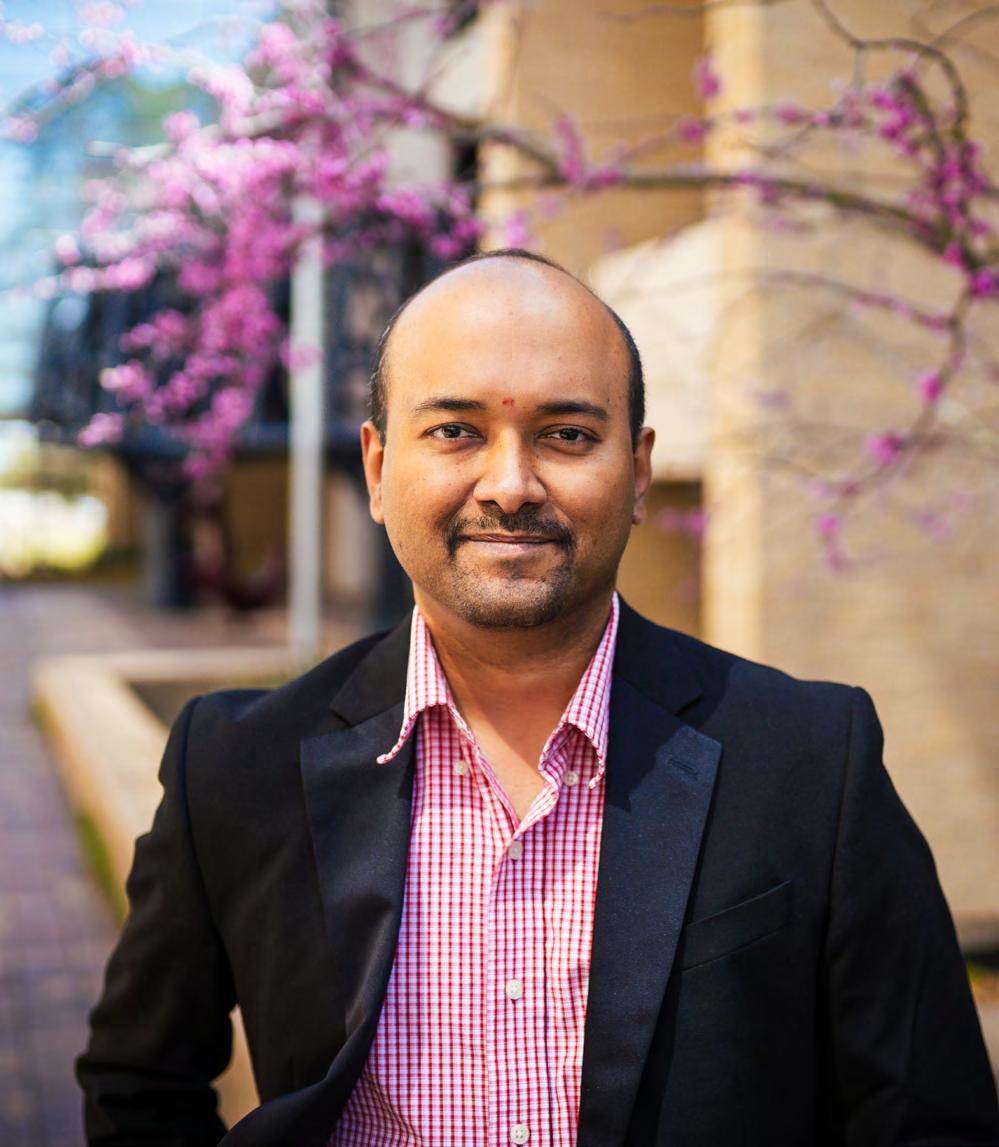
The funding is part of the ARPA-E OPEN 2021 program, which prior itizes financing technologies that support novel approaches to clean energy challenges. The University’s two projects were among 68 from across the United States that were awarded grants totaling $175 mil lion.
Cullen College of Engineering Professor of Electrical and Computer En gineering Yan Yao and his research team were awarded $3.4 million to develop a lithium and transition metal-free battery with high-energy and fast charging capabilities.
“Given growing market pressures in lithium and transition metals, this alternative technology could enhance the nation’s energy supply chain security,” Yao said. “Our team wants to advance this technology on multiple fronts including electrode material and electrolyte optimi zation, cycle life extension, practical cell design, and scaling-up mate rial production and cell fabrication.” Yao is also Principal Investigator
Harish Krishnamoorthy
LEAD NEWS
14 PARAMETERS Fall 2022
ENERGY
with the Texas Center for Superconductivi ty at the University of Houston.
Yao’s battery uses magnesium anodes in stead of lithium and organic materials in place of transition metal-based cathodes. The battery provides a transportation ener gy storage solution that could be charged quickly and comparable to state-of-the-art lithium-ion batteries.
“We have assembled a team that has an exceptionally strong track record to devel op this technology, spanning from innova tive materials chemistry, battery technol ogies, scaling up and commercialization,” Yao added. “The team comprises mem bers from Toyota Research Institute North America, Twelfth Vertex, and LiBeyond. LiBeyond is a spin-off from the University of Houston, co-founded by myself and Dr. Yanliang Liang.”
Cullen College Assistant Professor of Elec trical and Computer Engineering Harish Krishnamoorthy and his team received a $1 million grant to build gallium ni tride-based miniaturized pulsed power system architecture for mission critical applications. In the near term, Krishna moorthy’s project will have a health care application. His team will build a bat tery-operated handheld nuclear magnetic resonance device for lab use or to perform mobile magnetic resonance imaging (MRI)
measurements. Researchers from Har vard University and Schlumberger will be sub-recipients of the grant. Krishnamoor thy’s colleague in UH’s electrical and com puter engineering department, Professor Kaushik Rajashekara is a co-project in vestigator on the grant.
“In the long run, this new technology will improve the converter system’s power density, efficiency, and operational life across pulsed power applications such as healthcare tech (e.g., MRI) and water puri
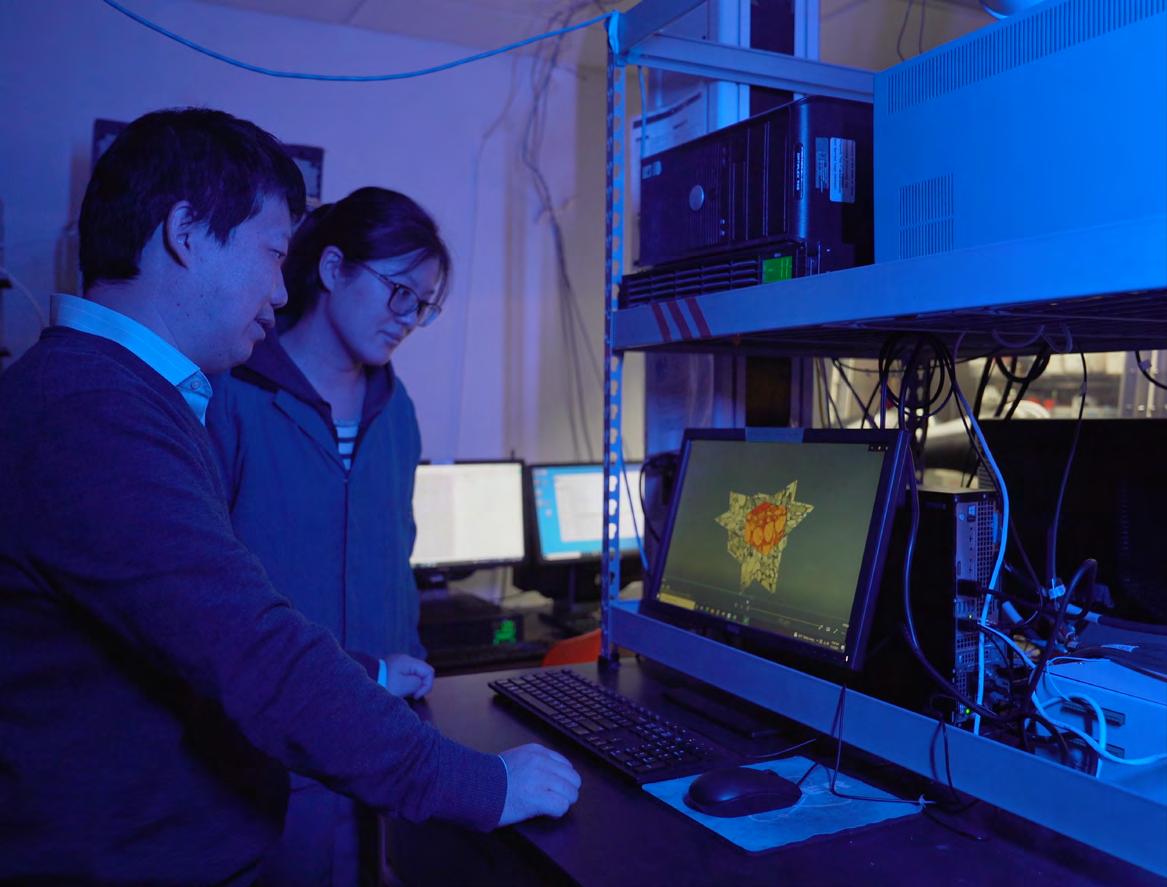

fication,” Krishnamoorthy said. “The min iaturized size of the system will also dis ruptively reduce the cost of downhole well logging tools used in fossil and geothermal energy production.”
The DOE said these investments support President Biden’s climate goals to increase production of domestic clean energy tech nology, strengthen the nation’s energy se curity, and uplift the economy by creating good-paying jobs.
“Universities, companies, and our nation al labs are doubling down on advancing clean energy technology innovation and manufacturing in America to deliver criti cal energy solutions from renewables from electric vehicles to fusion energy to tack le the climate crisis,” said U.S. Secretary of Energy Jennifer M. Granholm. “DOE’s investments show our commitment to empowering innovators to develop bold plans to help America achieve net-zero emissions by 2050, create clean energy good-paying jobs, and strengthen our en ergy independence.”
Since its founding in 2009, ARPA-E has provided $2.93 billion in R&D funding, and ARPA-E projects have attracted more than $7.6 billion in private sector follow-on funding to commercialize clean energy technologies and create sustainable clean energy jobs.
DOE’s investments show our commitment to empowering innovators to develop bold plans to help America achieve netzero emissions by 2050.
- JENNIFER M. GRANHOLM, U.S. SECRETARY OF ENERGY
Yan Yao and research students working to develop clean energy technologies in the lab.
University of Houston Cullen College of Engineering 15
Powering Hand-Held MACHINES
BY KARN DHINGRA
Pulsed power systems accumulate and store large amounts of energy for a certain period of time to be released instanta neously later.
The development of these systems is deeply intertwined with the nuclear age. In the mid-20th century, pulsed power sys tems were also used to create other mili tary weapons, such as radar systems and rail guns.
As the 20th century progressed, pulsed power systems were key to the creation of x-ray machines, then MRI machines and Nuclear Magnetic Resonance (NMR)

based tools for fossil fuel production.
Now researchers at the University of Houston, led by Cullen College Assistant Professor of Electrical and Computer En gineering, Harish Krishnamoorthy, are working to develop the next generation of miniaturized pulsed power systems.

In a research paper published in IEEE Transactions on Industrial Electronics, they propose creating a mini-pulsed power sys tem that can shrink the system’s energy storage components, such as capacitors, and deliver an immediate surge of power. The paper demonstrated that the energy storage elements can be reduced to below one-tenth the size of conventional pulsed power systems used on critical applica tions such as radar.
The architecture of their new pulsed pow er system proved so compelling that the U.S. Department of Energy’s Advanced Research Projects Agency-Energy (AR PA-E) recently awarded them a $1 million grant to build their gallium nitride (GaN)based miniaturized pulsed power system. Krishnamoorthy’s team will work with researchers from Harvard University and Schlumberger, who are sub-recipients of the grant.
“Initially we’ll make a compact pulsed power supply for extreme environment fluid characterization that can disruptive ly reduce the cost of downhole well log ging tools used in fossil and geothermal energy production. This will be followed by a miniaturized converter suitable for mobile hand-held MRI machines. Howev er, we think that we can extend our tech nology to make small water-purification systems, pulsed laser systems and pulsed electro-magnetic radiation sources,” said Krishnamoorthy. Doctoral student Yu Yao is the paper’s lead author.
“We’re essentially creating a small high-density energy storage machine that will help with reducing the space these machines use, which will save hundreds of thousands of dollars in material costs and improve their reliability,” Krishnamoorthy added.
UH researchers are working to develop the next generation of miniaturized pulsed power systems.
LEAD NEWS
MRI
16 PARAMETERS Fall 2022
PRACTICAL PARADOX:
Investigating Shale Reservoirs As A Substantial Lithium Source
BY KARN DHINGRA
One of the keys to a successful energy transi tion will be enough lithium to make the lithi um-ion batteries needed for electric vehicles, energy storage projects and other energy-ef ficient devices that will power the low carbon future of the world.
While there might not be a shortage of lithi um available in the world, there is currently a shortage of lithium available in the global marketplace and its price has fluctuated sig nificantly in recent years. At the beginning of this year, lithium from China, one of the major countries supplying lithium globally, was priced at $40,000 per ton. Compare that to early 2020 when Chinese lithium was just $6,000 per ton at the start of the COVID-19 pandemic. Currently, lithium on the spot markets is trading at $70,000 a ton.
The shortage can be attributed to a few factors, including supply chain bottlenecks caused by the pandemic and unstable in ternational affairs, increased demand from businesses, along with governments hesitant to green light lithium mines because of the environmental costs.
That’s where the research of Kyung Jae Lee, an Assistant Professor of Petroleum Engi neering at the University of Houston’s Cullen College of Engineering comes into play. In a paper published in Energy Reports, Lee lays

out the potential of petroleum-based rock brines as a new source of lithium.
Through her research of Pennsylvania’s Mar cellus Shale play, Lee found that highly con centrated lithium was found in the produced water (water produced as a byproduct during the extraction of oil and natural gas) along with produced natural gas and oil.
“We found lithium in the petroleum-based rock brines, which opens new pathways to address the shale plays as a substantial source of lithium, given that they are ubiqui tous in the U.S.,” Lee said.
She is working with a Pennsylvania-based lithium processing company that is purchas ing the produced water from the oil and gas companies operating in Marcellus Shale and extracting lithium from it.
“The U.S. has only one active brine mine to produce lithium so there’s a push to get criti cal minerals like lithium from unconventional or existing sources, that’s what we’re trying to figure out, so it’s timely research,” Lee said.
As a petroleum engineer, Lee is concerned about climate change and wants to use her academic and professional background to help with the energy transition.
“Multifaceted efforts should be made for the clean energy transition to mitigate the impact of climate change,” she said. “We want to use our knowledge of petroleum engineering to contribute to the clean energy transition by providing creative new solutions such as the one that we are pursuing in our research— harnessing critical minerals from natural pe troleum systems.”
It might seem paradoxi cal, but producing oil and gas from shale reservoirs could actually help the world transition to clean er energy sources.
Students conduct work in Kyung Jae Lee's lab.
ENERGY
University of Houston Cullen College of Engineering 17
STUDYING SOOT
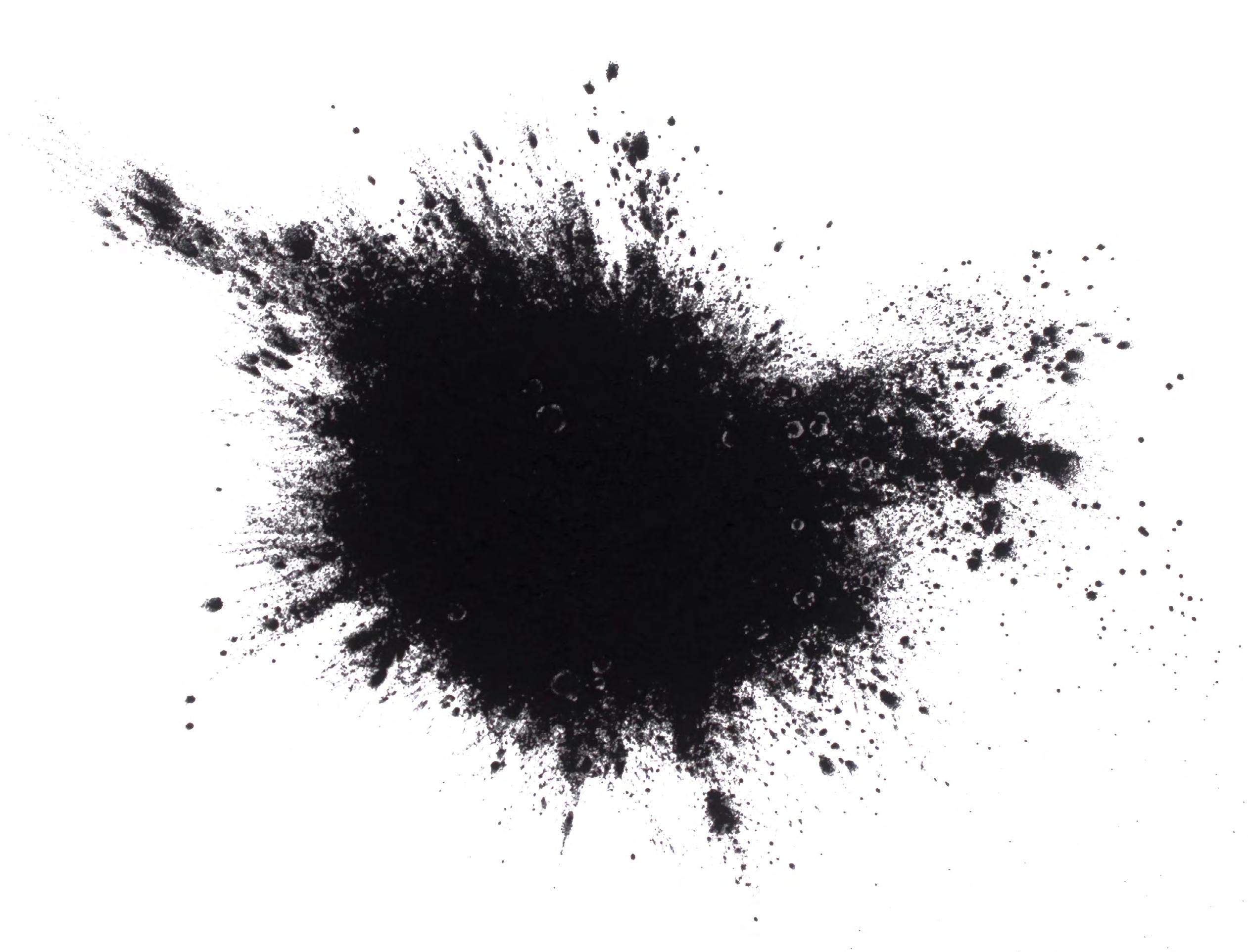
Can Pollutants Help With Energy Transition?
BY KARN DHINGRA
LEAD NEWS
18 PARAMETERS Fall 2022
Turning environmental pollutants into re newable solar energy while reducing car bon emissions may seem like something plucked out of a science-fiction film, but researchers from the University of Hous ton and Mexico’s Universidad Intercultur al Indígena de Michoacán are working to make that proposition a reality.
One of the researchers is Francisco Ro bles-Hernández, UH professor of me chanical engineering technology at the College of Technology with a joint appoint ment in the Electrical and Computer Engi neering Department at the Cullen College of Engineering. Another is Luis Bernardo López-Sosa, professor of engineering for energy sustainability at UIIM and doctoral graduate under Robles-Hernández at UH. They have demonstrated how soot, the byproduct of burned organic materials like biomass, carbon and hydrocarbons, can convert solar energy into heat.
The biomass extracted from burned wood in the Mexican state of Michoacán was found to be the most effective, according to the findings published in the journal, Carbon. Ultimately, the researchers used the soot to produce a paste-like coating with high solar-to-heat-conversion effi ciency.
“Our raw materials are sustainable, though are currently considered environmental pollutants. However, they are ideal for re ducing carbon footprints and can contrib ute to a true net-zero energy transition,” Robles-Hernández said.
Soot, including black carbon, are a major contributor to the polar ice caps melting, and their sequestration is of major interest to climate and energy researchers.

Robles-Hernández and López-Sosa created flat pellets and coatings made from soot from burned wood, pet coke and other hy drocarbons. Their investigation found soot derived from biomass, in most cases, had better properties to absorb solar energy and convert it into heat compared to other
ENERGY
pristine carbon structures, such as fuller ene, graphene or nanotubes.
“There is no energy involved in produc ing soot because it is an abundant by product, and its circular-reutilization can only reduce carbon footprints. The cost is near-zero, which makes it cost-effective and ideal for solar to heat conversion,” said Robles-Hernández, who noted aspira tions to move toward commercialization.
To put their biomass-derived coating into action, the team engineered solar stoves that can be heated up to 400 degrees Fahrenheit. The cost to produce the stove is $150, but the new coating that powers it only costs about $1.00 per square meter to produce.
As for using this coating for large-scale ap plications, Robles-Hernández doesn’t think the solar stoves will be viable in the Unit ed States, but he does think the coating could be used in large heaters or boilers to dry large quantities of industrial products. Drying is one of the most energy-intensive and costly industrial processes.
Additionally, the use of combustion-de rived residues can be a game-changer for thermal conversion in solar stills, heaters, house heating, water purifiers and other technologies, Robles Hernández added.
“The next step for this project is to mass produce solar-to-heat convertors for food processing, ultimately, the motivation for this project is to benefit the environ ment, using carbon waste or byproducts for household and industrial processes,” López-Sosa added. “The language of the local communities where I work is Purepé cha. In Purepécha we say ‘Jaroajperakua’ which can be translated as climate change prevention or awareness.”
There is no energy involved in producing soot because it is an abundant byproduct, and its circularreutilization can only reduce carbon footprints.
- JENNIFER M. GRANHOLM, U.S. SECRETARY OF ENERGY
University of Houston Cullen College of Engineering 19
BY SALLY STRONG
Two professors with the University of Houston's Cullen College of Engineering, with colleagues from the University of Michigan and University of New Mexico, have embarked on a road rarely traveled by researchers – exploring the unknown qualities, capabilities and secrets of fungi.
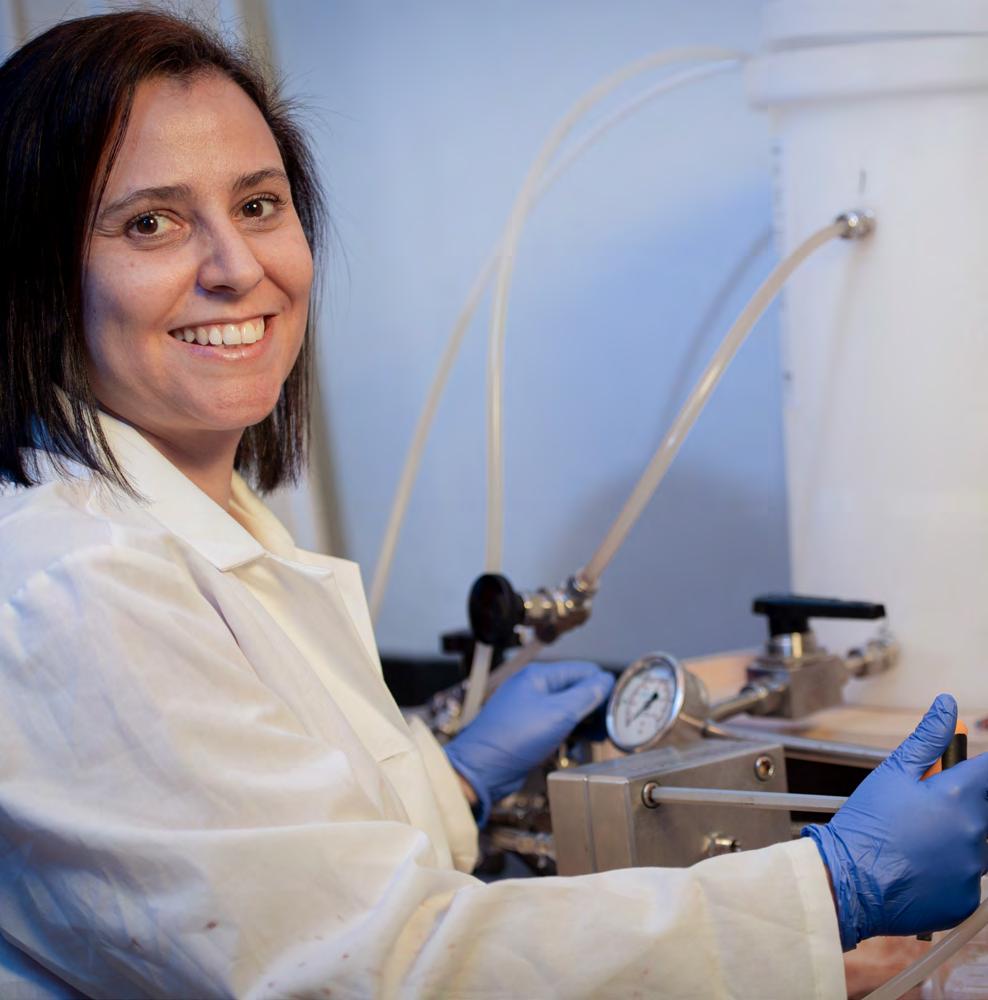

Exploring The SECRET LIVES OF FUNGI Exploring The SECRET LIVES OF FUNGI
LEAD NEWS
Debora Rodrigues 20 PARAMETERS Fall 2022
ENVIRONMENT
Just to be clear here, we are talking about fungi – a group of microorganisms that can grow everywhere. Fungi are these mysterious mushrooms that we frequent ly find in the woods and after a lot of rain. The professors and their research col leagues believe that fungal cells may hold tremendous power that science has yet to tap into, or even recognize.
“Fungi are among the least studied micro organisms. By comparison, bacteria are studied very much, so we know a lot about them. The diversity of fungi is enormous. I started working with fungi about four years ago, and I am fascinated by what they can do,” said Debora Rodrigues, pro fessor of civil engineering and the princi pal investigator of a five-year research project funded by a $3 million grant from the National Science Foundation. Of that, $1.5 million is budgeted for UH.
Joining Rodrigues on the research team is co-principal investigator Stacey Louie, an assistant professor of civil and environ mental engineering in the UH Cullen Col lege of Engineering.

“My interest is in the chemistry side. I’ll be looking at new data on how different fun gal species interact with metals and how that interaction could be relevant to met als detoxification,” Louie said.
The projects’ other co-principal investiga tors are Gregory Bonito, associate profes sor of mycology, Michigan State Universi ty; Adam W. Brown, professor of electronic art and intermedia, Michigan State Uni versity; and José Cerrato, associate profes sor of civil, construction and environmen tal engineering, University of New Mexico.
There is still not much known about how fungi interact with other fungi and bac teria growing in, on or around their cells, and their curious potential to either avoid toxic substances or transform them into matter that is benign, potentially even helpful.
That tricky ability could make fungi a ma jor key in cleaning up water or soils pollut ed with toxic metals such as lead, mercury
and cadmium, all of which even in small amounts can harm humans. How they do this remains one of fungi’s biggest myster ies.
“Fungi excrete a lot of stuff into their sur rounding environment, basically a lot of biomolecules and enzymes. This enables them to transform metals and other con taminants in the environment,” Rodrigues explained. “In some situations, fungi actu ally uptake toxic metals. But there are ma jor questions. First, what effects do metals have on the fungal microbiome (the bac teria living inside or around the fungus)? And second, how do these bacteria also affect the metal transformation or assist in fungal tolerance to metals?”
For many years, bacteria were assumed to be the group of microorganisms most responsible for cleaning up their envi ronment. However, researchers on this project believe fungus together with their microbiome might be far better at clean ing nasty chemicals, including metals, and transform these metals in nanoparticles that can be applied in different industries.
Hence, they will be exploring further po tential benefits of fungi and their micro

biome including as part of artworks. You read that right: There is art in fungi.
That aspect is the special concentration of co-principal investigator Adam W. Brown, whose art blends art with science to show the result of human entanglement with earth’s microbiota species. Brown’s work has been exhibited around the world for more than two decades.
His challenge will be to work with these microorganisms that are the focus of this particular research and reveal something of their role in balancing the ecology.
“Those microorganisms have been on earth long before humans,” Rodrigues said. “They have been transforming every thing. We didn’t know about it, but for all those years they were transforming a soup of ions from metals that are toxic, harm ful. It’s their way of making a safe environ ment for themselves and, in the process, for us, too. I always thought bacteria were the superstars, but now I see fungi as the true superstars, and their microbiomes as their co-stars. They’re really fascinating, these little guys. They’re going to be the ones making history in the future.”
Stacey Louie and Debora Rodrigues
University of Houston Cullen College of Engineering 21
ANTARCTIC
GLACIERS
Losing Ice Faster Than Ever Documented Before
BY SALLY STRONG
In a new University of Houston study using an advanced remote imaging system known as synthetic aperture radar interferome try, three glaciers at the South Pole are being documented with levels of clarity and completeness never seen before. The new remote sensing data system is not just uncovering icy secrets from Earth’s least explored continent, it also is raising alarms about global climate risks – both present and future.

LEAD NEWS
22 PARAMETERS Fall 2022
ENVIRONMENT
Documentation of the rapid and un precedented retreat of the Pope, Smith and Kohler glaciers in West Antarctica’s Amundsen Sea Embayment is detailed in an article published in Nature Geosciences.
“Thanks to the new generation of radar satellite, we have been able in recent years to witness retreat rates faster than ever observed among glaciers around the world. That’s a warning sign that things are not settling, not stabilizing at all. This could have severe implications for the equilibrium of the entire glacier system in this area,” said radar scientist Pietro Mili llo, assistant professor of civil engineering at UH and the article’s lead author.
In this ongoing international study of data collected via the TanDEM-X and COS MO-SkyMed satellites, Milillo is joined by University of California Irvine researchers and scientists from three national space agencies: NASA, the German Aerospace Center (DLR) and the Italian Space Agency (ASI).
The research team plans to expand the sci entific understanding it gains from the rel atively small and less studied Pope, Smith and Kohler glaciers to their giant and frag ile West Antarctica neighbors, the Thwait es and Pine Island glaciers, as well as to the entire Antarctic glacier system.
“The issue here is that we found such a high retreat rate – so high that we actu ally see these three smaller glaciers could actually capture the basin from the near by Thwaites glacier, which would cause Thwaites to lose more mass,” Milillo said. “In Antarctica, glaciers don’t melt because of interaction with the sun. They melt be cause they accelerate and inject more ice into the ocean. That is one of the principal mechanisms of mass loss.”
At the southmost point of the Earth, the South Pole is in darkness most of the year. Its extreme weather means researchers can visit for only short periods of time, limiting their research. (Milillo points out Antarctica is so remote that most often
the nearest humans are astronauts or biting the earth aboard the International Space Station.)
“Radar is perfect for those applications. The beauty of radar is that it can penetrate clouds. It can look in any weather condi tion. It is also an active sensor, so we don't have to rely on the light of the sun,” he said.
“In the past, we needed to wait several years in order to accumulate enough use ful data. For that reason, we could observe only long-term trends. Now we can look at retreats on a monthly basis and can cap ture a new level of detail that will help im prove glacier models and, in turn, refine our sea level rise estimates,” Milillo said.
Among those monthly measurements, the team looks at bi-weekly elevation changes to assess retreat at a glacier’s grounding line, the boundary on the underside of a glacier where frozen land meets warmer water. The grounding line becomes espe cially vulnerable because the warm water carves out an ice shelf that starts to float and could easily break completely away.
“If all ice above floatation in Antarctica
would melt, the sea level would go up on average by 58 meters (190 feet),” Milillo said. “If the signals we are looking at are confirmed, the mass loss from Antarctica, as well as Greenland, will rise. As they rise, the sea level will increase.”
“If all these glaciers melt, the sea water could raise rapidly. With 267 million peo ple worldwide living on land less than 2 meters (6.6 feet) above sea level, an abrupt migration could result. Also, sub sidence could eventually see large struc tures sinking in vulnerable locales, includ ing Houston,” Milillo said. “That’s why people should care about this issue. Even if doesn’t affect their life, it will affect their kid’s life and their grandkid’s life.”
For now, Milillo concentrates on the near future, including NASA’s plans in 2023 to launch its NISAR satellite, designed to provide even more quantity and more fre quent data acquisitions than the current state-of-the-art synthetic aperture radar.
Also known as NASA-ISRO SAR, the new satellite will measure the changes in eco systems, dynamic surfaces and ice mass es, providing Milillo and fellow scientists a bolder picture of our changeable Earth.
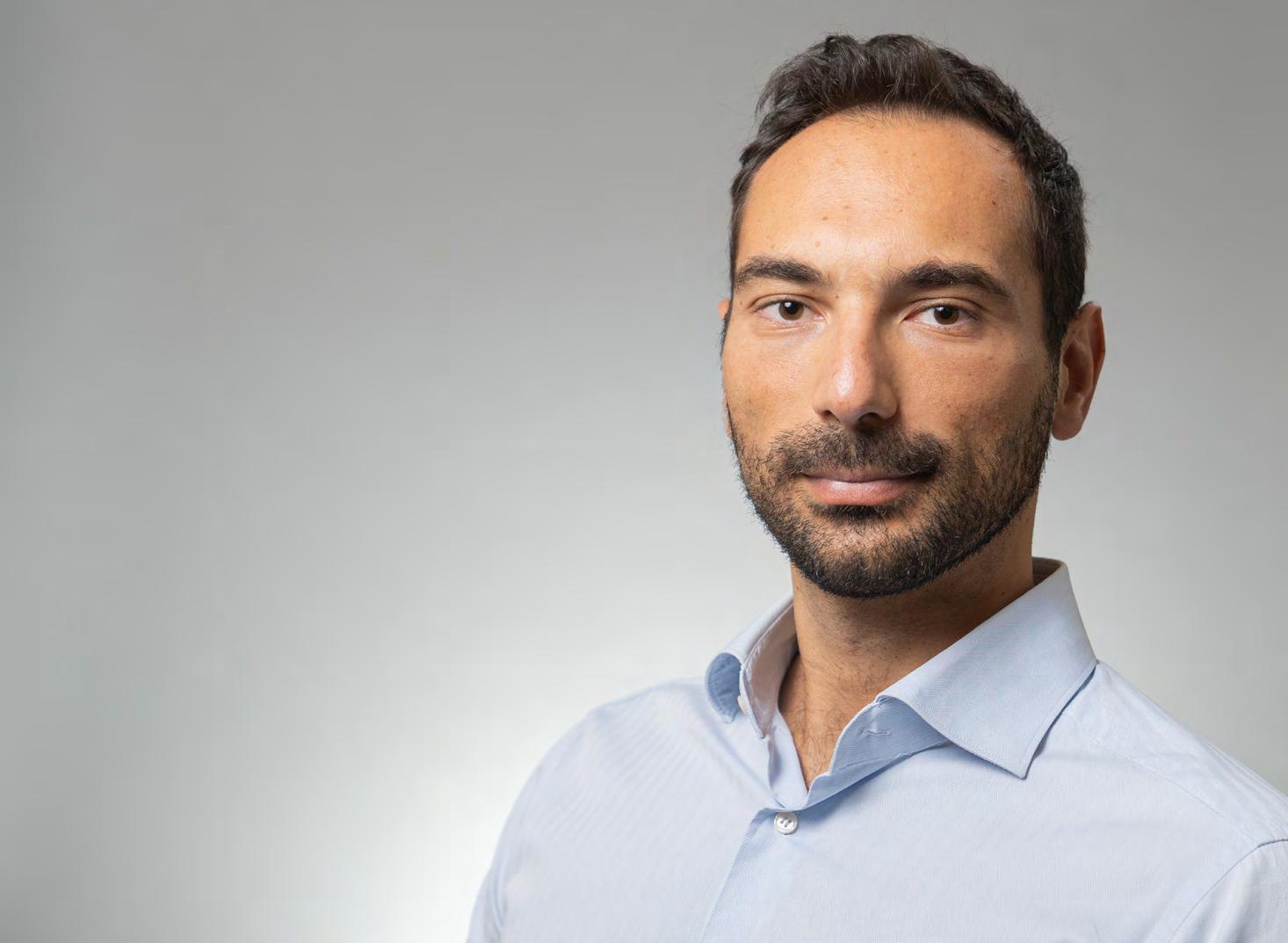
If all these glaciers melt, the sea water could raise rapidly... That’s why people should care about this issue. Even if doesn’t affect their life, it will affect their kid’s life and their grandkid’s life
- PIETRO MILILLO
University of Houston Cullen College of Engineering 23
BY LAURIE FICKMAN
Jiming Bao, professor of electrical and computer engineering at the University of Houston, has developed a new fluid that can be cut open by light and demonstrated macroscopic depression of ferrofluid, the kind of fluid that can be moved around with a magnet.
The new method of molding and deform ing water has potential applications in adaptive optics, mass transport and micro fluidics manufacturing and molding of mi cro and nanostructures. Weighty implica tions for something that can be done with a few ingredients found at home.
“New optothermocapillary fluids were created by mixing transparent lamp oil with different candle dyes. They can be cut open by sunlight and be patterned to different shapes and sizes using an ordi nary laser show projector or a common laser pointer,” reported Bao in Materials Today. “Laser driving and elevation of op totherocapillary fluids, in addition to the manipulation of different droplets on their surface, were demonstrated as an efficient controlling method and platform for opto fluidic operations.”
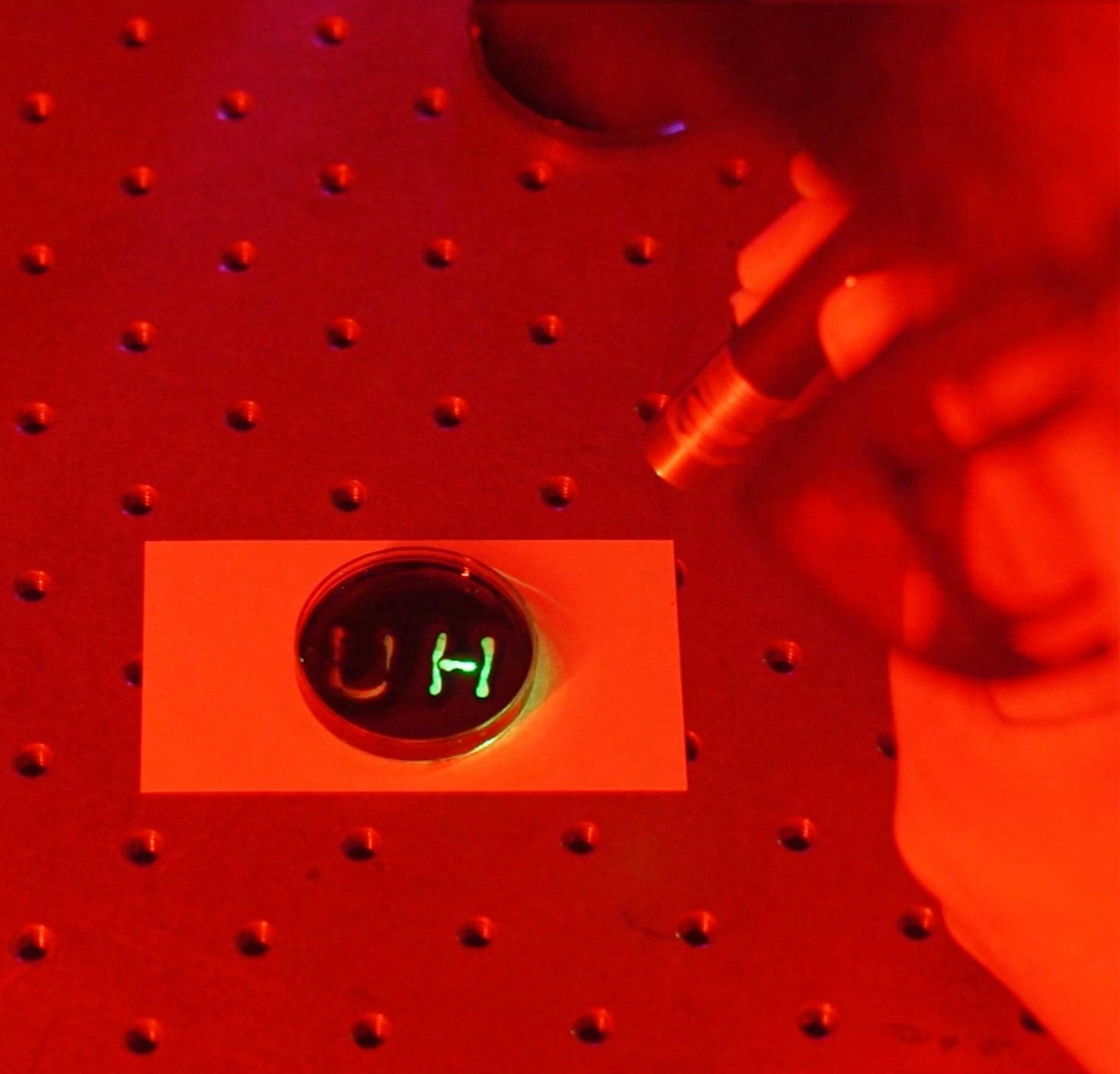
Optothermocapillary fluid refers to fluid in which the surface tension (capillary force) is strongly dependent on temperature, thus can be easily changed by lasers be cause lasers can generate a surface tem perature gradient. Bao is reporting a giant depression and rupture in optothermocap illary fluids under the illumination of laser and sunlight.
“Computational fluid dynamics models were developed to understand the surface deformation and provided desirable phys ical parameters of the fluid for maximum deformation,” said Bao. “The lasers and sunlight manipulated surface droplets and proved an efficient controlling method and platform for optofluidic operations.”
Bao began surface depression experi ments with ferrofluid because of its strong optical absorbance. Ferrofluid is a socalled “magic” liquid best known for its astonishing surface spikes generated by a magnetic field.
“Surprisingly, its surface can also be de formed by laser beams. To better under stand the deformation mechanism, we recorded the surface deformation under lasers at three different wavelengths but with the same power. Bao determined that the surface deforms more rapidly with a shorter laser wavelength.
“The fundamental understanding of light-induced giant depression and cre ation of new optothermocapillary fluids encourages the fundamental research and applications of optofluidics,” said Bao.

LEAD NEWS
A NEW FLUID THAT LIGHT CAN CUT Molding, Patterning And Driving Liquids With Light
A laser cuts water into the shape of "UH" in this demonstration in the lab of Jiming Bao in the Cullen College of Engineering. THE NEW FLUID MAY IMPACT ADAPTIVE OPTICS, MASS TRANSPORT AND MICROFLUIDICS MANUFACTURING AND MOLDING OF MICRO AND NANOSTRUCTURES. 24 PARAMETERS Fall 2022
CREATING UPWARD WATER FOUNTAINS IN DEEP WATER
Fountain Created by Lasers, Marangoni Effect is the Cause
BY LAURIE FICKMAN
A pair of University of Houston engineers has discovered that they can create up ward fountains in water by shining laser beams on the water’s surface and have published their research in the latest Ma terials Today Physics
Jiming Bao, professor of electrical and computer engineering at UH, and his post doctoral student Feng Lin, attribute the finding to a phenomenon known as the Marangoni effect, which causes convec tion and explains the behavior of water when differences in surface tension exist.
Though first described in the 1860s, the Marangoni effect is still having its way with science.
“Scientifically no one has predicted or imagined this kind of upward deformation before,” reports Bao in Materials Today Physics. “It is well known that an outward Marangoni convection from a low surface tension region will make the free surface of a liquid depressed. Here, we report that this established perception is only valid for thin liquid films. Using surface laser heat ing, we show that in deep liquids a laser beam pulls up the fluid above the free sur face generating fountains with different shapes.”
Here’s a Marangoni visual: Sprinkle a bunch of pepper into a bowl of water. Then squeeze one drop of liquid detergent (dishwashing, laundry, even a chip of soap or toothpaste) into the middle of the same bowl and watch as the pepper disburses,
scattering quickly to the sides of the bowl. That simple experiment illustrates the Ma rangoni effect, which appears in many ap plications of fluid dynamics.
In the most recent incarnation, the Maran goni effect’s laser-induced liquid fountains have potential to impact applications in volving liquids or soft matters such as li thography and 3D printing, heat transfer and mass transport, crystal growth and alloy welding, dynamic grating and spa tial light modulation and microfluidics and adaptive optics.

Inspired by his previous work, the success ful simulation of inward surface depres sion in a shallow liquid, Bao increased the depth of ferrofluid in the current simula tion. Ferrofluid is a so-called “magic” liq uid and is best known for its astonishing surface spikes generated by a magnet.
“Understanding the distinct surface de formation in liquids with different depths helps unravel the dynamics of the surface deformation process,” said Bao.
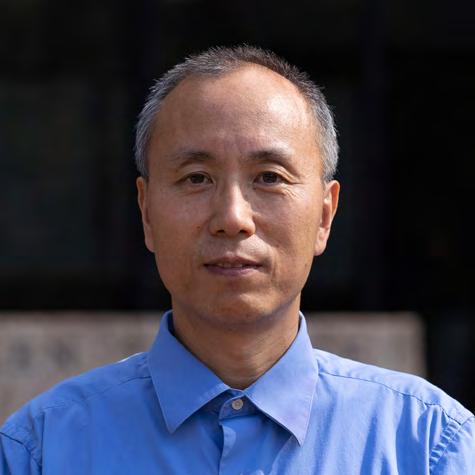
Bao used a low-power (<1 W) continu ous-wave laser beam to create a non-uni form surface temperature field to induce the Marangoni effect. To understand the distinct deformations between deep and shallow liquids, he varied the liquid layer thickness while keeping the laser beam the same.
The laser fountains and the depth-depen dent transition from surface indentation
to laser fountain have never been report ed in literature, probably because they are not anticipated by any existing theory.
“We emphasize that there have been nu merous attempts to understand the Ma rangoni flow-driven surface deformation, but no existing theory can predict the de formation patterns of a liquid with an arbi trary depth in a straightforward manner,” said Bao.
UNDERSTANDING THE DISTINCT SURFACE DEFORMATION IN LIQUIDS WITH DIFFERENT DEPTHS HELPS UNRAVEL THE DYNAMICS OF THE SURFACE DEFORMATION PROCESS.
- JIMING BAO
FUNDAMENTALS
University of Houston Cullen College of Engineering 25
PUSHING THE LIMIT
Of When Water Will Freeze
BY LAURIE FICKMAN
Though it is one of the great mysteries of science, the transformation of water into ice often escapes people's minds as it is just assumed that’s what happens. But how and why it happens is the subject of intense scru tiny by ice scientists like Hadi Ghasemi, Cullen Associ ate Professor of Mechanical Engineering at the Univer sity of Houston.
In order to watch the process of crystallization of water into ice at the molecular level, Ghasemi is reporting the

The limit of freezing temperature of a water droplet is -38 C. That is, any water droplet will freeze at some temperature between 0 C to -38 C. Below this temperature, freezing has been inevitable, until now.
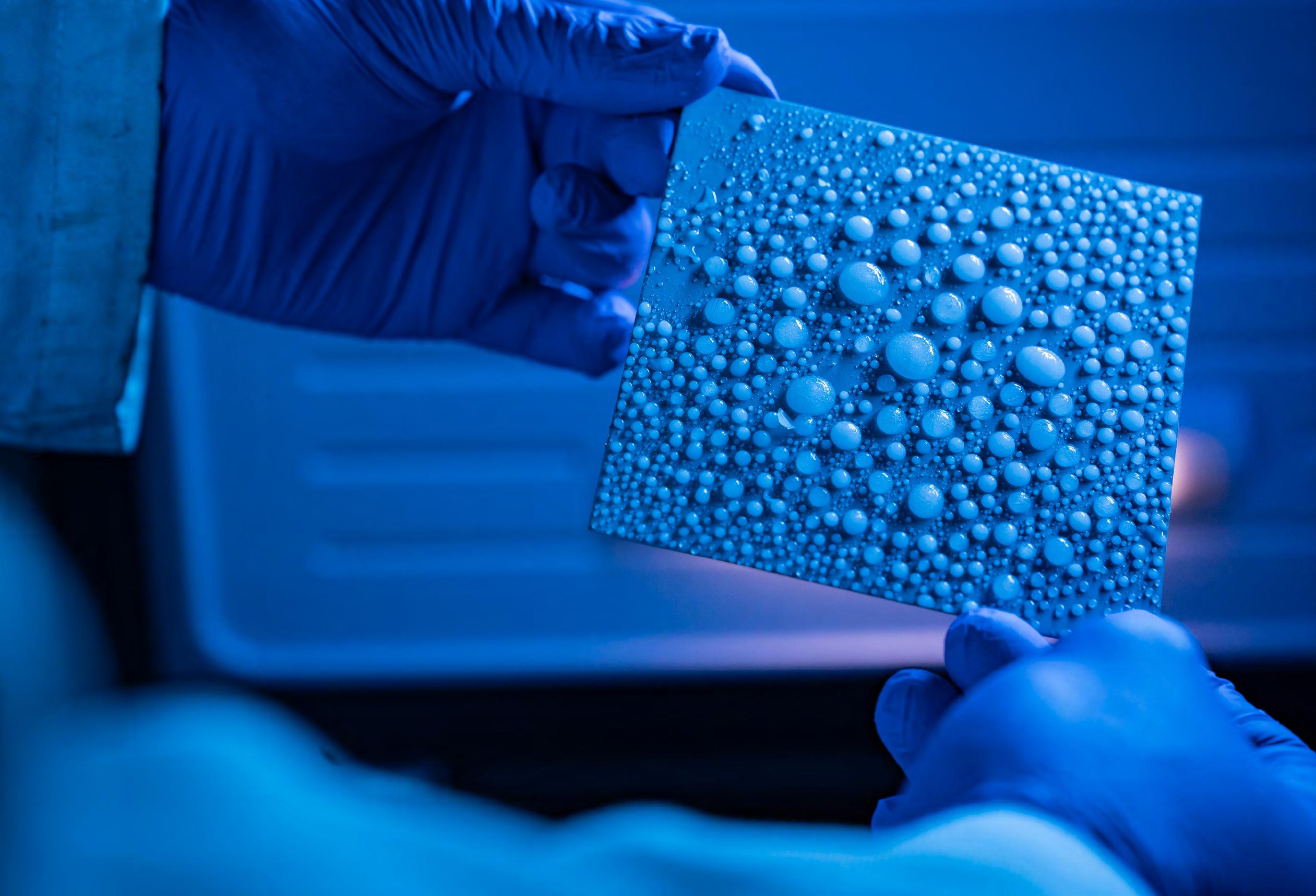
LEAD NEWS 26 PARAMETERS Fall 2022
best look yet at the process: water-ice phase transformation down to 2 nm (nanometers) in diameter.
Then when Ghasemi examined these tiny particles, he made another discovery. He could break the limit of when water freezes and maintain the tiny droplets as liquid by putting them in contact with soft interfaces, like gels or lipids.
“We found that if a water droplet is in con tact with a soft interface, freezing tempera ture could be significantly lower than hard surfaces. Also, a few-nanometer water drop let could avoid freezing down to -44 C if it is in contact with a soft interface,” Ghasemi reports in Nature.
The limit of freezing temperature of a water droplet is -38 C. That is, any water droplet will freeze at some temperature between 0 C to -38 C. Below this temperature, freezing has been inevitable, until now.
The process of freezing such a tiny water droplet plays a critical role in the survival
FUNDAMENTALS
of animals in cold environments as a frozen water droplet inside a cell leads to the rup ture of the cell and death. The process also plays a key role in climate prediction, cloud conditions, cryopreservation of organs and technologies exposed to icing conditions such as aircraft and wind turbines.
“Experimental probing of freezing tem perature of few nanometer water droplets has been an unresolved challenge. Here, through newly developed metrologies, we have been able to probe freezing of water droplets from micron scale down to 2 nm scale,” said Ghasemi.
Previously Ghasemi created an ice-repelling material for aerospace applications using a new concept called stress localization. His current findings contribute to a greater un derstanding of natural phenomena and pro vide guidelines for further design of anti-ic ing systems for aviation, wind energy and infrastructures and even cryopreservation systems.

Experimental probing of freezing temperature of few nanometer water droplets has been an unresolved challenge.
HADI GHASEMI
A student researcher conducts work in the lab of Hadi Ghasemi.
University of Houston Cullen College of Engineering 27
How The Nervous System CONTROLS ORGANS
BY LAURIE FICKMAN
An international team of researchers, led by University of Houston Cullen Endowed Professor of Biomedical Engineering Ma rio Romero-Ortega, has progressed electroceutical research for treatment of diseases including rheumatoid arthritis, colitis and sepsis. Romero-Ortega part nered with the ARC Centre of Excellence for Electromaterials Science (ACES) at the University of Wollongong in Australia.
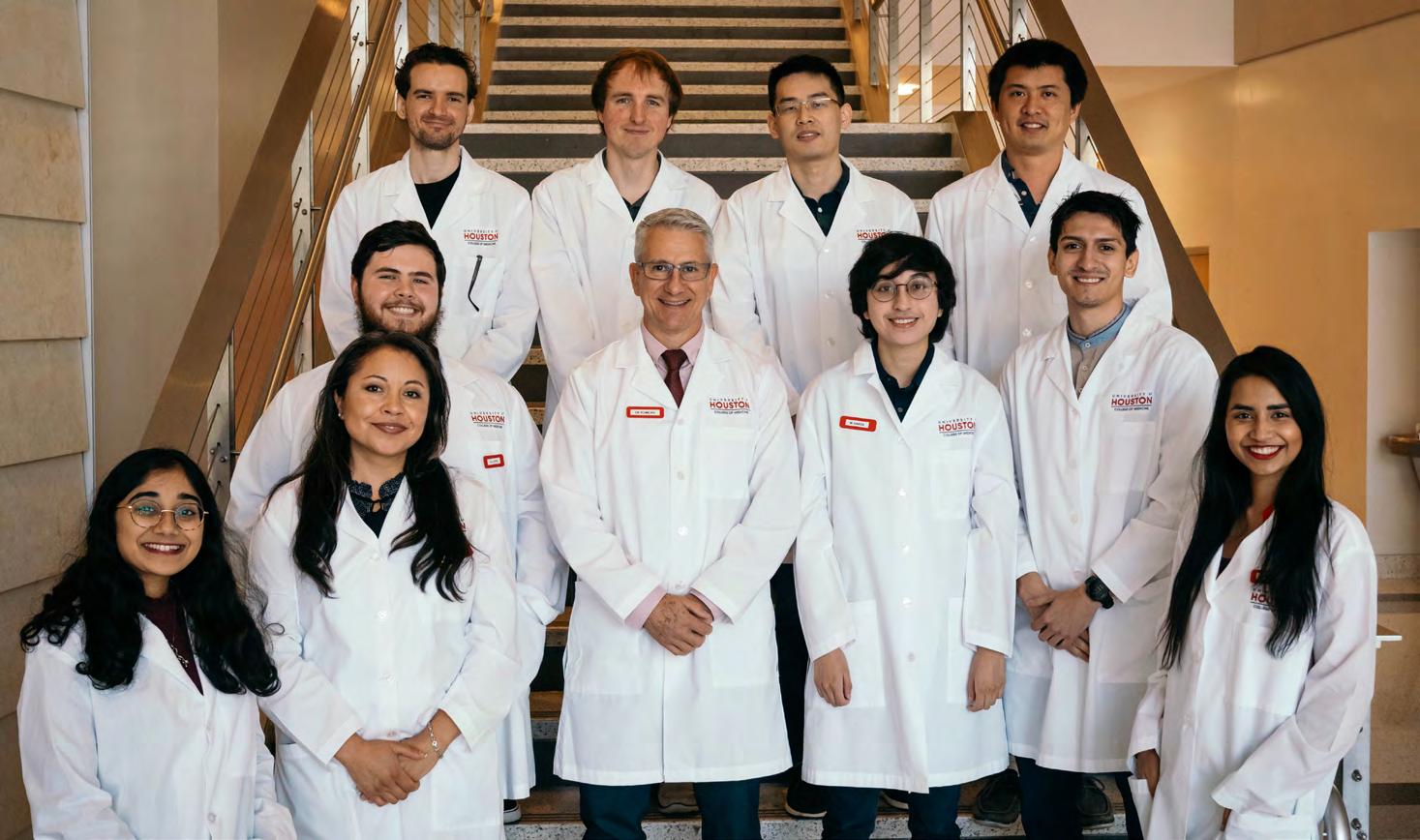
The field of electroceuticals, where electri cal stimulation is used to modify biological functions, has the potential to treat med ical conditions with minimal invasion and side effects.

Published in the Nature Journal of Commu nications Biology, the work builds on previ ous studies when the team introduced the sutrode to the world just over a year ago. This graphene-based electrode is an elec trical stimulation device that could replace the use of pharmaceuticals to treat a range of medical conditions. The sutrode, creat ed using the fabrication technique known as fiber wet spinning, combines the elec trical properties of an electrode with the mechanical properties of a suture.
“The flexibility and superb sensitivity of the sutrode is allowing us to expand our understanding of how the nervous system controls main body organs, a critical step towards developing advanced therapies in bioelectronic medicines,” reports Rome ro-Ortega. “Our collaborative work uncov ered that the spleen is controlled by differ ent terminal nerves, and that the sutrode can be used to control them, increasing the precision in which the function of this organ can be modulated.”
co-author on the paper, said the sutrode can be integrated with delicate neural sys tems to monitor neural activity.
“This work has widespread implications for regulating the function of the spleen, particularly the efficient regulation of the immune response for electroceutical treat ment of range of diseases,” said Wallace. “We have highlighted the ongoing need to develop systems with increased fideli ty and spatial resolution. This will not only
bring practical applications to the fore front but will enable the unattainable ex ploration of the human neural system.”
The work also reveals the ability to simul taneously interrogate the four individual neural inputs into the spleen. This new technical and biological achievement will not only bring about practical applications, but also enable a previously unattainable exploration of the human neural system.
ACES director professor Gordon Wallace, a
Top: Equipment in the lab of Mario Romero-Ortega. Bottom: Mario Romeo-Ortega (bottom-center) and his team of student researchers.
LEAD NEWS
28 PARAMETERS Fall 2022
Mapping The Complexity Of T Cells To IMPROVE IMMUNOTHERAPY
BY LAURIE FICKMAN
It is not an exaggeration to say that im munotherapy has revolutionized cancer treatment. Nor is it boastful to say Univer sity of Houston M.D. Anderson Professor of chemical and biomolecular engineering Navin Varadarajan intends to make it better.

Immunotherapy works by harnessing the power of the immune system and its abili ty to recognize and eliminate cancer cells. Much of that power resides within T cells, a type of white blood cell which protects the body from infection and clears out mutant cells when recognized by T cell receptors. In fact, genetically engineering
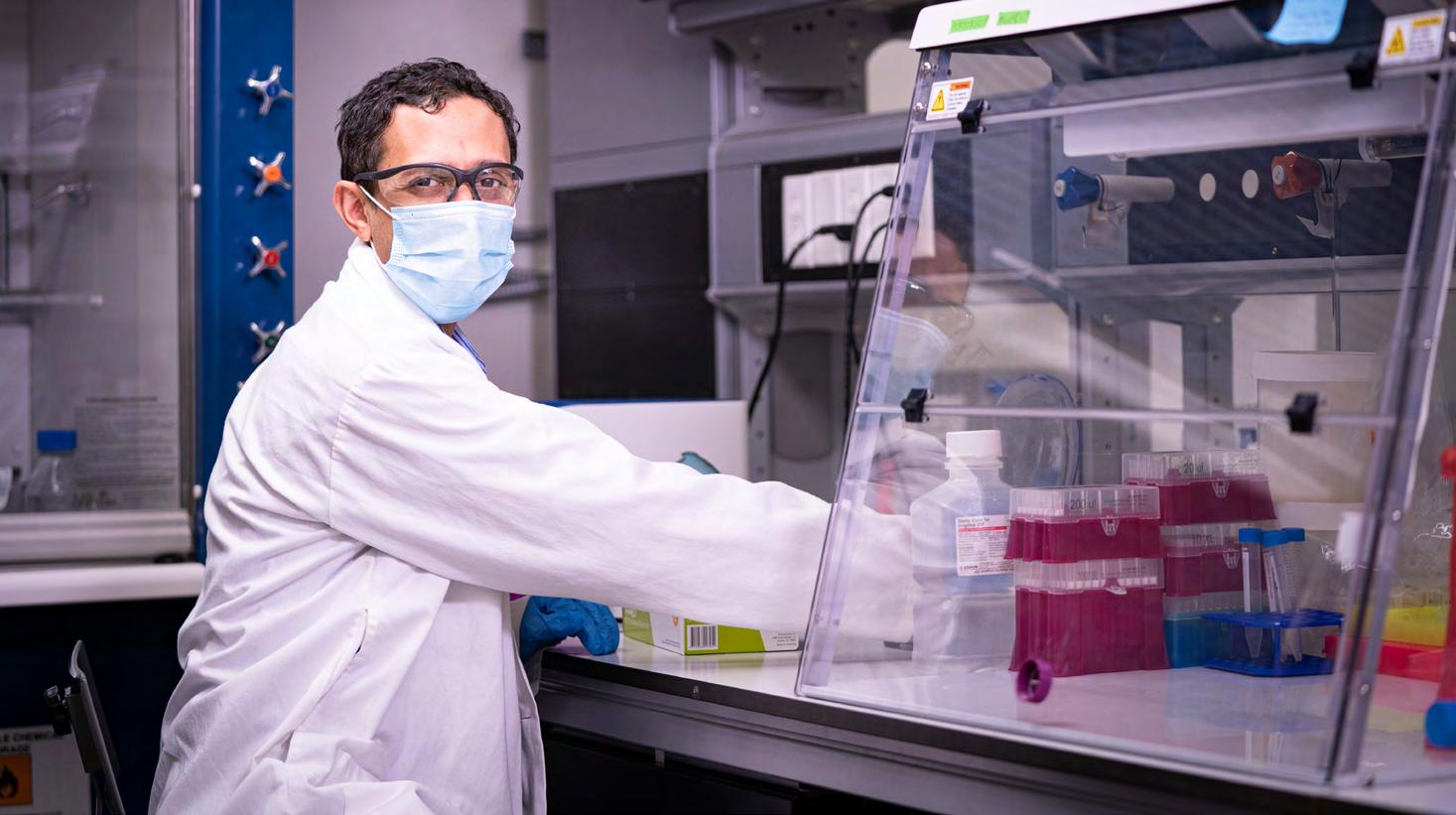
T cells for redirecting immune responses has recently received approval from the Food and Drug Administration. Although this Adoptive Cell Therapy (ACT), based on infusing in vitro expanded T cells bearing either T cell receptors or chimeric antigen receptors has demonstrated dramatic and durable responses, patient responses vary widely.
Recent data indicate that variability in the manufactured T cell products may be the primary determinant of clinical success.
“Since cellular infusion products are a het
Medical Sciences to develop and validate what he calls Multiscale Intelligent Con vergence (MusIC). MusIC will integrate advances in molecular profiling, dynamic cellular imaging and artificial intelligence (AI) to offer unprecedented insights into the function of immune cells being pre pared for immunotherapy.
Varadarajan’s collaborators on the project include Badri Roysam, Hugh Roy and Lil lie Cranz Cullen University Professor and Chair of electrical and computer engineer ing at UH; Hien Van Nguyen, associate professor of electrical and computer engi neering at UH; and Sattva Neelapu, a med ical doctor at MD Anderson Cancer Center.
erogeneous mixture of cells, mapping the complexity of the population requires the ability to identify the function and molec ular profiles of cells at single-cell resolu tion,” said Varadarajan. “Our objective is to develop and rigorously validate a trans formative technology that integrates cellu lar functions and activities with their deep molecular signatures at single-cell resolu tion in high-throughput.”
Varadarajan will use a $1.8 million grant from the National Institute of General
“MusIC will provide multi-scale data from molecules to subcellular dynamics to cellcell interaction biology on the same cells across thousands of cells,” said Varadarjan. “Given the heterogeneity in the composi tion of cells being used for ACT, it serves as the ideal system for the development and validation of MusIC. By validating it direct ly on patient samples, we will be able to identify attributes of cells essential for pa tient benefit.”
He anticipates that successful implemen tation will enable the validation of MusIC as a platform for studying multi-scale cell biology which, in turn, will lead to more reliable biomanufacturing of T cell infu sion products and engineering more po tent immune cells that can have a broad impact on immunotherapy.
MusIC will provide multiscale data from molecules to subcellular dynamics.
NAVIN VARADARAJAN
HEALTH & MEDICINE
University of Houston Cullen College of Engineering 29
Real-Time SEIZURE STATE TRACKING
BY STEPHEN GREENWELL
A recently published paper from a team of researchers and students from multi ple departments at the Cullen College of Engineering and the McGovern Medical School at UTHealth proposes a way to pro vide real-time, continuous tracking for the 50 million people living with potential sei zures from epilepsy world-wide.
While a drug regimen can control many symptoms of epilepsy, according to the paper's authors more than 90 percent of people with the disorder will still experi ence seizures. With real-time monitoring, a closed-loop system can be developed –making sure a person is only given treat ment at the most effective times, to pre vent or to cut off seizures.
The research was truly a collaborative ef fort between multiple departments at the college and outside of it, as the paper has nine listed authors, eight of which are at UH.
The senior author of the paper is Rose T. Faghih, Ph.D., an adjunct professor of electrical and computer engineering. The first author for the paper is Alexander Steele, a doctoral student of Jose Luis Contreras-Vidal, Ph.D., Hugh Roy and Lillie Cranz Cullen Distinguished Profes sor and Director of the NSF IUCRC BRAIN Center. Steele and fellow student author Sankalp Parekh wrote the paper as part of a course, “State-Space Estimation with Physiological Applications,” taught by Faghih.
Steele and Parekh built on the previous work of course students Mohammad Badri Ahmadi and Alex Craik Hamid Fekri Azgomi, a doctoral student of Rose
ALEXANDER STEELE
for Real-Time Seizure State Tracking Using Multi-Channel Electroencephalography Data,” was published in September 2021 in Volume 29 of IEEE Transactions on Neu ral Systems and Rehabilitation Engineering
T. Faghih, was the course TA. Ahmadi is a doctoral student of Joseph T. Francis, Ph.D., professor of Biomedical Engineering.
From outside UH, Sandipan Pati, MD – an associate professor specializing in epi lepsy at the McGovern Medical School at UTHealth – also contributed to the re search.

The paper, “A Mixed Filtering Approach
According to a summary of the research provided by Steele, “The proposed algo rithm uses electroencephalography (EEG) data, which is electrical activity from the brain recorded non-invasively from the scalp. We use EEG measurements originat ed from different channels as the observa tion to derive multiple estimations. Next, we utilize a mixed filter approach and em ploy both binary and continuous features to estimate the seizure state. This estimate not only predicts if there is a seizure occur ring, but importantly it predicts the proba bility of the seizure occurring.
The continuous outcome would further help the medical doctors to track how well treatments or medications work at pre
We believe accurately estimating seizure states may guide treatment and improve quality of life for people who have epilepsy.
Alexander Steele
LEAD NEWS
30 PARAMETERS Fall 2022
venting/reducing seizure activity.
Using a Kalman filter we can then em ploy multiple estimations and weigh them based on how well they capture seizure ac tivity. Consequently, the proposed method is effective in detecting the general seizure that could be triggered in multiple parts of the brain. In addition, as the EEG signal is vulnerable to be contaminated with move ment artifacts or other sources of noise, the idea of combining the estimates from different channels would further enhance the robustness of the proposed approach. The proposed architecture is also compu tationally efficient, which is important if this will be applied to portable devices. We believe accurately estimating seizure states may guide treatment and improve quality of life for people who have epilep sy.”
Steele noted that Faghih provided essen tial framework for him and Parekh in the course, when it came to research.
“She was careful to give well thought out examples and practice problems,” he said. “The material covered introduced me to a wide variety of useful techniques. More importantly, I was taught how I could ap ply those techniques to problems not ex plicitly covered, which has already proven to be an invaluable lesson.”
Steele called the integration of the re search project and classwork “seamlessly” done.
“The mentorship I received while working on this project was very hands on and de tailed. I learned a lot from both the faculty involved and the other students whom I got the chance to work with,” he said. “In the end, this project was published, which is very rare considering this was all done for a class. I learned a remarkable amount about how to best write and format a pa per. If it weren’t for the mentorship, I re ceived none of it would have been possible and the experience made me a better re searcher. I firmly believe this class has pro vided the most growth for me as a student since I started the Ph.D. program, and I highly recommend it to other students.”
DEVELOPING DIAGNOSTICS
For Lupus Nephritis
BY LAURIE FICKMAN
The nature of a typical clinical test for lu pus nephritis (LN), an inflammation of the kidneys and a leading cause of mortality in lupus patients, is fraught with difficulty. The invasive renal biopsy can be painful and may cause kidney damage. Unfor tunately, 60 percent of patients with the often-disabling autoimmune disorder sys temic lupus erythematosus (SLE) will face this burden as they advance into potential ly fatal lupus nephritis.
“Given the heterogenetic nature and un met needs in precision diagnosis and clas sification of SLE/LN patients for person alized medication, identification of novel biomarkers, particularly in the form of a biomarker panel, is of paramount impor tance,” reports Tianfu Wu, University of Houston associate professor of biomedical engineering, in the journal Frontiers in Im munology.
So, Wu and his team met that need using the large-scale study of proteins involved in the immune system, known as immuno proteomics, combined with bioinformat ics, which combines gene expression data with computer storage and analysis.
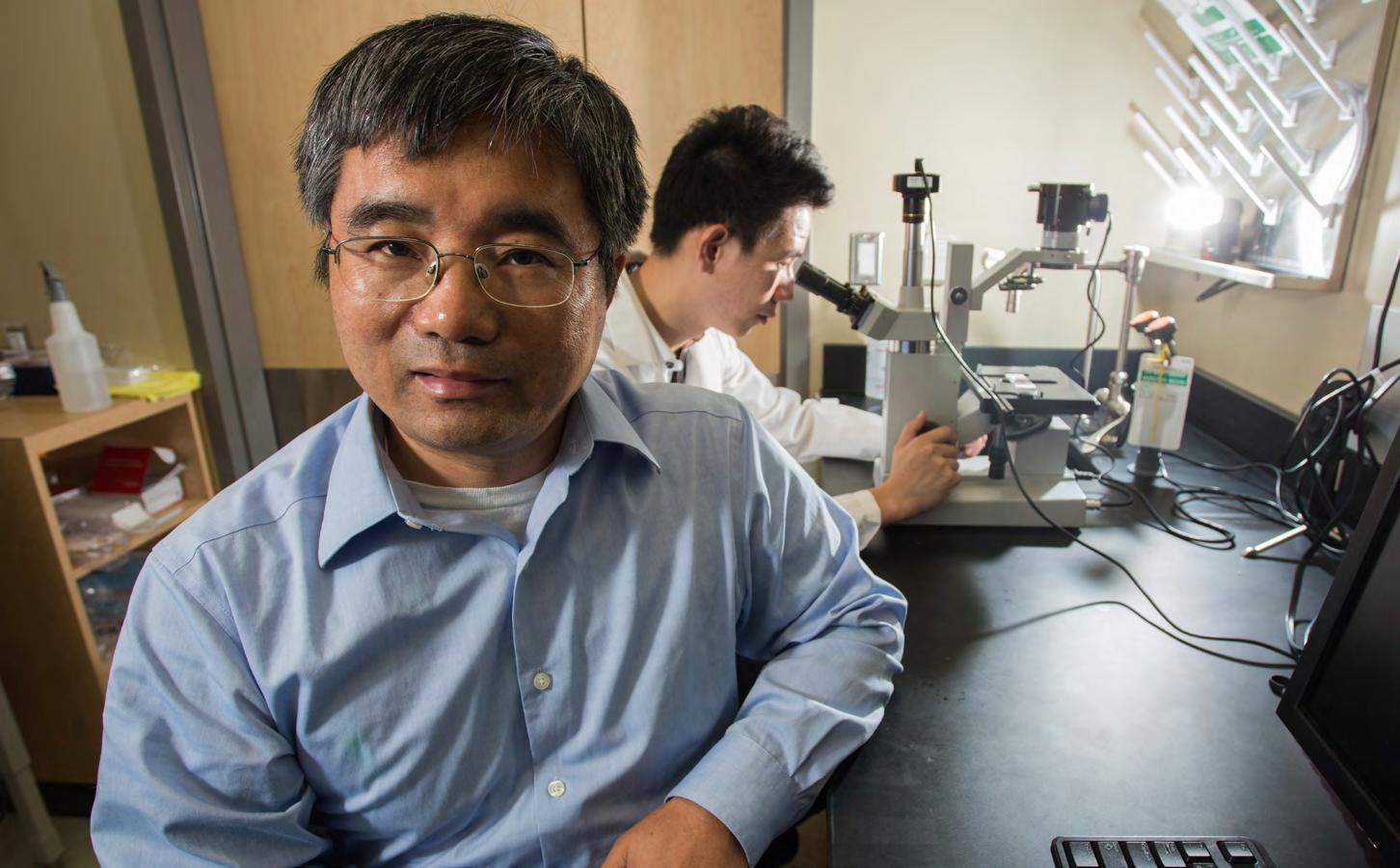
A total of 300 immunoglobulin-binding proteins were discovered in the screening, among which 77 proteins were detectable only in LN samples. Bioinformatics-assist ed selection allowed the team to further identify ten potential immunoglobu lin-binding proteins, which form circulat ing immune complexes (ICx) as potential biomarkers in LN.
“Immunoproteomics-based discovery studies have enabled us to identify prom ising immune complexes in LN, which are associated with clinical parameters in cluding renal pathology indices,” said Wu. “These ICx may be useful for the develop ment of more accurate and clinical blood tests for this disease and if validated, this test may be able to replace the existing in vasive tests at some point.”
The first author of the article is Chenling Tang, a doctoral student in Wu’s lab. Other collaborators include Min Fang, Gongjun Tan, Shu Zhang, Bowen Yang, Yaxi Li, Ting Zhang and Chandra Mohan from the University of Houston and Ramesh Saxena, University of Texas Southwestern Medical Center in Dallas.
A look inside Tianfu Wu's research lab.
HEALTH & MEDICINE
University of Houston Cullen College of Engineering 31
DEVELOPING A TEST FOR LEUKEMIA:
Kourentzi Receives 1st Federal Grant
As Lead
BY STEPHEN GREENWELL
A research professor at the Cullen College of Engineering has received a federal grant for about $700,000 to develop a rapid screening test for a specific form of leukemia that has severe health risks without prompt detection.
Katerina Kourentzi, Ph.D., a Research Asso ciate Professor in the William A. Brookshire Department of Chemical and Biomolecular Engineering, received the funding from the U.S. Army Medical Research Acquisition Ac tivity (USAMRAA). The $699,828 grant, “Nov el Point-of-Care Test for the Early Detection of Acute Promyelocytic Leukemia,” is the first federal funding award that she has received as principal PI.
“As you could imagine, this being my first federal grant as the principal investigator, my reaction was quite dramatic,” she said. “I was ecstatic! Beyond that, the idea of a rapid test to aid in cancer diagnosis is quite intriguing. We will need to implement many scientific
and technological advances to be able to de tect the low level of a cancer protein in blood in 30 minutes, and thus, we will be solving many technical challenges on the way. It is quite exciting.”
Kourentzi added, “In 2018 I received two small grants from the University of Houston's GEAR program and the Ladies Leukemia League that enabled us to produce strong feasibility data to be able to apply for a large federal grant. I am very grateful for that sup port, too.”
According to background information provid ed in the grant application, Acute Promyelo cytic Leukemia (APL) accounts for about five to eight percent of the annual 20,000 cases of acute myeloid leukemia (AML) cases in the United States. APL can occur at any age, but the median age is 40 years, younger than the 70 years for other AMLs. APL presentation is accompanied by severe, life-threatening
bleeding in 40 percent of patients. If detect ed on time, the long-term survival rate is 90 percent with the available treatment. There is not a standard rapid screening test to enable prompt initiation of the treatment.
The effort builds on previous research that Kourentzi has done, which improves a tech nology similar to that of the conventional home pregnancy test.

“We are developing an ultrasensitive, rapid diagnostic test for a specific type of leuke mia,” she said of her team's current research goal. “The test resembles a rapid COVID-19 test that nowadays everybody is familiar with. The issue here is that this specific type of leukemia – Acute Promyelocytic Leukemia – is treatable with a special type of chemo therapy if detected early. The timing here is quite critical, since patients deteriorate very fast, within hours of first presenting at the hospital. The current diagnostic tests to con firm this specific type of leukemia take from a few hours to a couple of days, which are un fortunately not fast enough. Our collabora tors in Methodist Hospital and MD Anderson Cancer Center are quite excited by the pros pect of a complementary rapid screening test to aid in timely diagnosis and the early ad ministration of therapy to save the patient.”
For this specific project, Kourentzi said she would be teaming with hematopathologists Dr. Youli Zu from Houston Methodist and Dr. Rashmi Kanagal Shamanna from the MD An derson Cancer Center. Dr. Claudia Pedroza, from UT Health, is an expert statistician that will also be a collaborator for the project.
In her department, Kourentzi identified sev eral colleagues that are part of the research team.
“I work closely with Professor Richard Will son. He introduced me to the area of Diag nostics many years ago and he is a constant source of intellectually-stimulating questions and ideas,” she said. “Professor Jacinta Conrad and Dr. Binh Vu in Chemical Engineering are an integral part of the team. I also work with an elite group of graduate students from Chemical Engineering, Biomedical Engineer ing, Biology and Chemistry.”
LEAD NEWS
32 PARAMETERS Fall 2022
Biomedical
Explores HEALTH CARE SHORTCOMINGS
BY LAURIE FICKMAN
To address the challenges of bringing COVID-19 solutions into clinical practice quickly, the Institute of Electrical and Elec tronics Engineers (IEEE) Engineering in Medicine and Biology Society (EMBS) con vened an international COVID-19 forum. In the group, 29 scientific researchers and in novators, industry leaders, clinical experts, and policy makers from the USA, Europe, the Middle East and Asia-Pacific provided a comprehensive and multi-dimensional per spective on the pandemic crisis. Their ma jor recommendations are now published in the IEEE Journal of Biomedical Health Infor matics
“It is our job during this difficult time to work together to develop novel diagnos tics and treatments to fight the pandem ic, including the development of portable, rapidly deployable, and affordable diag nostic testing kits, personal protective equipment, mechanical ventilators, and data analysis and modeling tools,” said the paper’s lead author, Metin Akay, John S. Dunn Endowed Chair Professor of biomed ical engineering at the University of Hous ton and IEEE Fellow.
The panel identified four major challenges to address during the short-term and over the long-term: health care, screening, trac ing and treatment.
“We invited a broad spectrum of experts in each of these areas to discuss the details of these grand challenges. They shared the unexpected early indications of both the acute and the chronic negative impacts of the viral infection on patient respiratory,
cardiac and nervous systems and resulting co-morbidities,” Akay reports.
Mental health issues were also reported in recovered patients and in the general population, in part due to necessary social isolation requirements imposed by public health authorities.
The panel examined socioeconomic and education status of patients, because they highly impact not only mortality, but also the length of hospital admission. Males, the elderly, ethnic and racial minorities, and those with co-morbidities (e.g., diabetes, congestive heart failure, obesity), were at a higher risk of worse clinical outcomes.
Regarding screening challenges, individu als typically wait to be tested until they are exhibiting common symptoms (e.g., upper respiratory infection, loss of smell or taste), or if they have had close contact with in fected persons.
“Although current approaches are function al, there is still an unmet need to rapidly identify and isolate infected individuals be fore they spread the virus. To address this need, new innovative technologies that provide reliable and prompt testing and tracking are urgently required,” said Akay.
The group also reported that the pandemic has highlighted an urgent need to accel erate the digital transformation of health care systems.
“We believe the lack of a global collabora tive strategy and vaccine equity hindered community attempts to ‘flatten the curve,’ slow the spread of the virus, prevent addi tional variants of concern (e.g., delta and omicron), decrease mortality, and lessen the economic burden of this disease, es pecially within communities of color and those who are economically disadvantaged worldwide,” said Akay.
METIN AKAY
Even more challenging and alarming, ac cording to the panel, is the prevalence of cardiac abnormalities following SARSCoV-2 infection.
“One study found elevated levels of high-sensitivity cardiac troponin I (hs-cTn1) in 46 percent of non-survivors, in compari son to 1 percent in survivors. Also, increased rates of myocardial infarction were also as sociated with COVID-19. This could be in part due to decreased availability of resources in the emergency setting or patients’ procras tination in obtaining treatment,” said Akay.
The forum provided a platform that strengthened the collective capability to exchange ideas as well as share, access and manage data, models and the latest reports on COVID-19/SARS-CoV-2 research.
“The forum accelerated the rapid scientif ic innovation and reproducible research needed to find solutions in the global battle to contain the COVID-19 pandemic,” said Akay. The findings will be regularly updated with new developments and solutions.
The paper was co-authored by Charlotte Mae K. Waits, former University of Hous ton and IEEE member and other affiliates of IEEE including Shankar Subramaniam, Colin Brennan and Paolo Bonato, senior members, and Bruce C. Wheeler, Dimitrios I. Fotiadis, fellows.
It is our job during this difficult time to work together to develop novel diagnostics and treatments to fight the pandemic.
HEALTH & MEDICINE
Forum
University of Houston Cullen College of Engineering 33
When it comes to rehabilitation efforts fol lowing a stroke, Jinsook Roh of the Cullen College of Engineering stresses that one simply can't address the effects of the in cident – a more holistic approach, looking at why and how a patient's movement has changed, for example, is needed, as well as objective measurement criteria.
“My current work aims at developing a new human-machine interface device that will facilitate stroke rehabilitation,” she said. “When you think about current stroke rehabilitation, some of the critical limitations of the current protocol focuses on treating symptoms. Our brain controls muscle to make action. But stroke sur vivors, they have damage in their neural tissue, and that's why the damaged neu ral tissue makes an incorrect motor com mand, and incorrect movement is generat ed. In the rehabilitation protocol targets, if we only change this movement trajectory, then we are neglecting the cause and fo cusing on the consequences.”
Roh wants to develop a rehabilitation mod el that is tailored to individual patients,
A CAREER
Of Stroke Rehab Research
BY STEPHEN GREENWELL
and that measures the cause of neural impairment, instead of fixing just the con sequences of that impairment. Or, as Roh puts it, “How the brain controls the mus cle, instead of how the motion is made.”
“My long-term goal is to develop a kind of novel adaptive human machine inter action device,” she said. “It would enable researchers to automatically measure and quantify motor impairment, and also de velop new therapy protocols. This device will be based on the how the brain controls coordination of multiple muscles. The sys tem will use multiple data types including brain, muscular, and force data measured in the arm, which help us see motor im pairment holistically.”
The approach has led to Roh's first Nation al Science Foundation grant, and a CAREER award. “Neuromuscular Coordination (NeuroCoord)-Guided Human-Machine Interaction for Quantifying and Improving Motor Function after Stroke” was chosen for $544,539 in funding by the NSF in Jan uary 2022.
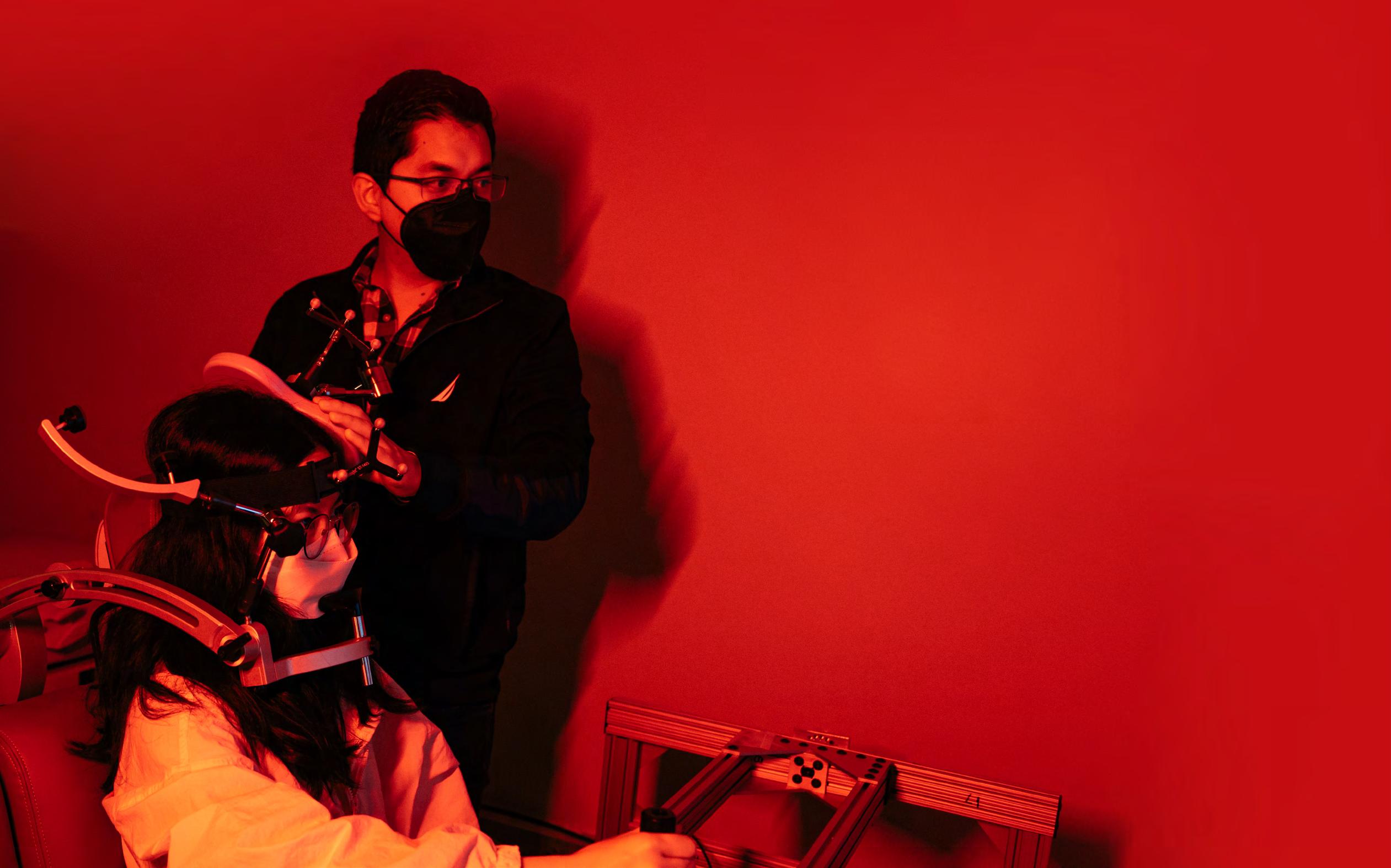
Roh, an assistant professor of biomedical engineering, noted that her research has evolved over time, from an initial interest in physics to the characteristics of move ment in creatures. She earned her doctor ate from the Massachusetts Institute of Technology (MIT) and her B.S. from Ewha Womans University in Seoul, South Korea.
After earning her doctorate, Roh worked as a postdoctoral research fellow at North western University, before being hired as an assistant professor of kinesiology by Temple University. She joined the Univer sity of Houston in 2018.
“I think engineering was more appropri ate for the research I was doing,” she said of joining the Cullen College of Engineer ing, adding that the City of Houston was a draw as well. “I'm grateful to be here because Texas, especially the Houston area and within Houston, there are more than 30 different hospitals, including the TIRR Memorial Hermann Hospital. So for me, it's much easier to make a clinical col laboration here that was essential for my study.”
LEAD NEWS
34 PARAMETERS Fall 2022
Roh identified three people outside of UH as having significant, positive impact on her career development – William Zev Ry mer, the director of the Single Motor Unit Laboratory at the Shirley Ryan AbilityLab (formerly the Rehabilitation Institute of Chicago); B.J. Fregly, a mechanical engi neering professor at Rice University; and Steven L. Wolf, a professor in the depart ment of rehabilitation medicine at the Em ory University of Medicine in Georgia.
Roh said that Rymer was “amazing” be cause of his ability to know the strengths and the research of individuals on his team, while still being able to manage and to see the big picture for one of the lead ing research hospitals.
Fregly assisted Roh with writing and apply ing for the NSF grant. While she's applied for and received funding from the Nation al Institutes of Health and the American Heart Association in the past, she noted that this was her first time receiving NSF funding.
“His input was very important for me, to really think about the innovation in the engineering of my research, which is the most important part for the NSF grant pro posal,” she said.
Top: Jinsook Roh (above center) poses with student researchers in her lab.

Bottom: Jinsook Roh guides students in using lab equipment.
Roh added that Metin Akay, the depart ment chairman of biomedical engineering at the Cullen College of Engineering, was also vital in encouraging her to pursue NSF funding as well.

“His encouragement was so helpful for me, to think about this type of grant more, because as I mentioned before, I'm usually writing NIH grants instead of NSF types,” she said. “The department support was critical, because without the equipment and the staff support, I couldn't think about this kind of project.”
When it came to Wolf, Roh said he provid ed mentoring support for her.
“He's not only expert in the field, he also has a heart and cares for the career devel opment of young junior faculty like me,” she said. “From time to time as an external mentor, he gave me some tips and ideas about career development.”
Roh identified two doctoral students –Gang Seo and Yoon No Hong – as partic ipating in the research for this grant. The grant runs through May 2027.
University of Houston Cullen College of Engineering
HEALTH & MEDICINE
35
IDing POTENTIAL BIOMARKERS
For Neuropsychiatric Symptoms Of Lupus
BY LAURIE FICKMAN
A globally renowned expert in autoim mune diseases and systemic lupus erythe matosus (SLE) at the University of Hous ton has identified potential biomarkers for neuropsychiatric symptoms of lupus. Lupus is an autoimmune disease in which the immune system attacks its own tis sues, causing widespread inflammation and tissue damage in the affected organs.
While most people with lupus experience a variety of symptoms that include fa tigue, skin rashes, fever, and pain or swell ing in the joints, about half of people with SLE suffer neuropsychiatric symptoms. Those include seizures, aseptic meningitis, acutely confused states, cerebrovascular disease psychosis and mood disorders.
“The diagnosis of neuropsychiatric lu pus is difficult because the neurological symptoms could very well be due to oth er causes. As no gold-standard diagnostic test exists for neuropsychiatric systemic lupus erythematosus (NPSLE), we execut ed a broad screen of NPSLE cerebrospinal fluid using an aptamer-based platform,” reports Chandra Mohan, Hugh Roy and Lillie Cranz Cullen Endowed Professor of biomedical engineering, in the journal Arthritis & Rheumatology. Aptamers are short sequences of nucleic acids that can be further selected based on their bind ing specificities. Commercially available libraries of aptamers allow comprehensive screening of >1000 human protein targets, representing some of the largest screening platforms currently available in targeted proteomics.
Mohan’s team screened more than 1,100 proteins in the fluid surrounding the
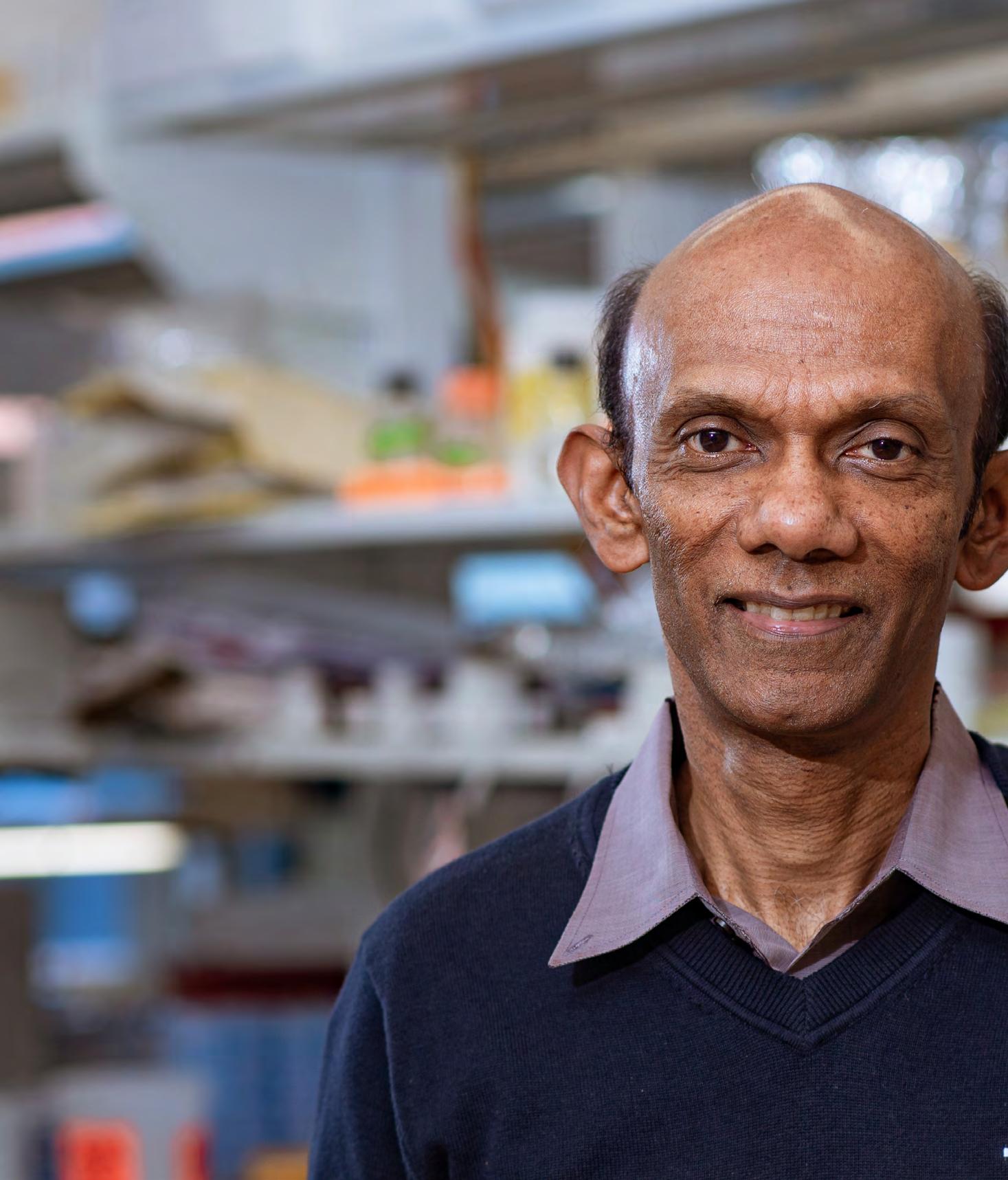
brains of neuropsychiatric lupus patients and identified a few proteins that could potentially be used to diagnose neuropsy chiatric lupus. The proteins that showed up in most samples are CSF Lipocalin-2, M-CSF, IgM and complement C3.
“These proteins emerged as promising cerebrospinal fluid biomarkers of NPSLE with diagnostic potential,” Mohan report ed. “Elevated CSF C3 was associated with acute confusional state. Eleven molecules elevated in the fluid exhibited concordant elevation in the choroid plexus, suggest ing shared origins.”
Neuropsychiatric events occur most fre quently early during the disease course in most cases, either as a presenting symptom or within the first five years of disease onset.
Cerebrospinal fluid samples used in this study were provided by collaborators John Hanly from Dalhousie Lupus Clinic, Hal ifax, Nova Scotia, Canada and C.C. Mok from Tuen Mun hospital in Hong Kong, China. Laboratory studies were carried out by UH researcher Kamala Vanarsa in Mo han’s lab.
"We believe proteomic investigations of blood and cerebrospinal fluid will eventu ally lead to the fabrication of a serum or cerebrospinal fluid-based diagnostic panel that permits accurate diagnosis of NPSLE, with significantly higher specificity for this disease, compared to other neuroinflam matory diseases or infections,” said Mo han.
We believe proteomic investigations of blood and cerebrospinal fluid will eventually lead to the fabrication of a serum or cerebrospinal fluidbased diagnostic panel that permits accurate diagnosis of NPSLE.
CHANDRA MOHAN
LEAD NEWS
36 PARAMETERS Fall 2022
Finding Drugs For Formerly UNDRUGGABLE CANCER TARGETS
BY LAURIE FICKMAN
With a $2 million recruitment grant from the Cancer Prevention and Research In stitute of Texas (CPRIT), a University of Houston researcher is setting up a lab to develop drugs that will work on tradition ally undruggable targets in cancer.
Gül Zerze, assistant professor in the Wil liam A. Brookshire Department of Chem ical and Biomolecular Engineering at the Cullen College of Engineering, is one of 12 cancer researchers recruited to Texas by CPRIT last November.

Zerze’s initial target is breast cancer.
"One out of nearly six Texas women diag nosed with breast cancer will die of the disease. Importantly, Texan women of color are disproportionately impacted by the high mortality rate compared to white Texan women (41 percent higher mortal ity rate reported for Black Texan women in 2016). This high mortality rate, despite the substantial efforts made for early diag nosis, calls for better therapeutics urgent ly,” said Zerze, whose research will also be expanded more broadly to address other cancers.
The CPRIT recruitment grants for the lat est class, totaling $38 million, are meant to “form a critical ecosystem of distinguished cancer-fighting talent” in Texas. Zerze was persuaded to come to UH from Princeton University, where she was a postdoctoral researcher specializing in computation al modeling and simulations of a special class of proteins called intrinsically disor dered proteins (IDPs).
The vast majority (about 70 percent) of proteins implicated in human cancers are either IDPs or have large intrinsical ly disordered regions, and many of these targets are considered ‘undruggable’ due to the scarcity of high-resolution methods that can offer a fundamental understand ing of them.
“Computational and data science meth odologies offer a promising avenue to fill in this gap to enable developing drugs against these traditionally undruggable targets,” said Zerze, whose methodology will include rapid screening.
Despite the significant progress made in
cancer treatment options in the last 20 years, many cancer targets have still yet to be drugged. Among those holding promise are transcription factors (TFs), which are proteins involved in converting (or tran scribing) DNA into RNA. TFs contain large amounts of disordered proteins which participate in transcriptional condensates that form via liquid-like phase separation (LLPS).
“Transcriptional condensates are shown to be aberrant in tumor cells, but the prog ress to develop drugs against TFs that participate in LLPS has been limited by the extremely dynamic nature of activa tion domains of TFs. We are developing a computational platform that will enable discovering drugs against these aberrant condensates by systematically interrogat ing the way transcription factors form, through the liquid-like phase separation of intrinsically disordered regions,” said Zerze.
Through collaborations within the Univer sity and the MD Anderson Cancer Center, the drug candidates will be rapidly tested.
“The ideas proposed here will save lives and the products that will come out of this project have a great potential for com mercialization and founding companies to contribute to the Texas economy,” said Zerze.
GÜL ZERZE HAS RECEIVED A $2M GRANT TO INNOVATE COMPUTER-AIDED DRUG DISCOVERY FOR BREAST CANCER
Gül Zerze poses for a photo with her research team.
HEALTH & MEDICINE
University of Houston Cullen College of Engineering 37
STUDYING CONCRE TE PERFORMA NCE
BY STEPHEN GREENWELL
A professor at the Cullen College of Engineering has received a pair of grants that will utilize the one-of-akind machinery available at the University of Hous ton to conduct research into shear failures for a new type of concrete, UHPC.

Dimitrios Kalliontzis, an Assistant Professor in the Civil and Environmental Engineering Department, said the research will investigate the performance of structures using a new concrete material, Ul tra-High-Performance Concrete (UHPC).
“UHPC is new to civil engineering and it is consid ered an emerging technology that promises to tackle aging effects and enhance the structures’ robust ness and durability,” Kalliontzis said. “While UHPC is attracting significant attention from industry, the significant lack of experimental data hinders the de velopment of design code provisions. Without those provisions, there is no official guidance to the field implementation of UHPC structures. Our two re search projects will generate the necessary data to support the development of provisions for the design of UHPC against shear failures.”

LEAD NEWS
38 PARAMETERS Fall 2022
Kalliontzis noted that the American Con crete Institute (ACI) and Precast / Pre stressed Concrete Institute (PCI) chose UH for the research because of the unique hardware present at the Cullen College of Engineering.
“What's important about this research is that it leverages the Universal Panel Tes ter, a one-of-its-kind machine in the Unit ed States, which is located in the Struc tural Research Laboratory of University of Houston,” he said.
According to a history of the lab on the College's website, it was established in 1980, with further research grants from the National Science Foundation (NSF) and the Texas Advanced Technology Research Program (TATRP) allowing for additional facilities and improvements. The Universal Panel Test was installed from 1986 to 1988, described in a paper by Thomas Hsu, Ab deldjelil “D.J.” Belarbi – then at the Uni versity of Missouri-Rolla – and X. Pang of Southwestern Laboratories in Houston. A servo-control system was designed and installed from 1992 to 1994, and written about in a 1995 paper by Hsu, and Cullen graduates Li-Xin Zhang (a longtime Senior Principal Engineer for Technip) and Gerar-
INFRASTRUCTURE
do “Tito” Gomez (now director of DAT Sales and Consulting).
“The Tester is an efficient approach to study the overall behavior of a structure through understanding the behavior of its constituent elements,” Kalliontzis said. “The development of the Unified Theory of Concrete Structures was the culmination of more than 20 years of research on the Tester. Nowadays, the Tester continues to write history and attract research funding for the University of Houston through the unique testing capabilities that it offers.”
The ACI and PCI research will span three years, with funding of about $100,000. Additional material and product support will be provided by industry partners, in cluding Steelike and Tindall.
Kalliontzis said the research would be con ducted by several students, as well as Go mez.
“Noran Shahin and Abdulrahman Salah are the two Ph.D. students involved in this research,” he said. “Tito Gomez, Director of DAT Sales & Consulting LLC., is leading the effort in the experimental work of the two projects.”
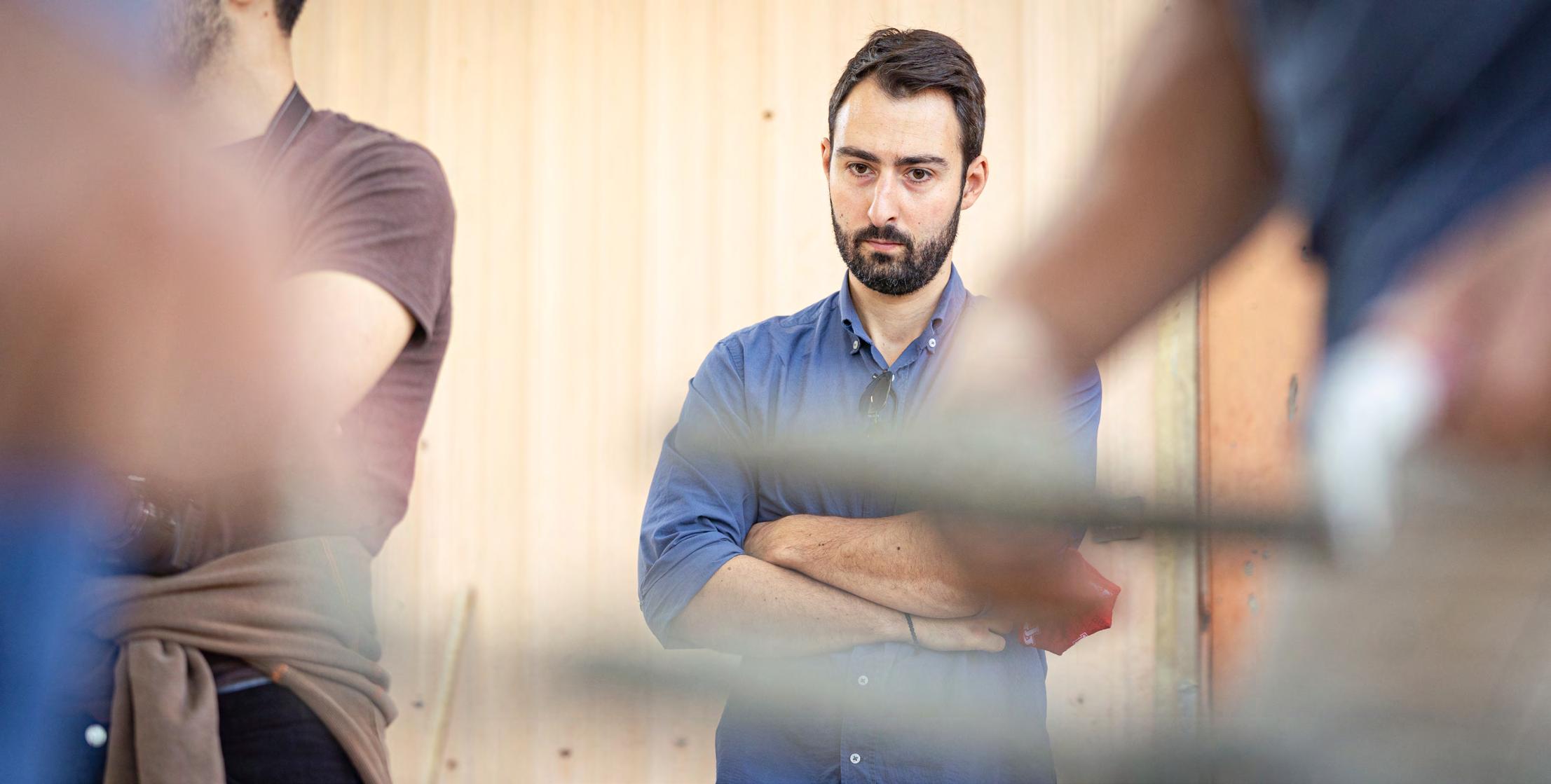
What's important about this research is that it leverages the Universal Panel Tester, a one-ofits-kind machine in the United States, which is located in the Structural Research Laboratory of University of Houston.
Dimitrios Kalliontzis oversees work performed by student researchers.
DIMITRIOS KALLIONTZIS
University of Houston Cullen College of Engineering
39
BRIDGING THE
Using Mathematical Models to Further STEM Efforts
 BY STEPHEN GREENWELL
BY STEPHEN GREENWELL
LEAD NEWS
G A P
40 PARAMETERS Fall 2022
OUTREACH
For Industrial Engineering assistant profes sor Taewoo Lee and doctoral student Poria Dorali, each one came to the decision to volunteer with the St. Elmo Brady STEM Academy in different ways.

Lee finished his doctorate in Operations Research at the University of Toronto in 2015 and moved to the United States, tak ing a position at Rice. Since he learned about the pressing issues in the healthcare system, especially related to disparity in access to care, his research has been fo cused on how to use mathematical models to redesign healthcare delivery systems to improve equity and reduce disparity in ac cess to care.
“While doing this research in healthcare, I was also aware that disparity in access is not only limited to healthcare but is preva lent in other aspects as well, and one that really caught my attention was education,” Lee said. “At Rice, I used to work with a non-profit organization to develop the software, based on mathematical model ing, to recruit and assign college student tutors to elementary schools in underrep resented areas in Houston. As I moved to UH in 2017, I naturally looked for new op portunities to expand.”
At this point, Lee connected with Jerrod Henderson, a co-founder of the St. Elmo Brady STEM Academy and now an assis tant professor in the William A. Brookshire Department of Chemical and Biomolecular Engineering, and Ricky Greer, another co-founder of the academy.
“I learned about Dr. Henderson's exciting initiatives on out-of-school STEM interven tions for K-12 students in underrepresent ed areas,” Lee said. “We started with the summer camp events through PROMES – my research group didn’t have fancy ro bots for the students to play with, but Dr. Henderson let us host some interesting, in teractive games we play with the students, through which the students can naturally understand what industrial engineering is. Ever since, this event has been my research group’s tradition. Based on our collabora tion with Dr. Henderson and Mr. Greer, we were then honored to participate in the St.
Elmo Brady STEM Academy to have the op portunity to further reach out, and the rest is history.”
Dorali knew Henderson as an undergrad uate, and enthusiastically agreed to help when Lee offered the opportunity for his students to work with the academy.
“I knew of Dr. J as an undergrad and I had the privilege of working with him in the summer right before I started my Ph.D. on education research,” Dorali said. “When the opportunity arose with Dr. Lee to work with Dr. J in helping out with events with students in the local community, it was an instant yes from me.”
Dorali and Lee were both quick to stress that the volunteer effort was wide-ranging, with support from a variety of organiza tions.
“Sometimes it can be tough and time-con suming process developing curriculum and setting things up, especially when you try to keep refining it the best you can in hopes of delivering something meaningful to them,” Dorali said. “However, it’s never a solo project. It has always been incredi ble observing the outflow of support from not only the volunteers from INFORMS or IISE, our industrial engineering-based stu dent organizations, but also from PROMES to the site coordinators and even to Mr. Greer and Dr. J themselves. The energy and insight everyone pours into these projects and events is nothing short of amazing and seeing how others are so motivated and caring is something that gives me energy too.”
Along with Lee, Dorali identified IE gradu ates Zahed Shahmoradi, Amanda Khem and Krystal Ashby, and undergrad senior Emilia Diaz, as a few of the people he's worked closely with the past few years on efforts at the academy.
“It’s always such good-feeling moment sharing our experiences after the week’s over as well as brainstorming as to what we can do to improve,” he said.
Lee added, “I must say that all of the ac
Taewoo Lee poses for a picture with his student Poria Dorali.
tivities are driven by our passionate stu dents in the department, led by Poria and a former student, Zahed Shahmoradi, who is now a post-doc researcher at UT Health. They put together a great team of both un dergraduate and graduate students from different background to make every event a success. I am grateful to them for their initiatives and endless well of creativity.”
Dorali, who went to an elementary school in Alief ISD before transferring to a school in Fort Bend, attributed his continuing par ticipation in the programs to the difference it makes for the children he works with.
“There isn’t almost anything in the world that beats seeing that light bulb moment for someone,” he said. “To be able to be in a position where I can give back to the community I grew up in and to work on projects and share knowledge with these students about a field I love is something I have the utmost appreciation for.”
He added, “This is my fourth year here as a Ph.D. student in the industrial engineer ing department, where I finished my B.S. in Industrial Engineering in 2018. I’ve been fortunate to take part in what I consider very meaningful research in medical deci sion-making for vulnerable or under-served patients, particularly in Harris County. In the future I hope I can continue this focus, whether it be as a professor, with the add ed bonus of teaching students, or even in the healthcare industry, particularly in the public sector."
University of Houston Cullen College of Engineering 41
Are 5G Devices The Key to MAKING WIRELESS NETWORKS SMARTER?
 BY STEPHEN GREENWELL
BY STEPHEN GREENWELL
A pair of researchers from the Cullen College of Engineering have received $500,000 from the National Science Foundation to lower energy consumption and service delay, two key components of federated learning's practical implementa tion in wireless networks.
Miao Pan, Ph.D., Associate Professor of Electrical and Computer Engineering, is the principal investigator for the grant, “Towards Federated Learning over 5G Mo bile Devices: High Efficiency, Low Latency, and Good Privacy.” Xin Fu, Ph.D., Associ ate Professor of ECE as well, is a co-PI for the project. The funding comes from the Computer and Network Systems (CNS) Core program of the NSF for collaborative research.
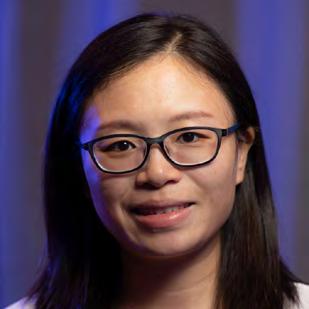

According to the abstract for the grant, recent emerging FL allows data sourc es to collaboratively train a global model without sharing their privacy sensitive raw data. However, due to the huge size of the deep learning model, it downloads and updates generate significant amount of network traffic which exerts a great bur den to existing telecommunication infra structure.
“This project takes FL over 5G mobile de vices as a workable application scenario to address this dilemma, which will sig nificantly improve the design, analysis and implementation of FL over 5G mobile devices,” the grant authors wrote. “The research outcomes will substantially en rich the knowledge of machine learning technologies and 5G systems and beyond. Moreover, this project is multidisciplinary, involving machine learning/deep learn ing/federated learning, edge computing, wireless communications and networking, security and privacy, computer architectur al design, etc., which will serve as a fruitful
Miao Pan (left) and Xin Fu (right).
LEAD NEWS
42 PARAMETERS Fall 2022
training ground for both graduate and un dergraduate students to equip them with multidisciplinary skills for future work force to boost the national economy.”
Pan added, “Federated learning will nev er fly by the algorithm itself. Its practical implementation and service efficiency can only be achieved by synergized research efforts of machine learning, mobile device hardware, and wireless communications and networking.”
Outreach activities are also planned for high school students, to increase the par ticipation of female and minority students in science and engineering. There are four design goals for the project:
1. Designing software-hardware co-de signed model pruning schemes and adaptive quantization techniques in FL within a single 5G mobile device according to the local data and model sparsity property to reduce the local computation and memory access.
2. Making sound trade-off between "working" (i.e., local computing) and "talking" (i.e., 5G wireless transmis sions) to boost the overall energy/ communications efficiency for FL over 5G mobile devices.
3. Developing novel differentially pri vate compression schemes based on sparsification property and quantiza tion adaptability to rigorously protect data privacy while maintaining high model accuracy and communication efficiency in FL.
4. Building a testbed to thoroughly eval uate the proposed designs.
Pan said one doctoral student, Rui Chen, has already started working on the re search.
The grant was awarded in July 2021, and research began in October 2021. The esti mated time frame for the research is four years.
Continuous LIVE DRONE MONITORING
BY LAURIE FICKMAN
To enhance security of the nation’s bor der, a pioneer in drone technology at the University of Houston is proposing a con tinuous flight of small drones over its pe rimeter. One small problem: The battery limitation of small drones (they last about 30 minutes) is a major obstacle to contin uous flight time.
To address this problem, Gino Lim, R. Lar ry and Gerlene (Gerri) R. Snider Endowed Chair of Industrial Engineering, proposes the use of drones with a built-in wireless electrification line (E-line) battery charging system. Lim pioneered that technology in 2017.
“Smart border patrol using small-size drones may provide significant help in pa trolling areas inaccessible to patrol agents, reduce agent response time, and increase the safety of patrol agents working in dan gerous regions. To strengthen border se curity and reduce the need for patrolling via human agents, we propose the use of drones coupled with the use of E-lines for continuous border surveillance,” Lim reports in the journal Computers & Indus trial Engineering. The paper’s first author is Navid Ahmadian, a former doctoral stu dent in Lim’s lab.
The E-line system charges the drones

during their surveillance, enables a con tinuous and seamless flight over the bor der and eliminates the need for battery charging stations. Continuous monitoring sends live information about different lo cations of the borderline to the designat ed control centers, helping enhance bor der security and reducing the necessity of systems operated by people.
“This work provides an optimization mod el to determine the optimal number of drones, the optimal length of the E-line, and the optimal location of the E-line sys tem required for border surveillance,” said Lim.
In developing their model, the team re viewed a case study of a segment of the U.S.-Mexico borderline spanning 22.8 miles and located between two border crossings within the Cochise County limits in Arizona.
Although drones have been the subject of many studies, few studies have focused on the implementation of the drone for continuous border surveillance.
In previous work Lim provided a template for drone routes targeting chronic pa tients in rural areas to assist in medicine delivery via drone.
TECHNOLOGY University of Houston Cullen College of Engineering 43
RE-CONCEPTUALIZING EARLY MESOAMERICA
ARTICLE COMPILED BY TAKESHI INOMATA, AT THE UNIVERSITY OF ARIZONA, WITH EDITING FROM STEPHEN GREENWELL, AT THE CULLEN COLLEGE OF ENGINEERING AT THE UNIVERSITY OF HOUSTON.

LEAD NEWS
44 PARAMETERS Fall 2022
Through the analysis of airborne laser mapping (lidar), an international team of researchers – including several from the Cullen College of Engineering at the Uni versity of Houston – identified 478 cere monial centers in the Mexican states of Tabasco and Veracruz.


Most of those sites likely date to 1100 to 400 B.C., several centuries before the Classic period (A.D. 250 to 950) or the hey day of Maya civilization. Their discoveries transform scholars’ understanding of the origins of Mesoamerican civilizations, par ticularly the relation between Olmec and Maya cultures.
The research is featured in an article in Nature Human Behavior, initially published on Oct. 25. Juan Carlos Fernandez-Diaz, Ph.D., of the National Science Foundation (NSF) National Center for Airborne Laser Mapping (NCALM) at the University of Houston, and co-author in this study, led UH/NCALM participation in this research, which included other UH faculty and staff. Other researchers are from the University of Arizona.
When asked what attracted him to this
research, Fernandez-Diaz said, “As an en gineer I constantly admire the efforts an cient cultures put toward creating massive infrastructure projects, either to represent their vision of the cosmos, like we find in this study, or to modify the landscape and environment to their advantage. There are many lessons in conservation and resilien cy we could re-learn from studying ancient cultures; and which we can the apply to our current challenges.”
Lidar can map 3-dimensional forms of the ground and archaeological sites by pene trating vegetation. This study used publicly available lidar data obtained by the Mex ican governmental organization Instituto Nacional de Estadística y Geografía (INE GI) and high density lidar data collected by NCALM. It covered an area of 85,000 km2 (equivalent to Ireland), representing the largest archaeological lidar study in Meso america.
UH/NCALM conducted a high density airborne lidar survey of more than 800 km2 in the Mexican states of Tabasco and Campeche. From this survey high defini tion images were produced of archeologi cal features, which aided in the interpreta
An image of one of the center's data collection planes.
THE LIDAR COLLECTION COVERED AN AREA OF 85,000 KM2 (EQUIVALENT TO IRELAND), REPRESENTING THE LARGEST ARCHAEOLOGICAL LIDAR STUDY IN MESOAMERICA.
TECHNOLOGY
University of Houston Cullen College of Engineering 45
tion of the lower definition images derived from the older lidar data. Fernandez-Diaz reworked previously collected lidar by NASA and INEGI [lidar], particularly INEGI lidar for the archae ological site of San Lorenzo. The reprocessed image of San Lorenzo revealed key architectur al features and layout, which are interpreted in this study as a blueprint for the development of later sites in the region.
These complexes shared highly standardized formats, including rectangular plazas demar cated by lines of low mounds. These rectangu lar forms measured up to 1.4 kilometers (0.87 miles) in length, and the east-west axes of some complexes were oriented to the directions of sunrise on specific dates. These centers were probably the earliest material expressions of basic concepts of Mesoamerican calendars.
The largest of those rectangular complexes, Aguada Fénix, is found in the western Maya lowlands. It was previously reported in Nature (Inomata et al. 2020. Monumental architecture at Aguada Fénix and the rise of Maya civiliza tion) and was first identified in lidar data collect ed by NCALM in 2017. The present study shows that similar ceremonial complexes spread in a broad area, including the Olmec region and the western Maya lowlands.

The study also suggests that the prototype of those standardized formats was developed at the earlier Olmec center of San Lorenzo be tween 1400 and 1000 B.C. Through the analysis of lidar data of San Lorenzo, the authors detect ed a previously unrecognized rectangular form.
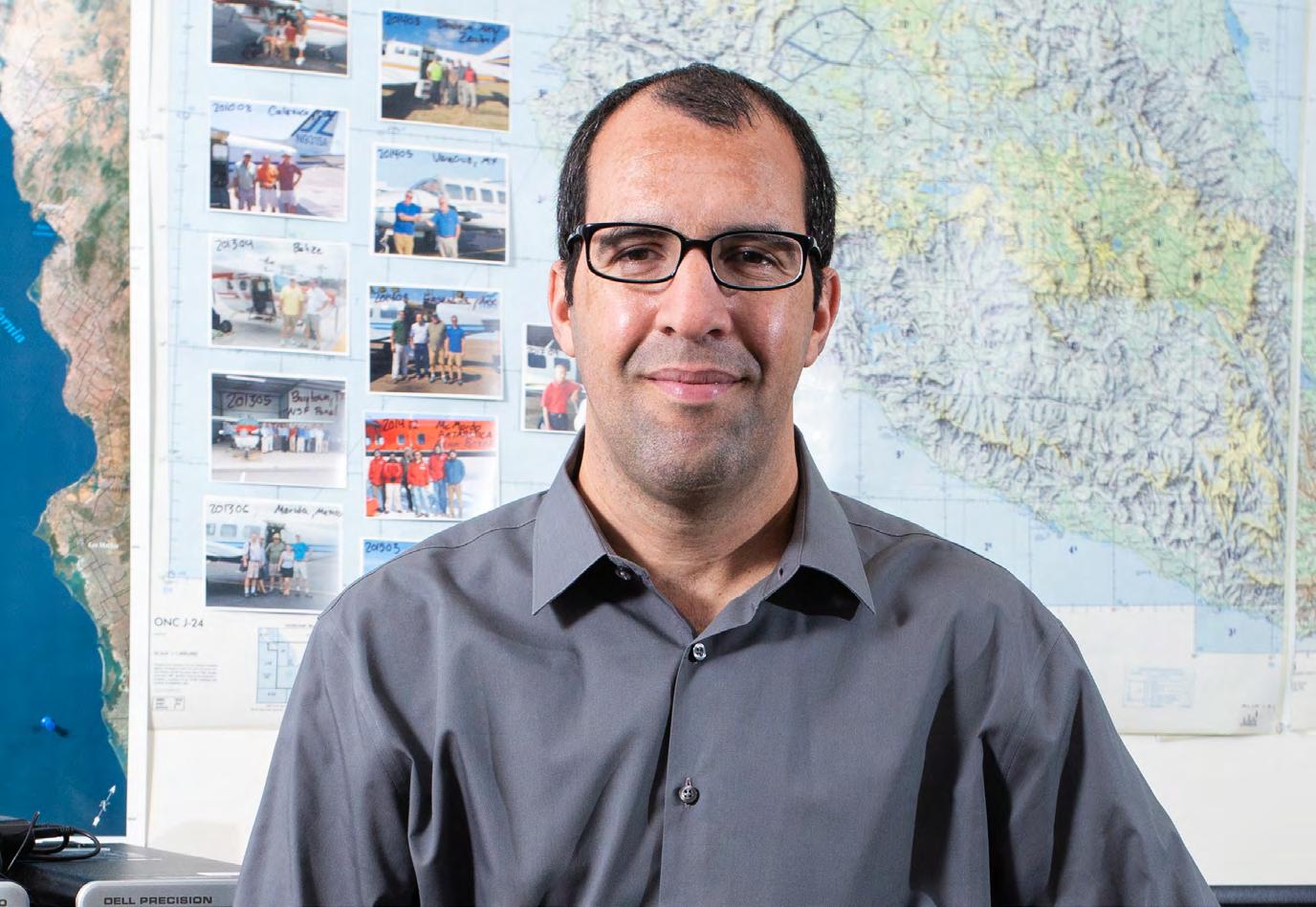
San Lorenzo had hierarchical organization, as shown by colossal head sculptures probably depicting rulers. In contrast, the builders of the standardized sites found in this study probably did not have marked social inequality. They ap pear to have maintained certain levels of mobil ity, living in ephemeral houses. The enormous constructions made by those no-hierarchical groups force researchers to rethink how early civilizations developed.
These findings show the importance of the leg acies of San Lorenzo and the innovations made by later groups. Standardized complexes in this area declined after 400 B.C., but some of their elements were adopted by later Maya centers, providing an important basis for Maya civiliza tion.
There are many lessons in conservation and resiliency we could re-learn from studying ancient cultures.
- JUAN CARLOS FERNANDEZ-DIAZ
Juan Carlos Fernandez-Diaz
LEAD NEWS
46 PARAMETERS Fall 2022
Transformational Institute To ENHANCE CYBERSECURITY
BY LAURIE FICKMAN
As the nature of digital warfare evolves, the need for a workforce trained in cyber security is critical for defending the Unit ed States from attacks. In response to the growing threat and the need for talent, the University of Houston has joined a consor tium funded by the U.S. Department of Defense (DoD) to launch a virtual institute that will recruit and train the next gener ation to combat cyber warfare, including cyber espionage and attacks on the elec tromagnetic spectrum.
The virtual institute, called VICEROY (Vir tual Institutes for Cyber and Electromag netic Spectrum Research and Employ) DECREE, will be led by Northeastern Uni versity. It will offer a two-year scholarship program focused on advanced cyberse curity, the electromagnetic spectrum, cryptography, data science, DoD research and strategic foreign languages, including Chinese, Russian, Arabic, Persian and Ko rean. The program will be offered across five universities, including UH, Northern Arizona University, the University of Texas at Austin and the University of South Caro lina, and will include experiential learning opportunities, such as co-op positions at the DoD and other employers within the consortium partners’ networks.
“The VICEROY DECREE virtual institute consortium model is transformational. It brings together the best offerings from multiple institutions to meet the work force training needs in these domains," said Hanadi Rifai, Moores Professor of civil and environmental engineering and UH team lead on the project.
The scholarship program will fund 60 stu dents and is open to veterans, ROTC stu dents and civilians, with a particular em phasis on underrepresented minorities,
THE TWO-YEAR PROGRAM, FUNDED BY A $1.5 MILLION AWARD, KICKS OFF IN FALL 2022.
women and those from economically dis advantaged backgrounds. Students eligi ble to enroll must be security clearance-el igible U.S. citizens.
A critical focus of the program will be the electromagnetic spectrum, which includes radio waves, and is a critical enabler for communications, navigation, radar, train ing and other military operations. Interna tional adversaries have engaged in cyber espionage and hacking, infiltrated U.S. trade secrets and launched cyber-attacks on critical infrastructure. They are now developing electronic warfare weapons focused on the DoD’s ability to operate in the spectrum.
"We recognize the importance and need for workforce training in cybersecurity, electromagnetism, cryptography and data science. These are areas of specific focus and expertise on our campus,” said Paula Myrick Short, former UH senior vice pres ident for academic affairs and provost.
As a signal of the urgency, DoD has been seeking to hire more than 8,000 cyber workers to help defend the virtual space.
“The battlefield has evolved, and our ad
versaries can now exploit vulnerabilities in cyberspace, where information resides and is accessed, and in the electromag netic spectrum, where signals are trans mitted,” said Jose Sierra, a Northeastern associate teaching professor and associate director for cybersecurity who is leading VICEROY DECREE at Northeastern. “Spec trum superiority is critical in military oper ations because electromagnetic radiation is used in command, control, and commu nications for radios, drones, and wireless devices; in navigation systems, like GPS; and in surveillance systems, like radars.”
The two-year program starts in fall 2022 and may be extended beyond its initial two-year commitment. It is funded by a $1.5 million award from the Griffiss In stitute, a nonprofit talent and technolo gy accelerator for DoD and its academic, government and industry partners around the world. The university consortium sup porting this program is associated with the Virtual Institutes for Cyber and Electro magnetic Spectrum Research and Employ (VICEROY), a DoD initiative launched with the Griffiss Institute that was funded by the 2019 John S. McCain National Defense Authorization Act.
The institute will extend its reach to highschool students, with a special focus on women and underrepresented minorities, to help meet the demand for cybersecurity workers at DoD and the Defense Industri al Base, which provides the products and services for military operations.
Additionally, VICEROY DECREE will offer free training to faculty at community col leges and minority-serving institutions, with stipends for faculty who go on to teach cybersecurity and the electromag netic spectrum in their classrooms.
TECHNOLOGY
University of Houston Cullen College of Engineering 47
'SUPER COOL CONDUCTOR'
Advances In Prestigious DOE Competition
BY KARN DHINGRA
As the world embarks upon the energy transition, improved elec trification will be key to powering an efficient low carbon global economy.
The development of superconductors, materials that can revolu tionize the way electricity is generated, transmitted, stored and efficiently used for technologies fundamental to modern life at scale and low cost, will be central to this transition.

The University of Houston is contributing to the energy transition through its research efforts on superconductors.
The Super Cool Conductor from UH’s Selva Research Group was recently one of ten competitors to win the first stage of the U.S. Department of Energy’s prestigious Conductivity-enhanced mate rials for Affordable, Breakthrough Leapfrog Electric and thermal applications or CABLE Prize. The three-stage competition will award up to $4.5-million to spur development of new materials that enhance conductivity.
Each winning team earned a $25,000 cash prize and a stipend for third-party conductivity testing in the second stage of the com petition.
“UH has long been a leader in superconductivity research since the pioneering days of our National Academies member Dr. PaulVenkat Selvamanickam

LEAD NEWS
48 PARAMETERS Fall 2022
Chu,” said Amr Elnashai, vice president for research and technology transfer at UH. “Selva’s group is now leading the de velopment of a superconducting wire that is industrially scalable in a cost-efficient manner, which has been the most signif icant challenge inhibiting widespread ap plications.”

The DOE CABLE Prize is for researchers and inventors who are working to develop and manufacture breakthrough conductiv ity-enhanced materials that will speed the U.S. energy and manufacturing industries use of these materials. The conductors must demonstrate "an electric conductiv ity enhancement an unprecedented seven to eight times larger than that of today’s best copper- and aluminum-based con ductors" according to the DOE’s Office of Energy Efficiency and Renewable Energy.
“This is huge for us because we are the only superconductor technology among the ten prize winners at this stage,” said Venkat Selvamanickam, M.D. Anderson Chair Professor of Mechanical Engineer ing at UH’s Cullen College of Engineering, director of the Advanced Manufacturing Institute and head of the Selva Research Group.
The Super Cool Conductor, a very thin wire which is mostly made of ceramic materi als, is a rare-earth, high temperature su perconductor that can be manufactured at half the cost of copper and cooled with liquid nitrogen or cryocooling for applica tions such as long duration energy stor age, Selvamanickam said.
Another potential application the Su per Cool Conductor could be used for is long-distance power transmission and up grading copper cables in major metropoli tan areas, Selvamanickam added.
Currently, the congested areas of most major U.S. cities bring in power via cop per cables from power substations in their region.
If these cables were replaced with the Su per Cool Conductor wires, cities could po tentially get 10 times the power without
having to deal with the associated costs and logistical hassle of digging trenches and installing new copper cables in a city, he noted.
And when it comes adapting to the im pacts of climate change, the Super Cool Conductor could be used in places like California that are susceptible to wildfires.
Some of California’s overhead power lines buckled and collapsed and sparked the fires. But if these wires (Super Cool Con ductor) were used to replace them and they were buried underground, next to other utilities and natural gas pipelines, it will help solve this problem, he said.
When it comes to renewable energy, Selva Research Group’s wires could be used in
wind turbines to generate, distribute and store their power more efficiently.
“They can generate much more power and their impact in transporting the power over long distances from the wind farms to cities could be huge,” Selvamanickam said.
The University of Houston is laser-focused on research that addresses societal prob lems and improves quality of life, Elnashai said.
“I am therefore delighted to see Selva’s technology recognized nationally and pledge our continued support of the Ad vanced Manufacturing Institute at UH,” he added.
A student works in the lab of Venkat Selvamanickam.
University of Houston Cullen College of Engineering
TECHNOLOGY
49
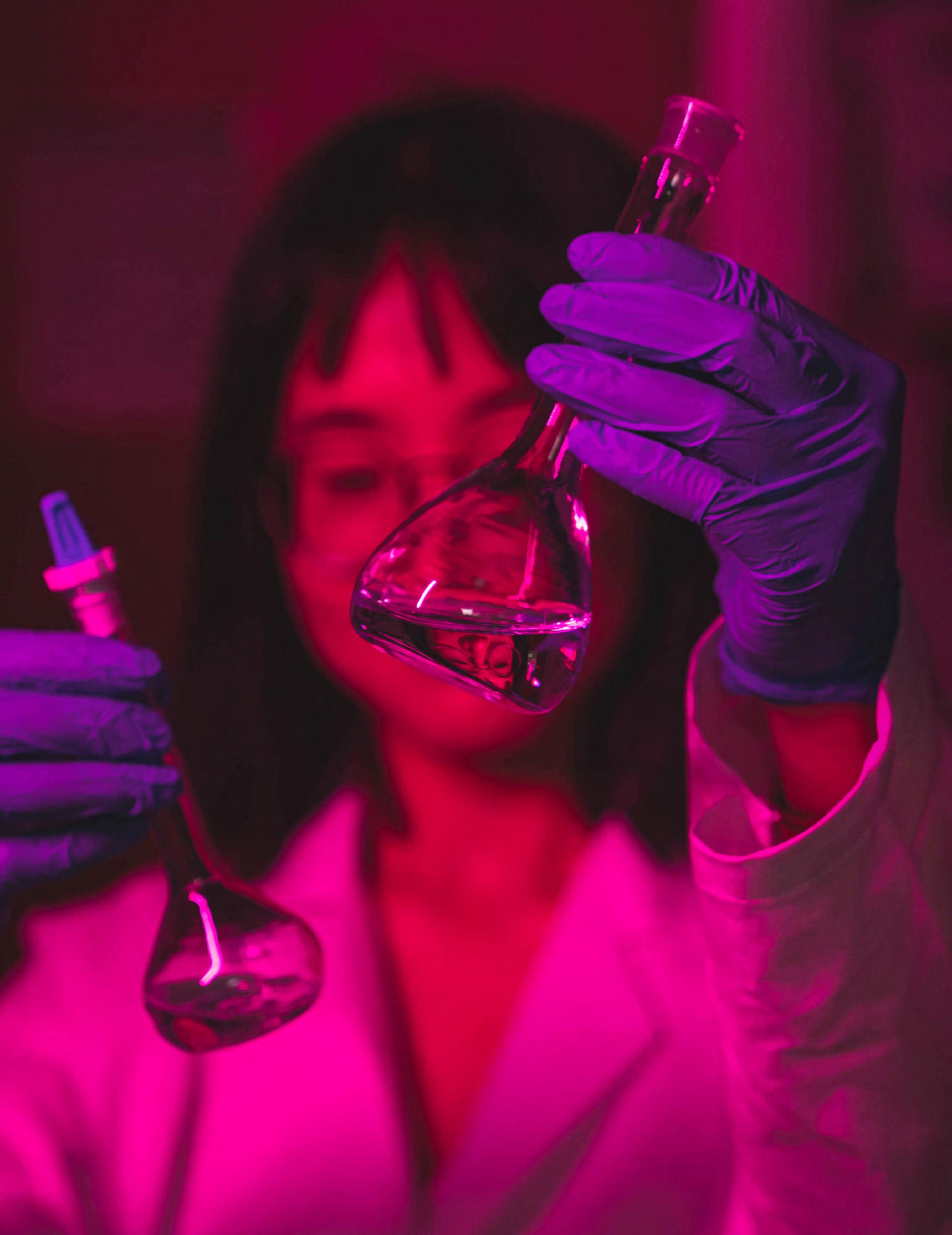
50 PARAMETERS Fall 2022
BY STEPHEN GREENWELL
As the need for quality engineering increases in the 21st century, the Cullen College of Engineering has strove to keep pace by investing in vibrant, promising academic talent. added faculty members for the 2021 aca demic year, and another 12 for 2022. The Cullen Col lege of Engineering is committed to increasing its headcount, to ensure that our faculty remains di verse when it comes to ideas, cultural backgrounds and life experiences – all of which are important for world class research and high-quality instruction of students.
 University of Houston Cullen College of Engineering
University of Houston Cullen College of Engineering
Cullen
13
ENGINEERED FO R WHAT ’S NEXT.
51

EARTH, MOON AND BEYOND POWERING THE 52 PARAMETERS Fall 2022
FOR HARISH SARMA KRISHNAMOORTHY,
Assistant Professor of Electrical and Computer Engineering at the Cullen College of Engineering, it was his experiences in industry combining with his undergraduate work that inspired his research interests – the realization that any kind of alternative energy needs to be able to interact with other power systems.
“When I worked in the industry for GE Energy in India in the area of power conversion and analog electronics, I started realizing that I really liked analog electronics –circuit components, and planning with that, the technical challenge,” he said. “Around 2007, there was much more talk of renewable energy and electric vehicles, and you know, an important component to all of that is the power conversion system.”
“Without power conversion, you cannot really get energy from or efficiently from solar panels and wind turbines, you cannot charge electric vehicles, you cannot run mo tor drives in electric vehicles, because power electronics is an essential component. With those alternative ener gies expanding, all these exciting prospects came in, and
I thought, 'Wow, it would be great to pursue research in this field,' because it interests me on the technical front.
It's a lot of analog circuit design. And on the other hand, it's going to be an important area of research going ahead in the future.”
A HIDDEN ASPECT OF EVERYTHING
Krishnamoorthy noted that power electronics and con version is taking place in practically every modern device – for example, a wall charger providing power to a laptop or cell phone battery, which in turn powers individual ap plications. He's also part of a research group looking at a power system for the Moon.
“I'm looking at a project there where you take a power system to the moon, but you know, you don't have coal and natural gas and all this, what you have is solar ener gy,” he said. “From solar energy, you need to have some form of conversion to a usable form of electricity. And for that power, a power electronics-based system is a must.”
Krishnamoorthy added, “The U.S. Department of Energy reported that by 2030, almost 80 to 85 percent of every electron generated is going to pass through some form of power electronics circuit. That really drives me.”


 Harish Krishnamoorthy works in his lab with graduate students.
Harish Krishnamoorthy works in his lab with graduate students.
I'm a believer that in our applied field, we cannot afford to just unnecessarily waste time because technology is moving so fast.
HARISH KRISHNAMOORTHY
University of Houston Cullen College of Engineering
53
THE PATH TO CULLEN
While doing his doctorate studies at Texas A&M, Krishna moorthy interned at different points for Google, Ford Re search and Schlumberger. However, while he liked the expe rience of each, he knew that a position outside of academia would require him to narrow his interests. After earning his Ph.D., he took a job with Schlumberger in Sugar Land, but he applied for an Assistant Professor opening when learning of it from a colleague.
“The University of Houston had an opening for an Assistant Professor, tenure track faculty, in the Electrical Engineering department, where they needed expertise in the field of oil and gas, and renewable energy,” he said. “My Ph.D. research was a lot about renewable energy, then power conversion with wind, solar battery storage. At Schlumberger, I had been looking at aspects of power conversion for oil and gas, like extreme environment of 200 degrees Celsius. I thought, 'Okay, this is probably perfectly tailor made for me.'”
When it came to his development in academia, Krishnamoor thy identified people inside and outside the UH system.
“One is, of course, my Ph.D. advisor and Professor from Tex as A&M University, Dr. Prasad Enjeti. He has been not just a Ph.D. advisor but an advisor in terms of life and how to go about business in the U.S. He helped me determine the pros and cons of industry and academia, and he always encour aged me to go to industry and to have a look at the industry. He said in applied fields like ours, it is extremely important to
have some industry experience, because otherwise we won't know what the practical relevance is of what we do.”
Krishnamoorthy added that his very first interest in research came from his undergraduate professor, Kinattingal Sund areswaran, Ph.D., from the National Institute of Technology (NIT) in Trichy, India.
“The desire to research came from a senior design project in undergrad,” he said. “Professor Sundareswaran was very motivated to do research.”
At the Cullen College of Engineering, Krishnamoorthy said that Kaushik Rajashekara, Ph.D. – Distinguished Professor of Engineering, and a member of the National Academy of Engineering – had been a mentor for him.
“He has been a tremendous support, I would say, and it's more than a support,” Krishnamoorthy said. “We basically meet on a regular basis for anything, whether to discuss about personal or technical aspects. It has been, thankfully, a very smooth ride. The Chair of the ECE department, Dr. Badri Roysam, has been another tremendous support both at the professional and personal levels since I joined UH.”
Although he only joined the faculty in 2017, Krishnamoorthy has already been recognized with a variety of internal and external awards. Internally, he won a 2022 Research Excel lence Award and a 2021 Teaching Excellence Award from the Cullen College of Engineering.
Outside of UH honors, Krishnamoorthy has been recognized as an OTC Emerging Leader for 2022 and a senior member of the IEEE. He is also one of 84 early-career engineers select ed to take part in the prestigious National Academy of Engi neering's Grainger Foundation Frontiers of Engineering 2022 U.S.-based symposium, hosted by Amazon, in Sept. 2022. In 2020, he received a $2.5 million grant from the U.S. Depart ment of Defense to develop compact electric power systems for radar and other equipment. In 2022, he was awarded a ~$1 million grant from the U.S. Department of Energy (AR PA-E) to build state-of-the-art power conversion systems for high temperature applications such as downhole oil & gas.
Krishnamoorthy was also proud of the success several of his students have had, highlighting the work of one of them, Hussain Sayed. Sayed received an outstanding paper presen tation award at the 2022 IEEE Applied Power Electronics Con ference, and he is also the organization's 2022 recipient of the Joseph John Suozzi INTELEC® Fellowship Award in Power Electronics.
 Harish Krishnamoorthy
Harish Krishnamoorthy
54 PARAMETERS Fall 2022
LOOKING TO THE FUTURE, TO SPACE
Going forward, Krishnamoorthy said he was excited for the opportunity to continue his research, and to help develop and shape students.
“One of the benefits of being at UH is the ability to work with really bright and motivated students. Whether it is courses, or in the research lab, I like to be very open to everyone. I'm a believer that in our applied field, we cannot afford to just unnecessarily waste time because technology is moving so fast. If a Ph.D. has to take like three, three and a half years, we have to quickly adapt and then work on areas that are really relevant to the industry.”
When it comes to research, Krishnamoorthy identified growing renewable energy systems and hydrogen energy as fields he was interested in, pointing at the $10 million gift that the university received from Shell to create the Energy Transition Institute.

“They are looking at how to have better carbon capture fa cilities, or better hydrogen-based energy storage facilities. Such things are very, very critical. The second thing is 5G communication, and as an extension, you have quantum computing. Right now, they are at a very early stage of the technical aspects of quantum sensing, with physics itself being investigated in a lot of sense. Once that is done, then you start looking at the practical implementation, and that's where our research will come in more. There will be a lot of challenges in those areas to make future computers faster and more efficient.”
Finally, Krishnamoorthy acknowledged interstellar travel ramifications as being on his mind as well.
“Another one of my passions is looking at the Moon and Mars,” he said. “Developing the power systems and pow er conversion systems for lunar applications, that's another major thing that I'm looking forward to.”
Harish Krishnamoorthy works in his lab with graduate students.
University of Houston Cullen College of Engineering
55

TAKING CHANCES 56 PARAMETERS Fall 2022
UNDERGRADUATE YEARS

“When I was doing my undergraduate, I was not, you know, your standard stellar student at all,” she said. “My high school was a tough, military-style science high school that admits students with a national exam. We had 40 hours per week of all science classes, and then 20 hours per week of enforced self-study. It was military style. Everyone looked the same – Sometimes, when I'm looking at pictures from high school, I can't immediately differentiate who is who.”
The boarding schools in Turkey are government institutions, Zerze said, and while they're free, they have a very rigid curriculum. Because she wasn't allowed to take art classes or music – creative outlets – she gravitated toward playing Bridge after graduation, and took to it naturally.
“I was nominated for national teams of Turkey three times,” she said. “Being nominated for national teams required training. I was playing bridge 16 hours a day, I wasn't go ing to any of my college classes. I was just barely getting through the exams. I haven't failed any of my classes be cause of the high school education that I had, I was able to pass, but barely pass. So I wasn't your stellar student at all. But then life goals change.”
However, Zerze realized that she didn't want to stay as a pro fessional Bridge player, and refocused on her studies. She was able to graduate with a 3.16 GPA out of 4.0 – OK, but it limited her options when it came to planning her doctorate.

GÜL H. ZERZE, Assistant Professor in the William A. Brookshire Department of Chemical and Biomolecular Engineering at the Cullen College of Engineering and CPRIT Scholar in Cancer Research, is the first to acknowledge her unusual route to academia, and it starts with boarding school in Turkey, competitive Bridge games, and an advisor that took a chance on her.
Gül Zerze
University of Houston Cullen College of Engineering
57
PH.D. YEARS
“That GPA is not getting you to most of the graduate schools in the U.S., to be honest,” she said. “But my eventual Ph.D. advisor noticed the trend that I was having, how my low grades improved and went to 4.0, 4.0, 4.0 as the years went along. He was able to notice the trend and the potential that I have, that no one else did.”
That's how Zerze found herself at Lehigh University in Beth lehem, Pennsylvania, studying with Jeetain Mittal. Since Zer ze earned her doctorate in 2017, Mittal has also moved to the area, taking a Professor position in the Artie McFerrin Department of Chemical Engineering at Texas A&M.
“I did my Ph.D. at Lehigh, because it was the only school that admitted me,” she said. “Jeetain was the one who was able to see the potential that I wasn't even aware of probably. He did that thing that no one else did for me. Once you become a stellar person, everyone else will be after you but he did a harder job that changed my life.”
CURIOSITIES IN SCIENCE AND ENGINEERING
Zerze noted that while she had what she considered “tra ditional chemical engineering” training, with research in a metabolic engineering and industrial biotechnology lab, she first started to get interested in biology during her under graduate research.

“That's when I noticed how fascinating any living matter is,” she said. “I was working with a whole bunch of microbes. But along the way, as I was working on them, I was noticing how fascinating living organisms in general are.”
“That's the most important decision every graduate student makes, once in their life, in which discipline you're going to do your Ph.D., because that's probably going to be your life,” she said. “I knew that I was physically exhausted, working in an experimental lab. It was demanding and physically chal lenging, so I was like, 'Alright, I'm going to do computations from this point on.'
Zerze notes that she considers her change in focus as more a matter of tools changing than interests.
“I'm not doing experiments, but my fascination hasn't changed,” she said. “I'm still very curious about similar sub jects, just my tools to study that changed. The tools that I feel more comfortable with are computational and statisti cal mechanical simulation tools.”
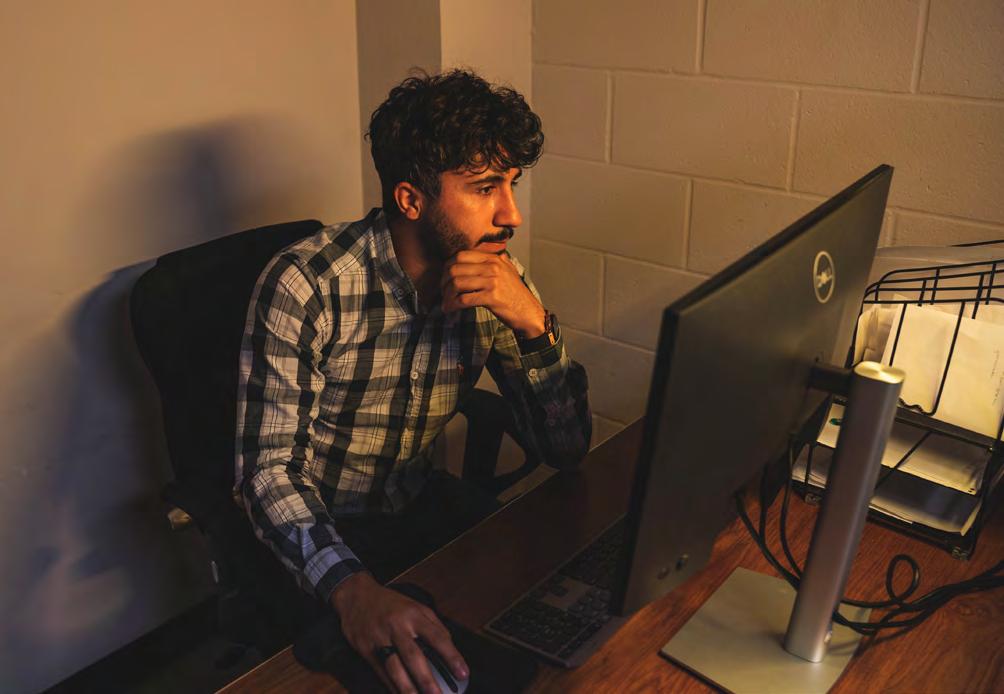 Zerze continued with her research work in chemical engi neering as she finished her master's degree, but she was faced with a decision to make as she explored earning a doc torate degree.
Gül Zerze and her graduate students conducting research in the lab.
Zerze continued with her research work in chemical engi neering as she finished her master's degree, but she was faced with a decision to make as she explored earning a doc torate degree.
Gül Zerze and her graduate students conducting research in the lab.
I was working with a whole bunch of microbes. But along the way, as I was working on them, I was noticing how fascinating living organisms in general are.
- GÜL ZERZE
58 PARAMETERS Fall 2022
POSTDOCTORAL YEARS
AND JOB SEARCH
After earning her doctorate at Lehigh, Zerze spent four years at Princeton as a postdoctoral researcher, with her postdoc advisor Pablo G. Debenedetti, Professor of Chemical and Bio logical Engineering, serving as another substantial influence.
“He is also the Dean for Research, so he represents the uni versity. But most importantly, he let me be me,” she said. “He didn't try to turn me into something, like a polished pebble that everyone is going to acknowledge. He instead listened to me and tried to just get to know me by letting me express not only my take on the scientific projects we tackled but also my feelings on social fronts even if it is sometimes childish or sometimes very emotional. His patient, respectful and sup portive attitude eventually transformed a young science en thusiast into a more mature young professional.”
Under Debenedetti, Zerze said she had a lot of freedom to study whatever interested her. While doing this research, she frequently collaborated with Frank Stillinger, a visiting research collaborator and scientist at Princeton following a 41-year career with Bell Laboratories.
As a Ph.D. student, she also collaborated with Nicolas Lux Fawzi, a Professor of Medical Science at Brown University; and Robert B. Best, a Senior Investigator in the Computation al Biophysics Section of the Laboratory of Chemical Physics at the National Institutes of Health.
Zerze is candid about her job search, describing it as “brutal,” given the timing. No university hired her in 2019, and few places were hiring in 2020. However, in her third round of applications, she received multiple offers for universities for the Fall 2021 semester.
She picked UH from multiple offers because of her comfort level following an interview with the hiring committee.
“During the interview, I felt so welcome here,” she said. “I instantly knew that I would be a part of this faculty. Quite frankly, in my last round I got multiple offers, but UH was an easy decision. It was the school that I had maximum overlap with in values – the things I care about, and the things my col leagues and the people who recruit me care about. It's never 100 percent overlap, right? But that overlap was maximized at UH.”
Zerze noted that concurrently with accepting the job offer at UH, she was made aware of the Cancer Prevention and Research Institute of Texas (CPRIT) offering grant money to recruit talented professionals to Texas colleges and universi ties. Zerze was one of 12 grant proposals selected by CPRIT, providing her with $2 million to perform research to innovate
computer-aided drug discovery for breast cancer.
Before coming to UH, Zerze said she knew Jeremy Palm er, Ernest J. and Barbara M. Henley Associate Professor, for about five years. She attributed her comfort level with UH to his presence and Jacinta C. Conrad, Frank M. Tiller Profes sor, who helped get across the shared values of the depart ment. Palmer, Navin Varadarajan, M.D. Anderson Professor, and Richard Willson, Huffington-Woestemeyer Professor, are three co-workers she speaks to regularly about her own re search.
She has a similar path to UH as Mehmet Orman, Assistant Professor of Chemical Engineering. She also liked how genu ine and personally caring the newly-hired department chair man Triantafillos J. (Lakis) Mountziaris is.
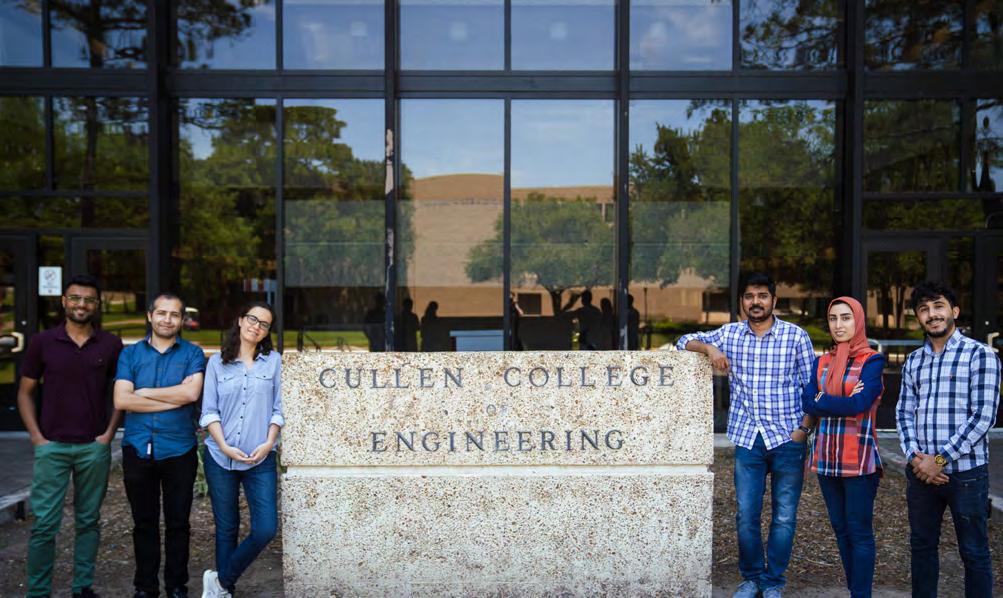
“I felt an immediate personal connection,” she said, of meet ing with her colleagues. “I met with probably the entire facul ty before coming here and everyone was genuinely welcom ing both towards me and my family. It meant everything to me.”
Above: A student works in Gül Zerze's lab.
Below: Zerze's research team takes a break for a group picture outside the Cullen College of Engineering.
 University of Houston Cullen College of Engineering
University of Houston Cullen College of Engineering
59

STABLE GROUND 60 PARAMETERS Fall 2022
MANY ACADEMICS can be comfortable sticking strictly to their laboratory, or making incremental improvements to existing research, but that's never been the mindset for Dimitrios Kalliontzis, Assistant Professor of Civil and Environmental Engineering – and that's part of why the Cullen College of Engineering was so appealing to him.
For Kalliontzis, he wants the challenge of tackling new prob lems that haven't been considered before, and bridging the gap between theoretical knowledge, laboratory work and best practices in the field.
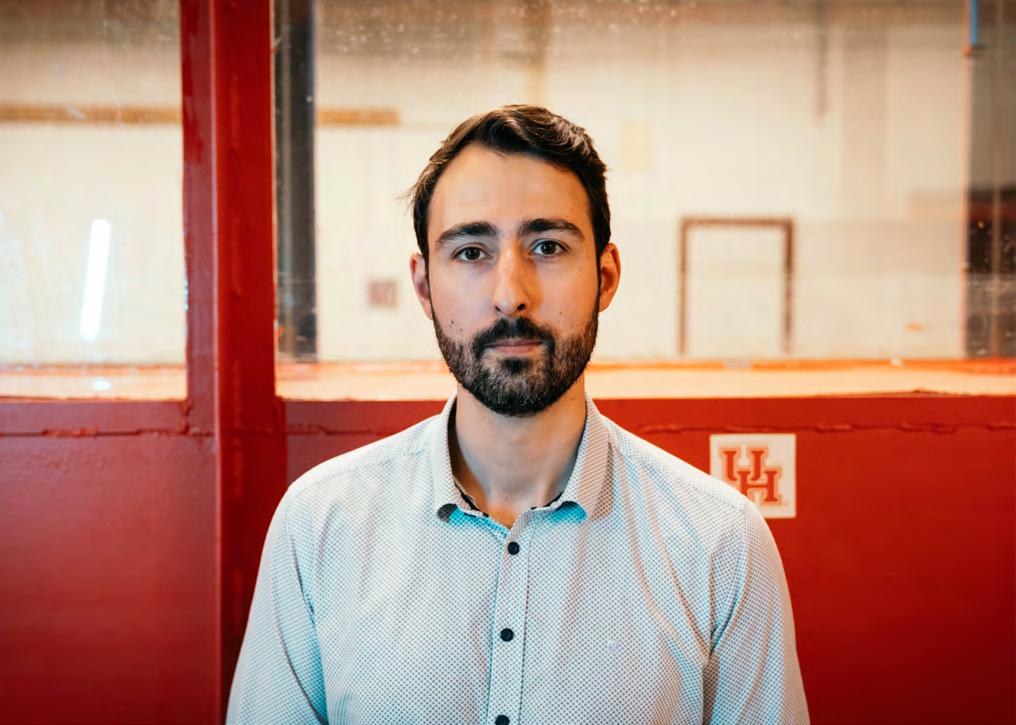
“I'm not a fan of trying to slowly refine problems that have already been addressed to some degree,” he said. “I'm more interested in problems that are new, that nobody has touched on. This is how I want to shape my career on this, which is the reason why I've selected the topics I'm working on right now.”
Kalliontzis added, “This is something, to be honest, that we as civil engineers in the structures area, where we produce research, then sometimes research goes into design codes, but then nobody's actually putting it into practice. So how can we bridge this gap? How can we make sure that the tech nology that we have developed is being applied in practice? In the structural engineering discipline, there is a big gap of where the industry is, and where we are. One of my goals is to bridge this gap.”
CURRENT RESEARCH GOALS
Kalliontzis identified two main areas of research that he's pursuing currently.
“One is on Ultra-High-Performance Concrete and Masonry Structures, where I'm looking for new materials, and how to integrate them into the existing knowledge,” he said. “The second area is slightly different, but not completely unrelat ed, and relates to the fluid structure interaction phenomena. This area is relatively new, there isn't much knowledge cur rently in the United States or globally, on how structures act with fluid flows, like from hurricanes or tornadoes.”
Kalliontzis said this was especially important, considering that according to NOAA, about 40 percent of the American population lives near a coastline.

“Most people are moving or migrating toward the coasts, and therefore it becomes more and more critical to invest in resil iency for coastal structures and their ability to resist waves,” he said. “In general, my research falls under the umbrella of what we call structural resiliency. I feel that resiliency is what will get our infrastructure to the next generation of technol ogy – to build structures that are not only able to resist ex treme events, but are robust and durable in the long term, and that won't need much repair after significant events.”
Earlier this year, Kalliontzis received a pair of grants from the American Concrete Institute and the Prestressed Concrete Institute to study shear design of Ultra-High-Performance Concrete. One of his students, Omar Khalid, also earned a national award, the Paul and Helen Lenchuck Scholarship administered by the National Concrete Masonry Association.
Dimitrios Kalliontzis
University of Houston Cullen College of Engineering
61
ACADEMIC INFLUENCES
Kalliontzis studied rocking wall systems while doing re search as a master's student, but it was more the lack of information – discovering the unknown – that got him in terested in doing more and drives him now.
“This was my first introduction to structural resiliency, and that got me motivated,” he said. “What gets me motivated though is the gap. There is a significant gap of knowledge. There is a lot of lot to be understood. This is what is in triguing, and it's an area that can actually make immediate impact to our society.”
Kalliontzis identified three of his former professors as signif icant influences. First was his master's advisor, Sri Sritharan – Assistant Dean for Research and Wilkinson Chair Profes sor of Interdisciplinary Engineering at Iowa State University. Then, there was Arturo E. Schultz, formerly of the University of Minnesota – where Kalliontzis earned his doctorate – and who is now the Director of the School of Civil & Environmen tal Engineering and Construction Science at the University of Texas at San Antonio. Finally, there was Benson P. Shing, Distinguished Professor at the UC San Diego Jacobs School of Engineering.
“I think those three are the ones that influenced my way of thinking,” he said. “They shaped my background and foun dation, as a researcher and as an engineer. The strongest ed ucational influences were the interactions I had with those
three individuals. They are my mentors even today, being very helpful anytime I need them.”
Kalliontzis stressed that he was always looking for more col laborators when it came to research, in addition to items that he worked on by himself.
“I'm constantly developing collaborations with other univer sities, and even inside the school, I always get involved with interdisciplinary projects,” he said. “A lot of the problems we have in research that also reflect societal needs are in terdisciplinary. Nowadays, it's hard to say that you can com pletely address a problem on your own.”
The University of Houston was appealing to Kalliontzis be cause of some of its unique equipment, as well as the feel ing he got from the department.
“When I was first interviewed here, there's a lot of compli mentary research from the existing faculty structure, and I found good collaborators and a great environment that aligned very well with my research goals. Houston is an area that the infrastructure suffers from hurricanes, an area that correlates well with my research. Also, the infrastructure and laboratories here are unique. The Universal Panel Tester that exists in the lab is unique equipment. It is the only one of its kind in the United States.”
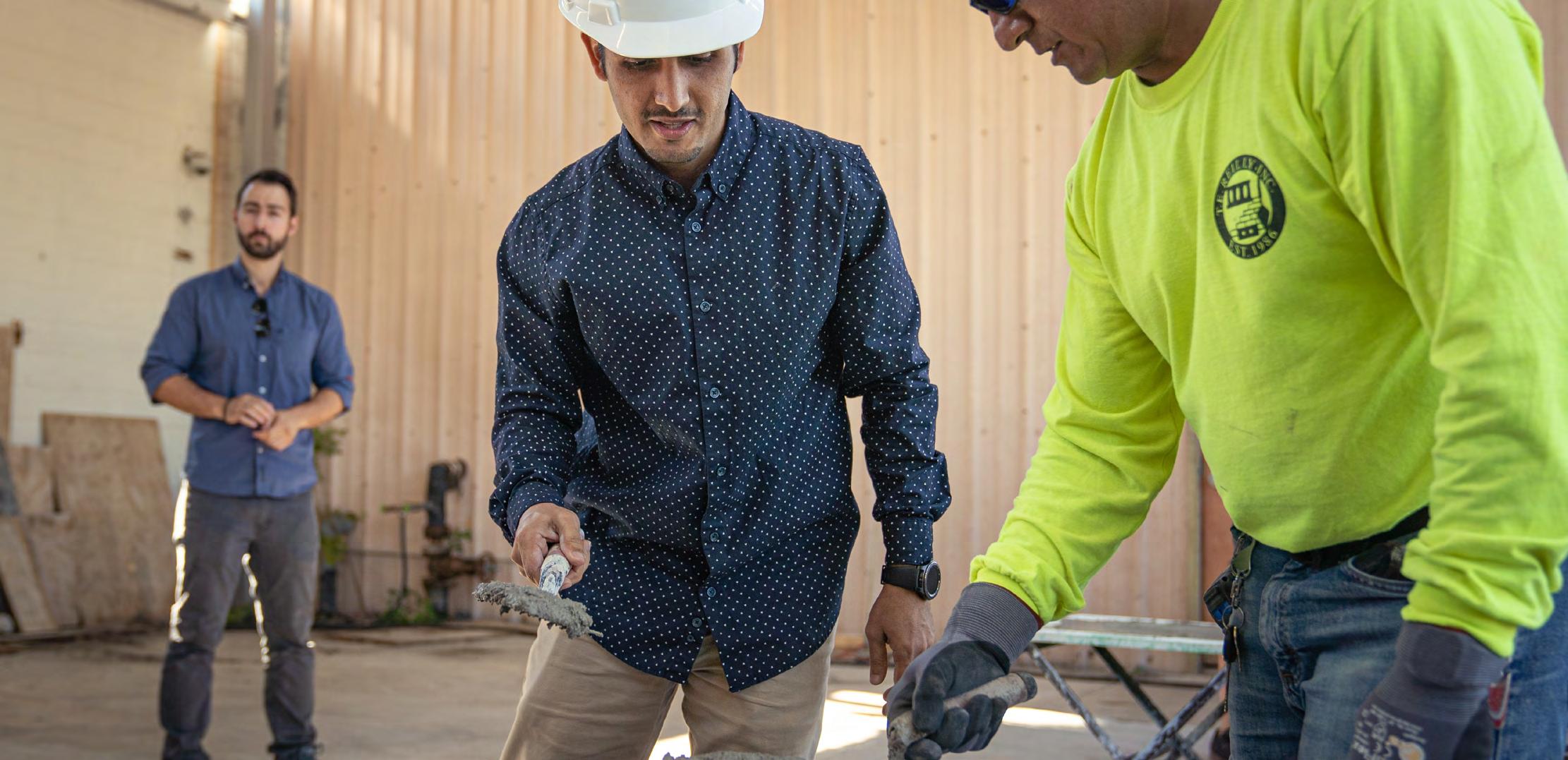 Dimitrios Kalliontzis oversees a graduate student working on Masonry Day, a hands-on day of construction work.
Dimitrios Kalliontzis oversees a graduate student working on Masonry Day, a hands-on day of construction work.
62 PARAMETERS Fall 2022
I'm not a fan of trying to slowly refine problems that have already been addressed to some degree. I'm more interested in problems that are new, that nobody has touched on. DIMITRIOS KALLIONTZIS
 University of Houston Cullen College of Engineering
University of Houston Cullen College of Engineering
-
63
ENGINEERED FO R WHAT ’S NEXT.
To reflect new and exciting developments across various fields, the Cullen College of Engineering has hired new professors in the past five years in all of its departments. Here are just a few of the talented faculty members that have joined the University of Houston recently.
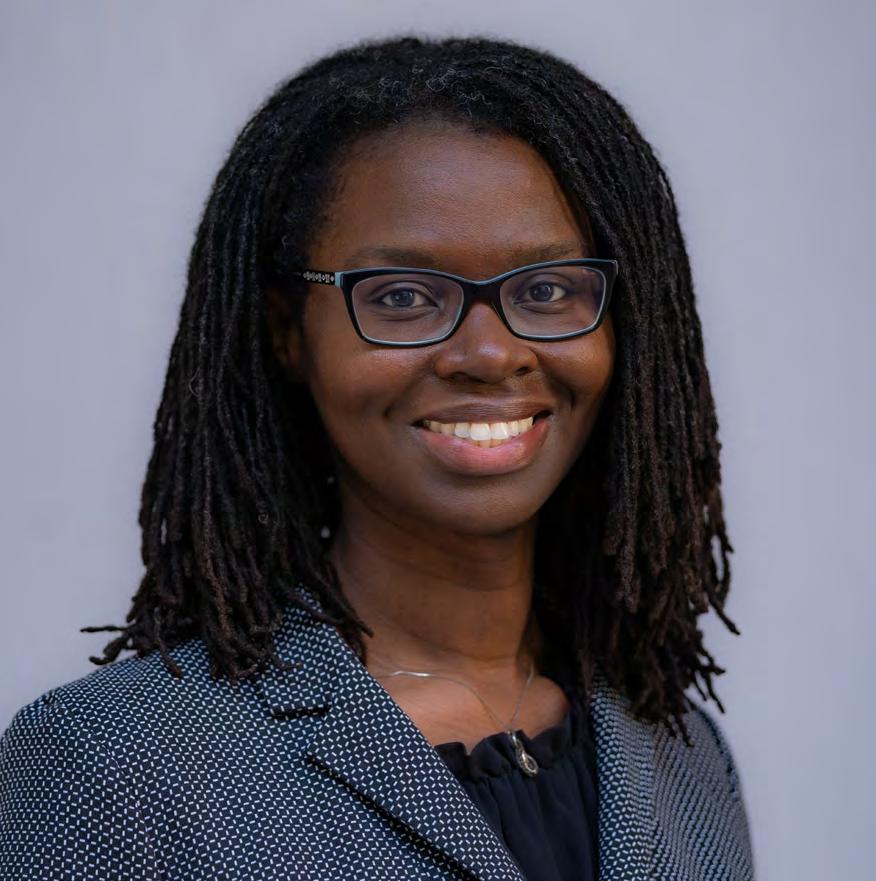

BIOMEDICAL ENGINEERING:
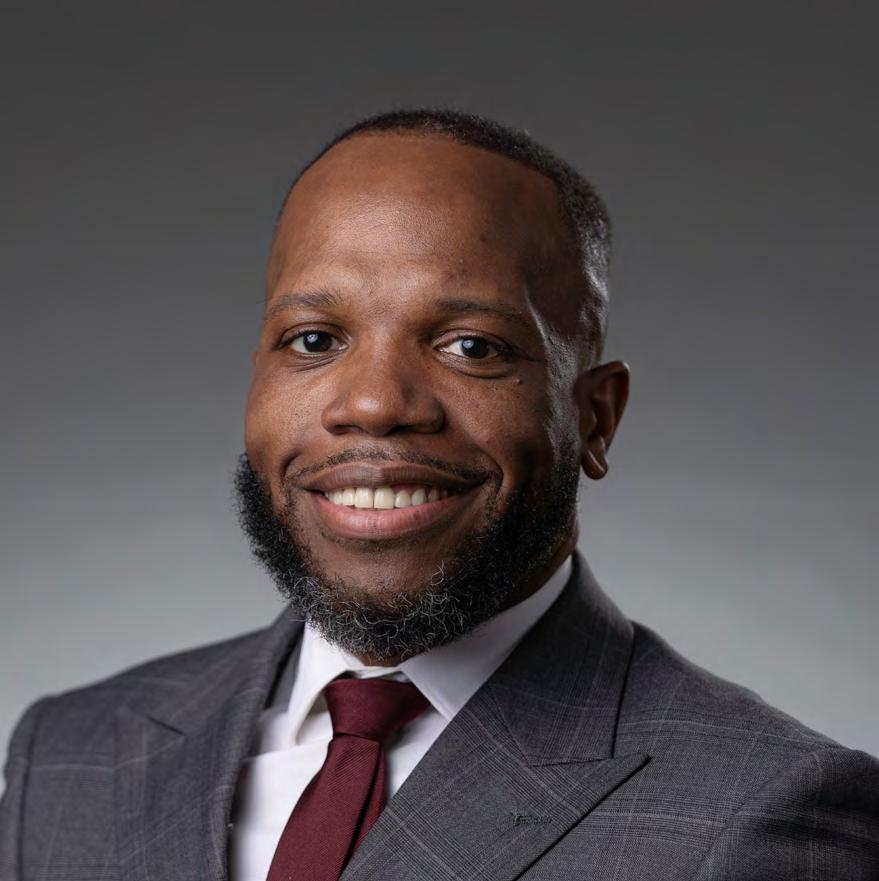 CHEMICAL AND BIOMOLECULAR ENGINEERING: Jerrod Henderson joined the William A. Brookshire Department of Chemistry & Biomolecular Engineer ing in September 2021, after earlier being hired as Director of the Program for Mastery in Engineering Studies. Henderson earned the 2020 Black Engineer ing Educational Leadership Award by the U.S. Black Engineer and Technology Leadership Magazine, and by the Council of Engineering Deans of Historically Black Colleges and Universities.
CIVIL AND ENVIRONMENTAL ENGINEERING: Pietro Milillo worked as a scientist and postdoctoral fellow for the NASA Jet Propulsion Laboratory in Pas adena, California, before being hired by UH. Since joining the university for the Fall 2021 semester, he has received a $675,000 grant from NASA to study flood risks on beaches and dunes.
Renita Horton joined the College in January 2019, with her research interests focused on better un derstanding the factors leading to heart disease and sickle cell anemia. She was also selected as one of the 2021-22 recipients of the Ralph E. Powe Junior Faculty Enhancement Award from the Oak Ridge As sociated Universities consortium.
CHEMICAL AND BIOMOLECULAR ENGINEERING: Jerrod Henderson joined the William A. Brookshire Department of Chemistry & Biomolecular Engineer ing in September 2021, after earlier being hired as Director of the Program for Mastery in Engineering Studies. Henderson earned the 2020 Black Engineer ing Educational Leadership Award by the U.S. Black Engineer and Technology Leadership Magazine, and by the Council of Engineering Deans of Historically Black Colleges and Universities.
CIVIL AND ENVIRONMENTAL ENGINEERING: Pietro Milillo worked as a scientist and postdoctoral fellow for the NASA Jet Propulsion Laboratory in Pas adena, California, before being hired by UH. Since joining the university for the Fall 2021 semester, he has received a $675,000 grant from NASA to study flood risks on beaches and dunes.
Renita Horton joined the College in January 2019, with her research interests focused on better un derstanding the factors leading to heart disease and sickle cell anemia. She was also selected as one of the 2021-22 recipients of the Ralph E. Powe Junior Faculty Enhancement Award from the Oak Ridge As sociated Universities consortium.
64 PARAMETERS Fall 2022
ELECTRICAL AND COMPUTER ENGINEERING:



PETROLEUM ENGINEERING:
 Xingpeng Li came to the University of Houston in 2018, with his researching focusing on leveraging sophisticated methods in the areas of optimization, network science, data science and machine learn ing to advance power energy systems. Since then, he has been an author on more than 30 papers, and since 2017, he has been cited more than 500 times.
MECHANICAL ENGINEERING: Daniel Floryan, hired for the Fall 2021 semester, has landed a significant NSF grant. Floryan received $243,798 to research “The effect of suspended par ticles on Rayleigh-Bénard buoyant thermal convec tion.”
INDUSTRIAL ENGINEERING: Ying Lin joined the College in 2017, with her research focusing on data analytics, quality engineering and healthcare. In August 2020, she received a $435,017 grant to continue research on identifying underlying genetic contributors to some forms of psychiatric illness.
Kyung Jae Lee came to the Cullen College of Engi neering in 2017, following two years at the Lawrence Berkeley National Laboratory. She earned an NSF CAREER Award in 2021 for $508,722 in funding, fol lowed by a pair of grants in July 2021 for more than $350,000.
University of Houston Cullen College of Engineering
Xingpeng Li came to the University of Houston in 2018, with his researching focusing on leveraging sophisticated methods in the areas of optimization, network science, data science and machine learn ing to advance power energy systems. Since then, he has been an author on more than 30 papers, and since 2017, he has been cited more than 500 times.
MECHANICAL ENGINEERING: Daniel Floryan, hired for the Fall 2021 semester, has landed a significant NSF grant. Floryan received $243,798 to research “The effect of suspended par ticles on Rayleigh-Bénard buoyant thermal convec tion.”
INDUSTRIAL ENGINEERING: Ying Lin joined the College in 2017, with her research focusing on data analytics, quality engineering and healthcare. In August 2020, she received a $435,017 grant to continue research on identifying underlying genetic contributors to some forms of psychiatric illness.
Kyung Jae Lee came to the Cullen College of Engi neering in 2017, following two years at the Lawrence Berkeley National Laboratory. She earned an NSF CAREER Award in 2021 for $508,722 in funding, fol lowed by a pair of grants in July 2021 for more than $350,000.
University of Houston Cullen College of Engineering
65
The ‘Electrifying’ PRADEEP SHARMA
UH Mechanical Engineer Elected to National Academy of Engineering
 BY LAURIE FICKMAN
BY LAURIE FICKMAN
For actors, there are Oscars. Singers have Grammys. And for engineers? The highest award, the most cov eted lifetime honor, is election into the National Academy of Engineers. They don’t elect many. Of the mil lions and millions of engineers in the world, this year the NAE chose 111 new members and 22 international members.
One of them is Elon Musk, founder and chief executive of SpaceX and Tesla Motors. One is Satya Nadella, chairman and chief executive of Mic rosoft Corp., following Bill Gates. One of them is the co-founder and chair man of vaccine giant Moderna, Inc., Noubar B. Afeyan.
And one of them is Pradeep Sharma, M.D. Anderson Chair Professor and department chair of Mechanical Engineering at the University of Houston Cullen College of Engineering.
FACULTY
66 PARAMETERS Fall 2022
It is rarefied air to be sure.
Sharma’s election brings to 16 the number of NAE members at the University of Houston.
“This is very, very meaningful because it is the highest honor an engineer can receive," Sharma said.
Academy membership honors those who have made outstand ing contributions to "engineering research, practice, or educa tion, including, where appropriate, significant contributions to the engineering literature" and to "the pioneering of new and developing fields of technology, making major advancements in traditional fields of engineering, or developing/implementing innovative approaches to engineering education."
In announcing Sharma’s election, the academy noted his estab lishing the field of flexoelectricity, leading to the creation of new materials and devices and insights in biophysical phenomena.

Nature has a few materials, called piezoelectrics, that can covert mechanical forces into electricity and vice-versa. Imagine artifi cial muscles that can move due to electrical signals and sense objection when a force or mechanical strain is applied. Flexoelec tricity is a relatively understudied, exotic phenomenon that has the potential to provide similar functionality as piezoelectrics.
“Nature has provided us very few piezoelectric materials even though their applications in energy harvesting and in making sensors is very important. What we did was use theory to de sign materials that perform like piezoelectric ones, so that they can create electricity,” said Sharma.
In other words, he can turn rubber into electricity and that leads to untold applications in the field of soft, life-like robots.
Sharma employs theoretical and computational approaches to understand physical phenomena across multiple disciplines— from materials science to biology. He uses methods of applied mathematics, continuum mechanics, atomistic and quantum simulations, among others, to carry out his research.
The same mathematical framework created by Sharma also works to understand biological membranes, such as those re sponsible for hearing, because for the hearing mechanism to work, the membranes of ear hair cells must convert mechanical motion into an electrical signal. His associated work has been applied to how some mechanics sense magnetic fields or artifi cial materials that can wirelessly harvest electrical energy from the remote action of magnetic fields.
“The recognition of Professor Sharma by the National Academy of Engineering highlights a career full of outstanding research that has contributed to the understanding of engineering and helped uncover solutions for some of the world’s most signif icant problems,” said Paula Myrick Short, former UH senior vice president for academic affairs and provost.
Sharma has worked his entire professional academic career at

This is very, very meaningful because it is the highest honor an engineer can receive. SHARMA
Top: Pradeep and Haleh together at University of Maryland, College Park, where they both earned their doctorate degrees. Bottom: Pradeep and Haleh at the 2021 Engineering Alumni Association Gala.
PRADEEP
University of Houston Cullen College of Engineering 67
UH since 2004, after three years as a research scientist at Gen eral Electric. Still, after decades of discoveries and ages of acco lades, membership in the NAE has humbled Sharma.
“This was hard to believe and is only now sinking in,” said Shar ma, of when he received the announcement. “This is very, very meaningful because it is the highest honor an engineer can re ceive, and I've always looked up to the ones who have been mem bers of the NAE, and I never thought I would be one of them. That’s not a cliché. I really mean it. It’s a very emotional feeling.”
The University is excited, too.
“Induction into the National Academy of Engineering is the latest of many distinguished honors achieved by Dr. Sharma over the last decade, including being named a Fulbright Fellow, receiv ing the ASME Melville Medal, the James R. Rice Medal and the Charles Russ Richards Medal. He is also the only engineer in 2020 to receive the nationally prestigious Guggenheim Fellowship,” said Amr Elnashai, UH vice president for research and technolo gy transfer. “We are very proud of Dr. Sharma’s accomplishments culminating in being elected to the NAE. To be so comprehensive ly recognized is not only a testament to his intellect but also of the intellectual environment that exists in our great University.”
Of course, the first thing Sharma did when he got the news was call and tell his partner in work and life, his wife, Haleh Ardebi li, Bill D. Cook Professor of Mechanical Engineering, who works in a similar field, creating flexible batteries.
“She was very, very happy too. That is how you become suc cessful, supporting one another like this. She seemed as proud of me as she is when our son achieves something." No surprise their 19-year-old is studying to be an engineer.
In fact, it was Ardebili that encouraged Sharma (the husband) to become a Ph.D, when he thought he just wanted to get a master’s degree and go to work. Meeting his wife in graduate school changed all that and Sharma credits her for the inspira tion to earn a doctorate and his Ph.D. advisor for making him the scientist that he is now.
Sharma also credits the University and the Cullen College of Engi neering, which includes his colleagues for their unwavering sup port of his work, without which nothing would be possible, he said.
“I also can’t speak highly enough about my mentors in the sci entific community who have supported my work. It truly takes a village to achieve success in our field,” said Sharma.

After a lifetime of such success, Sharma is quick to point out what makes him proudest. “Besides family which includes the unconditional support of my parents, it is my students and col laborators,” he said, of the way he wants to spend his time now.
“Training the next generation of scientists to carry on. I have had my fair share of wonderful mentors and I hope I can be one for others also."
Pradeep Sharma
FACULTY
68 PARAMETERS Fall 2022
Faculty ACCOLADES
Bhowmick Honored With 2022 Melvin Mooney Award From ACS
Anil K. Bhowmick, Ph.D., a research professor at the University of Houston’s International Polymer & Soft Matter Center within the William A. Brookshire Department of Chemical and Biomolecular Engineering, is the recipient of the 2022 Melvin Mooney Distinguished Technology Award.

The award, from the American Chemical Society's Rubber Division and sponsored by Lion Elastomers, honors someone who has exhibited exceptional technical competency by making significant and repeated contributions to rubber science and technology. He was recognized at the Spring Technical Meeting, which took place April 25 to April 28, 2022, in Warrensville Heights, Ohio.
Bhowmick’s highly cited work focuses on the development and properties of a series of polymer-based nanocomposites using various nanoparticles, such as clay, nanotubes and graphene.
American Institute of Chemical Engineers' Thomas Baron Award in Fluid-Particle Systems, sponsored by Shell.
The award recognizes an individual's recent outstanding scientific or technical accomplishment, which has made a significant impact in the field of fluidparticle systems or in a related field with potential for cross fertilization with relevance to the topics of interest to the particle technology community.
Mountziaris joined the University of Houston's Cullen College of Engineering in January 2020 from the University of Massachusetts-Amherst, as the new Department Chair for the William A. Brookshire Department of Chemical and Biomolecular Engineering.
Mountziaris explained that his key accomplishments recognized by the Thomas Baron Award are related to the design of reactors for biomass conversion to fuels and chemicals and to the development of a new process for producing semiconductor nanocrystals.
young people entering the field and their development in the early stages of their career.
This is the third prominent honor Akay has received this year. In October, he was awarded an honorary degree from the Silesian University of Technology in Poland. In January, he was named the president of the Institute of Electrical and Electronics Engineers (IEEE) Engineering in Medicine and Biology Society (EMBS).


Mountziaris Granted AIChE’s Thomas Baron Award
Triantafillos J. (Lakis) Mountziaris, Ph.D., the William A. Brookshire Department Chair of the William A. Brookshire Department of Chemical and Biomolecular Engineering in UH’s Cullen College of Engineering, is the 2021 winner of the
Akay Elected To Lead Medical and Biological Engineering Academy
The chairman of the Biomedical Engineering Department at the Cullen College of Engineering has been elected to lead an international academy of his peers through September 2023.
Metin Akay, Ph.D., the founding chairman and the John S. Dunn Endowed Professor of Biomedical Engineering, was elected chairman of the governing council for the International Academy of Medical and Biological Engineering (IAMBE). The organization consists of more than 200 fellows who are recognized for their exceptional contributions to biomedical engineering.
The main objective of the academy is to promote the fields of Medical and Biological Engineering, and to encourage
Belarbi Earns American Concrete Institute Service Award
Abdeldjelil "DJ" Belarbi, Ph.D., Hugh Roy and Lillie Cranz Cullen Distinguished Professor in the Civil and Environmental Engineering Department, is one of the recipients this year of the Delmar L. Bloem Distinguished Service Award from the American Concrete Institute (ACI). He is the first University of Houston professor to receive the honor.
The Distinguished Service Award was established in 1969 to recognize noteworthy work on ACI technical committees. This is the third time that Belarbi has been recognized by the ACI. In 2011, he received the Joe W. Kelly Award – renamed the Clyde E. Kesler Education Award in 2022 – which is given for outstanding contributions to education in the field of concrete. Belarbi earned the American Concrete Institute Chapter Activities Award in 2006. He has been a Fellow of the ACI since 2000.

Rajashekara Elected As Foreign Member of CAE
Kaushik Rajashekara, a Distinguished Professor in the Electrical and Computer Engineering Department at the Cullen College of Engineering, has gained another prestigious
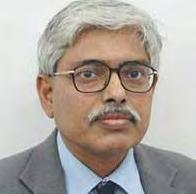 University of Houston Cullen College of Engineering
University of Houston Cullen College of Engineering
69
membership affiliation, thanks to his visits and his lectures in China, which started about 18 years ago.
The Chinese Academy of Engineering (CAE) is the highest honorary and advisory academic institution in that nation's fields of engineering sciences and technology, with prestige similar to the U.S. National Academy of Engineering (NAE). Rajashekara was elected for the CAE, which is the highest academic title in China.
In addition to his membership in the CAE, Rajashekara is also a member of the NAE (2012) for contributions to electric power conversion systems in transportation, and a Fellow of the U.S. National Academy of Inventors (2015). He is also a Foreign Fellow of the Indian National Academy of Engineering (2012).
In 2019, the Institute of Electrical and Electronics Engineers' Power Electronics Society presented him with the inaugural Vehicle and Transportation Systems Achievement Award. This was followed by the IEEE Medal for Environmental and Safety Technologies in 2021.
accelerator program.
In addition to being a member of the cohort, Shih is a Fellow of the Society of Photo-Optical Instrumentation Engineers (SPIE), and a senior member of the National Academy of Inventors, the Optica (formerly Optical Society of America) and the Institute of Electrical and Electronics Engineers (IEEE). A winner of a National Science Foundation CAREER award, he also serves as an Associate Editor for the Optica Optics Express, and the SPIE Journal of Nanophotonics. He has published more than 120 papers and holds 18 issued U.S. patents.
Han Chosen as ACM Distinguished Speaker, Named Highly Cited Researcher
Zhu Han, a Moores professor in the Electrical and Computer Engineering Department at the Cullen College of Engineering, has been selected for a three-year term as a Distinguished Speaker by the Association for Computing Machinery.

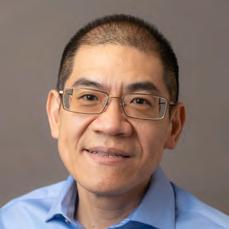
Krishnamoorthy Named OTC Emerging Leader
Harish Sarma Krishnamoorthy, Ph.D., an Assis tant Professor in the Elec trical and Computer Engineering Department at the Cullen College of Engineering, is part of the 2022 class for the Offshore Technology Conference's Emerging Lead ers Program.

Shih Selected For TMCi Accelerator
Wei-Chuan Shih, Ph.D., along with Dr. Steven Lin of M.D. Anderson Cancer Center, are part of the 2022 Accelerator for Cancer Therapeutics annual cohort. According to Texas Medical Center Innovation (TMCi), the effort is comprised of Texas-based startups working to address the world's most significant cancer challenges with novel technologies and treatments. Shih is a Cullen College of Engineering Professor in the Electrical and Computer Engineering Department. They were chosen to further develop Scenexo as part of the nine months of clinical and business development education and advisement they will receive from the
The program recognizes young professionals with fewer than 10 years of experience in the offshore energy sector. Since joining UH’s Department of Electrical and Computer Engineering in 2017, he has further expanded his contributions to the electrification of offshore technologies through research and workforce development. He is also an Associate Director of the Power electronics-Energy storage-Microgrids and Subsea Electrical Consortium (PEMSEC) at UH, which is funded by several major energy companies, such as Chevron, Shell, TechnipFMC and others. Krishnamoorthy has more than 75 publications in refereed journals/conferences, including OTC.
Han is the first of two professors from the University of Houston to receive this honor.
According to the ACM, their speakers come from a wide range of disciplines –academic sources like Stanford University and McGill, but also, vastly different industries, like IBM, Microsoft, Sony Pictures and Raytheon. The organization is affiliated with about 140 speakers currently.
Han's research interests include wireless resource allocation and management, wireless communications and networking, game theory, big data analysis, security and smart grid. In November 2019, he was elected as an AAAS Fellow, and he has also received an NSF CAREER award and the IEEE's 2021 Kiyo Tomiyasu Award for early to mid-career contributions. Han has been a Distinguished Member of the ACM since 2019.
Han was also identified by the Institute for Scientific Information™ at Clarivate as one of 2021’s Highly Cited ResearchersTM. Han has been cited 52,947 times, according to Google Scholar, with 37,933 citations since 2016. He has an H-Index of 91 in the past five years. He was the 2021 recipient of the Institute of Electrical and Electronic Engineers' Kiyo Tomiyasu Award.
He was pleased to be recognized by Clarivate again, first qualifying for the ranking in 2017, and earning the distinction every year since.
FACULTY
70 PARAMETERS Fall 2022
ADVENTURES ABROAD:
Becker Awarded Prestigious Humboldt Fellowship
BY STEPHEN GREENWELL
A Cullen College of Engineering professor will be extending his stay in Germany to collaborate with international research ers, after being picked for the Alexander von Humboldt Research Fellowship, which started in January 2022.
Aaron T. Becker, Ph.D., an Associate Pro fessor in the Electrical and Computer En gineering Department, will have the op portunity to conduct research in Germany for six to 18 months, which can be divided into three sessions within three years. The fellowship is typically granted to five to 10 applicants per year – only about 25 to 30 percent of the total pool, according to the Humboldt Foundation.
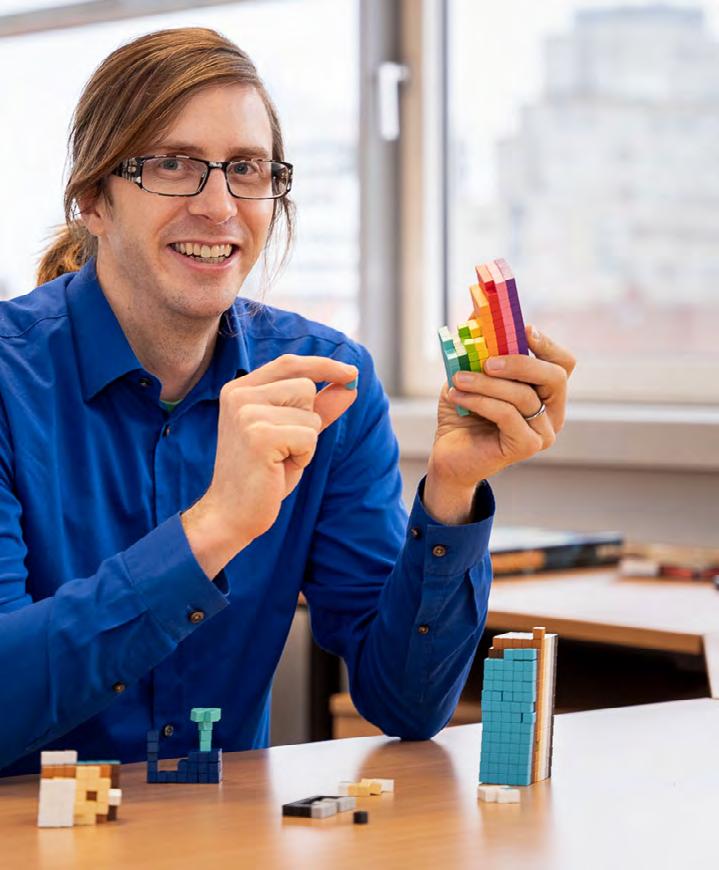
Since the summer of 2021, Becker has been the guest of professor Sándor Fekete at the Institut für Betriebssysteme und Rech nerverbund, Abteilung Algorithmik, Tech nische Universität Braunschweig – The Institute for Operating Systems and Com puter Networks, Algorithms Department, at the Technical University in Braunschweig,
Germany. He taught the fall 2021 semester remotely, and has taken a sabbatical to fo cus on the fellowship opportunity.
Becker said the seeds for earning this fellowship were planted when he was a post-doctorate researcher at Rice Universi ty in 2013.
“I met Sándor Fekete, my current host at Braunschweig, and we made a video about controlling a swarm of robots,” Becker said. “This video led to a string of papers. My lab is dedicated to building robots and robot prototypes, while his lab is a world leader at algorithm design and proofs of complexity. It has been a fruitful partnership for almost a decade.”
Becker noted that the collaboration has worked in both directions, as he hosted Fekete in the past. This connection and an other led to what he felt was a strong appli cation for the fellowship.
“He stayed at UH at the Hilton for a week while my family were Faculty in Residence at Moody Towers, and I think almost every one in my lab got at least one new research idea from him,” Becker said. “We talked about my upcoming sabbatical and the merits of Germany. Also, a collaborator of mine at UT Dallas – Dr. Min Jun Kim – ex plained how he had been awarded the von Humboldt fellowship several years ago and offered to support my application as a letter writer. Dr. Fekete also wrote a strong letter.”
Becker added that he was told that he had won the fellowship in an amusing way.
“The Alexander von Humboldt organization sent a large box containing a map, a Ger many phrase book, a German travel book, and a ‘von Humboldt necktie,’” he said. “It felt like Christmas! The first thing I did was tell my wife, and the next was to thank my letter writers!”
Exploring internationally isn't new to Beck er, and he does have German roots in his family.
“As a Ph.D. student, my wife Elana and I took a summer off for an eight-week back packing trip across Europe. Elana loves lan
guages, and was excited about spending my sabbatical in Germany,” he said. “On both my mom and dad’s side, our most re cent immigrant ancestors came from Ger many in 1906. For as long as I can remem ber, my grandpa had a picture on his wall of the ship his mother came across the Pacific on as a 6-year-old. My dad still loves his 1967 VW bus. As I child I remember being fascinated by the German engineering that enabled an engine the size of a dorm micro wave to propel a family, and the canoe we would strap to the roof.”
While Becker doesn't speak German, he's been doing his best to pick the language up when he can. His family managed to get a head start on him in this regard.
“My Grandma taught be how to sing 'Oh Tannenbaum,' but that was the extent of my language learning,” he said. “For the last 560 days I’ve been using Duolingo to pick up a little German. During the pandemic ev eryone in my family except me enrolled in the Deutsche Samstagsschule Houston for a school year. I was the designated school bus driver, so I couldn’t attend class.”
Once he was in Germany, with his kids set tled in school there and the research proj ects growing in November, he and his wife took - and passed - an eight-week intensive language course.
While he completes the fellowship, Becker said he hoped he and his family could take advantage of the opportunities it will provide.
“My goal is that my family will grow closer as we face the challenge of learning a new language and culture,” he said. “I’d like to use the opportunities this award offers, in particular, the chance to visit world leaders in robotics in Europe. Due to Covid-19 can celing several years’ worth of conferences, it has been a long time since I’ve seen ro botics experts outside of Texas, so this is a great opportunity. I’m also hoping to study some deep learning, and some calculus of variations.”
University of Houston Cullen College of Engineering 71
NEW PROFESSIONALS TO ITS RANKS
BY STEPHEN GREENWELL
The Cullen College of Engineering is happy to announce 12 hirings in a variety of depart ments and roles for the 202223 academic year.
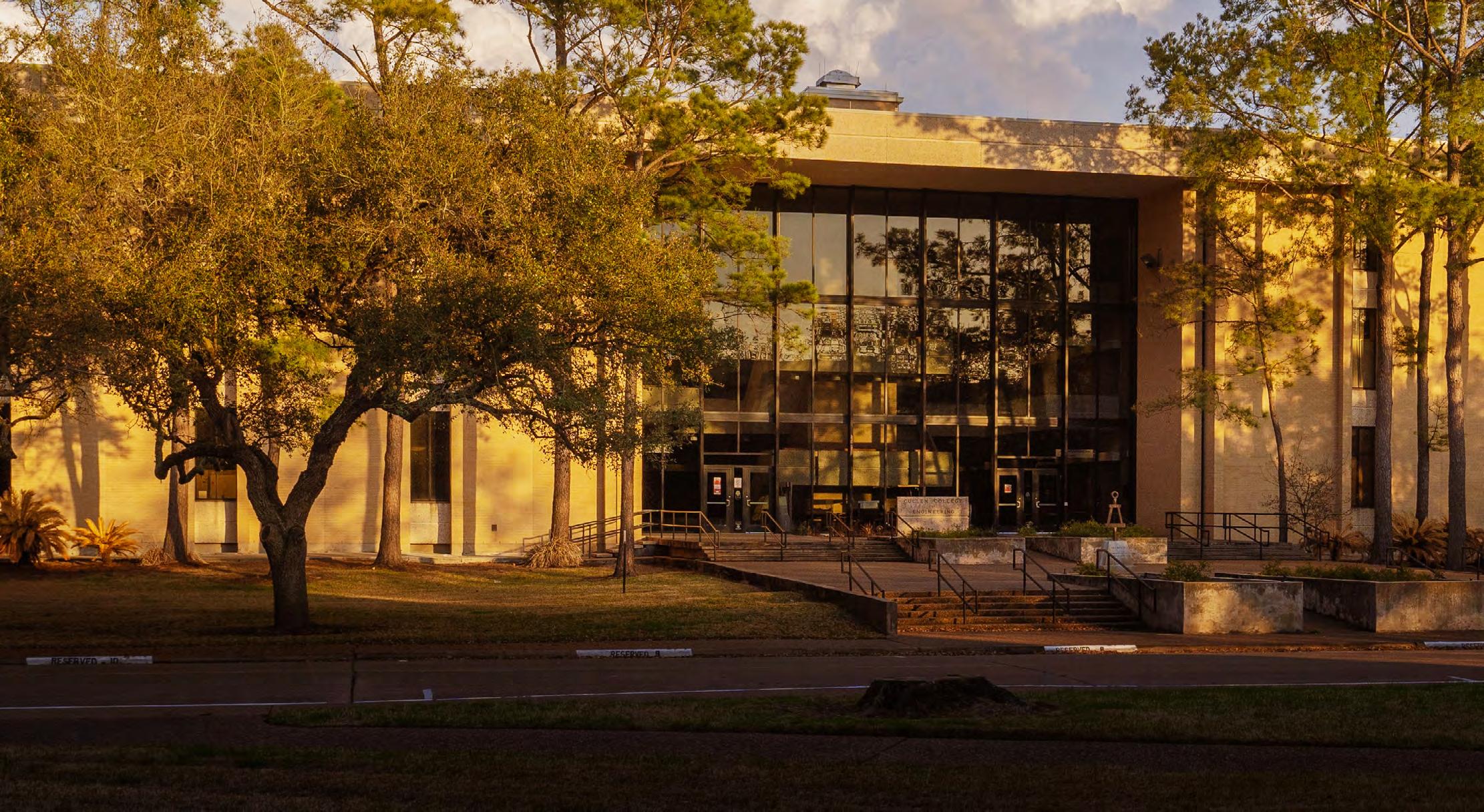
Personnel is sorted alphabeti cally by department, and then by last name.
Read on to learn more about the faculty lineup:
Zhengwei Li Assistant Professor, Biomedical Engineering
A 2017 doctoral graduate of the University of Colorado, Li spent the past year working as a postdoctoral fellow at Northwestern Univer sity, researching the fabrication of wireless, optogenetic electronics for neuroscience research. Li also served as a postdoctoral re search associate at the University of Illinois for three years.
Ruda Zhang Assistant Professor, Civil and Environmental Engineering
Zhang earned their doctorate in Civil En gineering from the University of Southern California in 2018. Zhang was employed by Duke University for the past three years, as a postdoctoral fellow and an Assistant Research Professor in the Department of Mathematics.
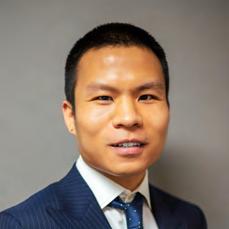
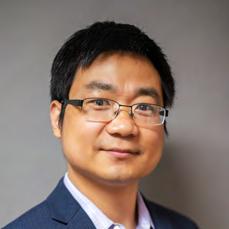
Surui Xie
Assistant Professor, Civil and Environmental Engineering
Xie earned his doctorate in Geology at the University of South Florida in 2020. For the past two years, he was a postdoctoral scholar at the Scripps Institution of Oceanology at UC San Diego.
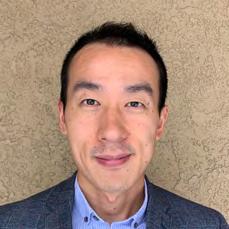
Biresh Joarder
Assistant Professor, Electrical and Computer Engineering
Joarder earned his doctorate in Electrical and Computer Engineering from Washington State University in 2020. For the past two years, he has been an NSF Computing Inno vation Postdoctoral Fellow at Duke University.
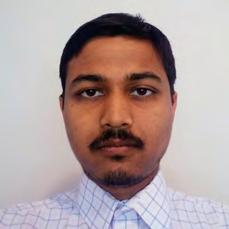
FACULTY
CULLEN ADDS 12
72 PARAMETERS Fall 2022
Xiang joins UH after being employed as an As sociate Professor at Texas Tech and Lamar Uni versity. Xiang earned an NSF CAREER Award in 2020, as well as Texas Tech's Whitacre Engi neering Research Award in 2021. Xiang earned her doctorate in Industrial Engineering from the University of Arkansas in 2009.

Xu comes to UH after being employed as an Assistant Professor at Mississippi State University and the University of Texas-Rio Grande Valley. His research projects have drawn funding from the U.S. Department of Energy and NASA. Xu will join the college in January 2023.

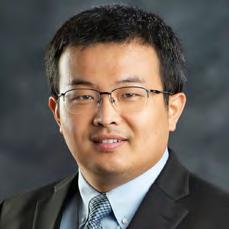
Also, four Instructional Assistant Professor positions have been filled by employees already hired as full-time lecturers. These four positions required the applicants to apply and compete for them against a pool of candidates, sep arate from the traditional faculty promotion and tenure process.
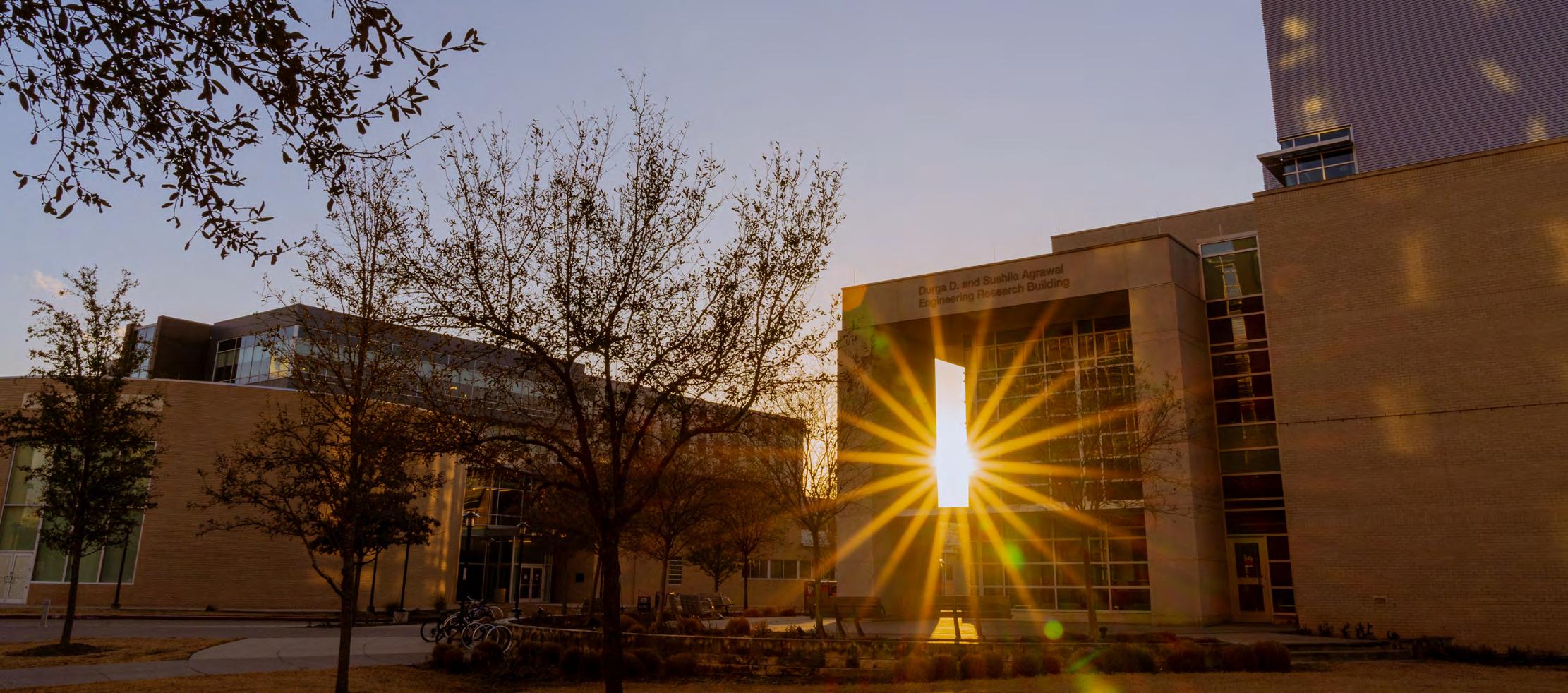
Landon earned her B.S. in Mechanical Engi neering from Princeton University in 2012, and a master's degree with high distinction in Business Administration from the Harvard Business School in 2018. Since 2019, she has served as the Vice President of Strategic Fi nance for Panorama Education in Boston. A Houston area native – the valedictorian of the 2008 Friendswood High School class –Landon also attended UH's G.R.A.D.E. Camp.
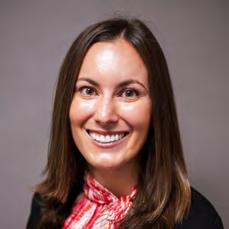
Wen earned his doctorate in Aerospace Engi neering and Mechanics from the University of Minnesota in 2019. For the past three years, he has served as a postdoctoral researcher at the Lawrence Berkeley National Laboratory.
Gulin Aksu, Marsha Kowal and Jennifer Luna Singh each joined the college in 2019. They earned their doctorates from the University of Nebraska-Lincoln, Cornell University and Rice Uni versity, respectively. Venkata Kota joined the faculty in 2016 as a lecturer in Electrical and Computer Engineering, after completing her doctorate at the University of Houston.
Yisha Xiang Associate Professor, Industrial Engineering
Alexandra Landon Professor of Practice, Mechanical Engineering
Ben Xu Assistant Professor, Mechanical Engineering
Mingjian Wen Assistant Professor, William A. Brookshire Department of Chemical and Biomolecular Engineering
University of Houston Cullen College
of Engineering 73
GANESH THAKUR – NAI FELLOW
Ganesh Thakur, Distinguished Professor of Petroleum Engi neering and director of Energy Industry Partnership, was official ly inducted as a Fellow of the academy during the NAI’s annual meeting in June. Election to NAI Fellow is the highest professional distinction accorded solely to academic inventors.
Thakur is a pioneer in carbon capture, utilization and storage (CCUS), a vital emissions reduction technology. His patent on fore casting performance of water injection and enhanced oil recovery (EOR) using a hybrid analytical-empirical methodology provid ed a much faster approach and served as an alternative to more time-consuming reservoir simulation. His team is continuing to push the research envelope for CCUS employing world-class lab research, simulation, machine learning and artificial intelligence.
Thakur, a member of the National Academy of Engineering, was recruited to UH in 2016 after almost four decades of industry experience with Chevron. The same year, he was awarded a $3 million grant from the Texas Governor’s University Research Ini tiative. This was matched dollar for dollar by UH, making a total research budget of $6 million.

Thakur also serves as the director for Energy Industrial Partner ships at the University of Houston. This center represents efforts in upstream and midstream as it applies to important applications and will have an immense impact on the state of Texas in the field of energy. As a principal investigator, Thakur has secured external industrial research funding of $5 million in less than five years.
Under his leadership at UH, researchers have performed exten sive research on reservoir management and Carbon Capture and Sequestration (CCS) pilot project for Oil India Ltd. Thakur demon strated using carbon dioxide captured from nearby petrochemical plants to boost oil recovery in several fields in the Indian state of Assam, to reduce the country's carbon footprint and increase the country’s ability to fulfill its energy needs.
"This ambitious partnership has offered clear benefits for both Oil India and for the University of Houston," said UH President Renu Khator. NATIONAL ACADEMY INVENTORS
FACULTY
Three faculty members of the Uni versity of Houston Cullen College of Engineering have been named Fellows and Senior Members of the National Academy of Inventors (NAI). The three faculty, Ganesh Thakur, Navin Varadarajan and Hadi Ghasemi, were all inducted during the NAI’s Annual Meeting in June. Read on for more infor mation about these outstanding faculty and their respective accomplishments Three Faculty Named Fellows and Senior Members of
OF
74 PARAMETERS Fall 2022
NAVIN VARADARAJAN – NAI SENIOR MEMBER
The research developments from the Single-Cell Lab of Navin Varadarajan, M.D. Anderson Professor in the William A. Brook shire Department of Chemical and Biomolecular Engineering, have been recognized again with his election to Senior Member status of the National Academy of Inventors.

Varadarajan was notified of the honor in early February. He said he was thankful to receive it, but he was quick to acknowledge the work of his students and collaborators when it came to the award.
“The honor is a reflection of the hard work, creativity, and dedica tion of the students and postdocs that work with me,” he said. “I am fortunate to have worked with amazing mentors, colleagues, and collaborators throughout my career.”
Varadarajan joined the Cullen College of Engineering in 2010, after postdoctoral fellowships at the Massachusetts Institute of Technology and the University of Texas in Austin, which is where he earned his doctorate in Chemistry. Varadarajan completed his M.S. in Organic Chemistry at the India Institute of Science, and his B.S. in Chemistry from the University of Madras.
When asked to describe his research, Varadarajan said, “Our re search is focused on harnessing the power of the immune system for treating cancers and for designing therapeutics and vaccines.”
In September 2021, iScience published a collaborative work be tween the research teams of Varadarajan and UH pharmaceutics professor Xinli Liu about the development of an intranasal vac cine that provides durable local immunity against inhaled patho gens. Varadarajan's most recent paper in Biotechnology Bioengi neering examines the usage of salicylic acid as a biotechnological tool for nuclear localization.
In October 2017, he earned a Career Development Award from the Department of Defense Peer Reviewed Cancer Research Program and in 2013 the Melanoma Research Alliance Stewart-Rahr Young Investigator Award. He has also won Cullen College of Engineer ing Teaching Excellence Awards in 2017-18 and 2012-13.
HADI GHASEMI – NAI SENIOR MEMBER
For many academics, there can be a disconnect between the fun damental research being done and the commercial applications of that research. But for Hadi Ghasemi, Ph.D., Cullen Associate Pro fessor of Mechanical Engineering, he sees this as a vital compo nent when it comes to research benefiting society. Ghasemi is the co-founder and CTO of Elemental Coatings, which applies his re search and his team's research to anti-icing products. In addition to private investments, the company received a $750,000 grant from the Air Force Research Laboratory and Boeing recently as well.
Ghasemi joined the Cullen College of Engineering for the Fall 2014 semester, following a postdoctoral associate position at the Mas sachusetts Institute of Technology. He earned his doctorate in Me chanical Engineering from the University of Toronto in 2011.
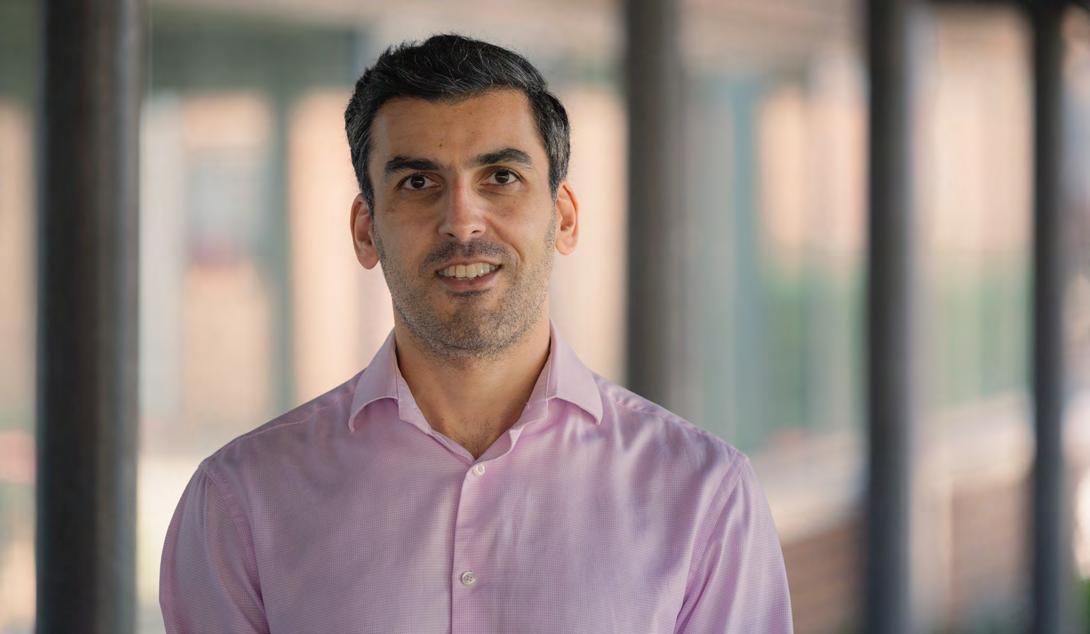
When asked how he best generates ideas, Ghasemi said they usu ally come to him when he's not focused on his day-to-day work.
“Most of the time, they come to my mind when I don't have that much external stimulus,” he said, explaining his process. “Most of the time during the day, you are busy with lots of emails, talking to people... Those are the times that none of these ideas come to my mind. Most of these ideas come to my mind when I'm working out, or when I'm going running. That's a time that I don't need to pay attention to much. And I can think about some of the things that I have in my mind. I have a better self reflection, or internal connection. When you are so busy, and on hectic days, I think it's really hard to come up with new ideas. When I set my schedule for a week, I try to make sure that I have sometimes for internal self reflection to bring these ideas out.”
Ghasemi stressed that performing fundamental research was still very important, but so was connecting it to commercialization when appropriate. This aligns with his mindset as he was grow ing up – He was always interested in building and finding out how things worked.
“That's always been my personality,” he said. “I really like to invent and develop something that I can see its impact on people's life.”
University of Houston Cullen College of Engineering 75
Four Cullen Professors
HONORED WITH UH AWARDS
BY STEPHEN GREENWELL
Four professors at the Cullen College of Engineering have been recognized for their exemplary work via the 2022 Faculty and Staff Awards, administered by the University of Houston's Office of the Provost.
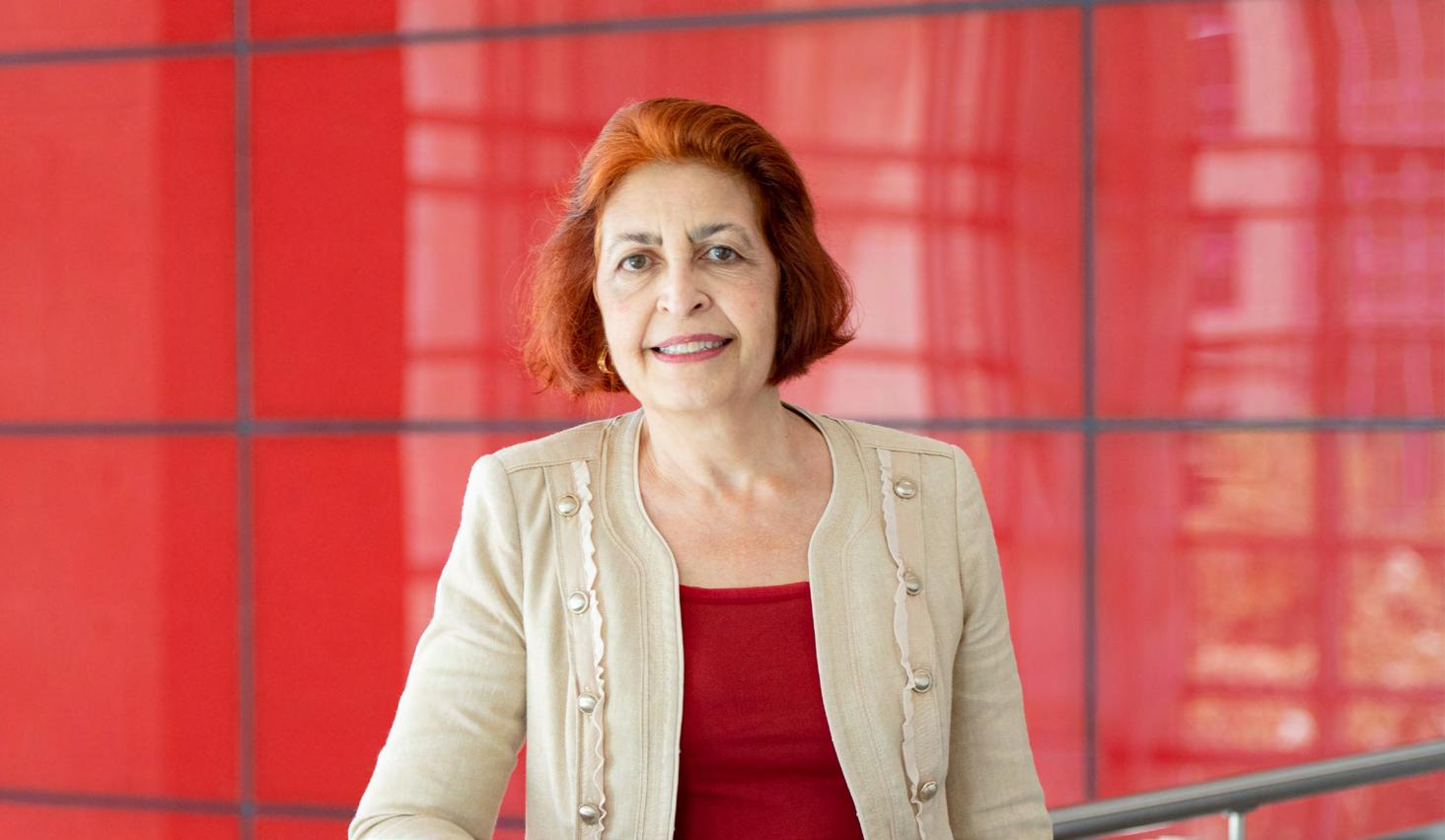
Roberto Ballarini, Thomas and Laura Hsu Professor and Department Chairman of Civil and Environmental Engineering, was given the Global Award. Hanadi Rifai of the Civil Engineering Department was named to a Moores Professorship. Kirill Larin, Professor of Biomedical Engineering, earned one of three Undergraduate Research Mentoring Awards. Jeffrey Rimer, Abraham E. Dukler Professor in the William A. Brookshire Department of Chemical and Biomolecular Engineering, was granted the Outstanding Graduate Mentor Award.
The Global Award is given to tenured or tenure-track faculty who have demonstrated excellence in the promotion of globalization of teaching, research and/
or service. In addition to his department chairman duties, Ballarini also serves as the director of the UH-Dalian Institute. The initiative is expected to lead to increased student enrollment, as well as a rich cultural exchange between the two institutions.

“I am lucky that for the past 37 years my job has allowed me to travel across the globe to teach and conduct collaborative research with colleagues and students in foreign academic institutions,” Ballarini said. “The friendships that developed as a result of my visits, which have been mostly in Europe and Asia, have been truly life-enriching. I am particularly happy to be currently leading the University of Houston-Dalian Maritime University Institute, an ambitious effort that in
the steady-state will deliver our Civil, Mechanical and Electrical Engineering degrees to 1,200 students in China.”
He added, “I am convinced that extending the global reach and impact of an academic institution’s teaching and research paradigms through formal large-scale international collaborations offers promise for improving the human condition. This is because collaborative education-based initiatives, especially during turbulent political times, inevitably lead to friendships, mutual respect and understanding between those involved. In particular, the students will represent future leaders.”
Ballarini also praised the colleagues and support staff he works with regularly.
“The success of the Institute is the result of the efforts of the extraordinary administrative and teaching teams on our Main Campus and on the DMU campus. I would be remiss if I did not mention here the dedication and hard work of Dr. Alejandrina Campanella, the Associate Director of the Institute, and Dr. J.R. Rao, Associate Dean of Undergraduate Programs and Distance Learning.”
Rifai also serves as Associate Dean of Research and Facilities, as well as the director of the Environmental Engineering Graduate Program and the Hurricane Resilience Research Institute.
Hanadi Rifai
Roberto Ballarini
FACULTY
76 PARAMETERS Fall 2022
The Moores Professor’s Program was established to honor fulltime tenured faculty who have achieved the rank of full professor at the University of Houston, and who have made outstanding contributions. The program encourages and supports continued excellence by providing funds for individual career development.
The Office of the Provost, in conjunction with the Office of Undergraduate Research and Major Awards, gives Undergraduate Research Mentor Awards to honor the dedicated practice of undergraduate mentorship and to encourage faculty to support that aspect of the university's mission.
Larin joined the Cullen College of Engineering in 2004. He is a Fellow in the Optical Society (OSA) and the Society of Photographic Instrumentation Engineers (SPIE). From UH, he has previously won two Excellence in Research and Scholarship awards, as well as the Junior Faculty Research Award.
Rimer received the Outstanding Graduate Mentor Award, which recognizes a faculty member who has had outstanding success in mentoring graduate students. The award eligibility criteria is aligned with the Conference of Southern Graduate Schools (CSGS) Outstanding Mentor Award, so he is eligible for the CSGS regional competition in Fall 2022.
Rimer joined the University of Houston in 2009, after earning his doctorate at the University of Delaware and completing a postdoc at New York University. For the 2021-22 academic year, his research group had 31 affiliated members.

2021-2022 Cullen College Faculty and Student Excellence Awards
Teaching Excellence Awards
Patrick Cirino – Chemical and Biomolecular Engineering
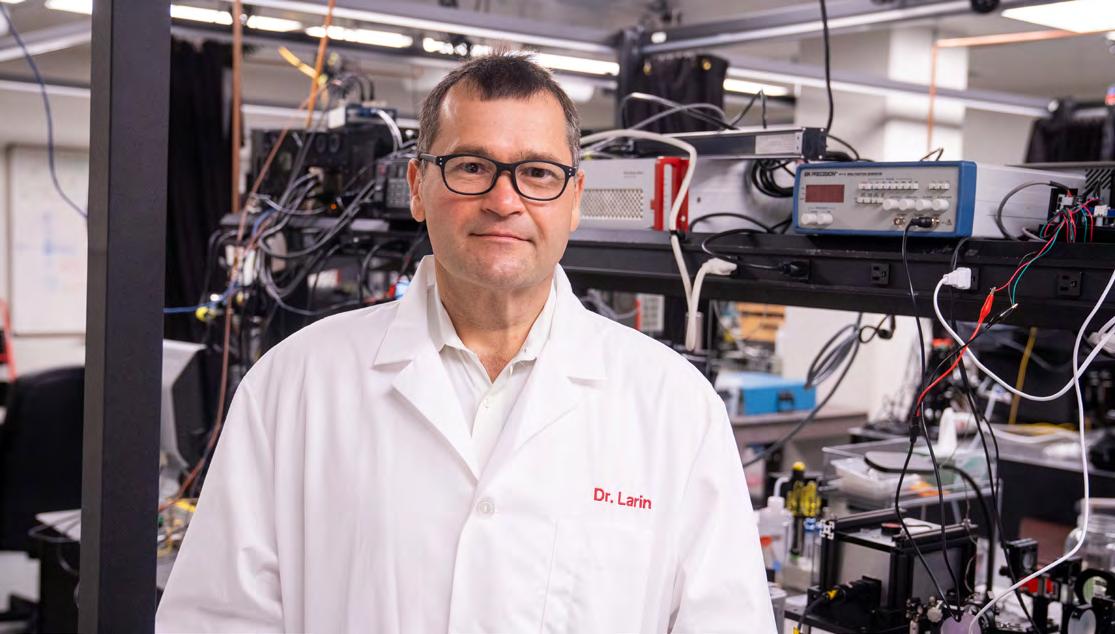
David Mayerich – Electrical and Computer Engineering
Ahmad Sakhaee-Pour – Petroleum Engineering Elias Keedy – Industrial Engineering
Tyler Dean Todd – Mechanical Engineering (Teaching Assistant)
John Tu – Mechanical Engineering (Teaching Assistant)
W.T. Kittinger Teaching Excellence Award
Jae-Hyun Ryou – Mechanical Engineering
Research Excellence Awards
Harish Krishnamoorthy – Electrical and Computer Engineering (Junior-level)
Jeffrey Rimer – Chemical and Biomolecular Engineering (senior-level)
Yan Yao – Electrical and Computer Engineering (seniorlevel)
Andrea Prosperetti Research Computing Faculty Awards
Jeremy Palmer – Chemical and Biomolecular Engineering (faculty)
Chaoxian Qi – Electrical and Computer Engineering (student)
Young Innovator Award
Binh Vu – Chemical and Biomolecular Engineering
Early Innovator Award
Zheng Chen – Mechanical Engineering
Rising Innovator Award
Yingchun Zhang – Biomedical Engineering
Career Innovator Award
Gangbing Song – Mechanical Engineering
Best Dissertation Award
Thuy Le – Chemical and Biomolecular Engineering (1st place)
Furui Wang – Mechanical Engineering (2nd place)
Kirill Larin
Jeffrey Rimer
University of Houston Cullen College of Engineering
77
Benjamin Receives INAUGURAL ASEE ENGINEERING Post Doctoral Fellowship
BY STEPHEN GREENWELL
When Le Shorn Benjamin, Ph.D. initially saw the advertisement for a postdoctor al associate role focused on Engineer ing Education with Jerrod Henderson, Ph.D., Assistant Professor in the William A. Brookshire Department of Chemical and Biomolecular Engineering, she knew that although her background was in ed ucational research, she could transfer her knowledge and skills to the engineering context. In fact, she was excited since taking on new challenges has never been something she has shied away from.

“When I saw the ad I was immediately interested, even though it was on the en gineering side of things,” she said. “But what was interesting to me was that the entry requirement wasn't only a Ph.D. in engineering or engineering education. The post-doc description specifically re quested somebody with either qualitative experience or mixed methods experience. There was also a line item about building and developing an engineering education unit or program. My doctoral research and all the larger parts of my research agen da look at the idea of quality in Ph.D. pro grams, so I thought it would really be an excellent opportunity for me.”
Based on Benjamin’s research interest, Henderson advised Benjamin to apply for the new eFellows program, which is ad ministered by the American Society for Engineering Education (ASEE) with fund ing from the National Science Foundation (NSF). The program places early-career Ph.D.s in engineering fields in university research postdoctoral fellowships. In addi tion to hands-on academic research with a faculty advisor, each fellowship cohort will participate in professional development and mentoring activities designed to pre pare them for future research careers.
Henderson has been pushing the develop ment of Engineering Education at UH and the Cullen College of Engineering, and re cently received a planning grant for an En gineering Research Center. In addition to Henderson’s nod, Benjamin’s application was also endorsed by Department Chair, T.J. (Lakis) Mountziaris, Ph.D. and was ulti mately selected by ASEE for inclusion in the inaugural cohort of the ASEE eFellowship.
Le Shorn Benjamin
FACULTY
78 PARAMETERS Fall 2022
Henderson said that Benjamin had the “right amount of everything” he looks for, when it comes to hiring someone who his research group.
“She has the right amount of passion, re latability, capacity to trailblaze in research, leadership potential and willingness to grow,” he said. “Dr. Benjamin’s research and practice in programmatic quality will also help lay a foundation for a strong en gineering education research focus within my department and eventually will lead to the development of an engineering educa tion program at the University of Houston. Her research proposal is timely. In fact, we
I'm always thinking about, 'Who doesn't have access to the resources that they need to be successful? What does support look like? What do challenges look like? Who needs additional support to become the best version of themselves?' Those are the questions I'm thinking about.
- LE SHORN BENJAMIN
stand to learn directly from her findings and intend to apply them as we develop the Engineering Education program here at UH.”
Benjamin was attracted to UH because of the opportunity to conduct research into doctoral-level Engineering Education programs, but it was an insightful conver sation with Henderson and his research group that sealed the deal. She described the group as collegial and felt comfortable that she would fit in. She noted that she
was also impressed that Henderson stuck to the timeline he had given her for con sideration of her proposal, which she not ed with a laugh wasn’t always the case in higher education.
“I got a good vibe, good energy from that,” she said. “I proposed the idea of examin ing Ph.D. program quality within the lens of engineering education Ph.D. programs. So, the project is situated within his area, but also allows me to extend my own work, I think it was a really good research nexus and Henderson was all for it.”
Benjamin earned her doctorate in Educa tional Leadership from Central Michigan University in 2019. She had earned her Master of Science in Education from Long Island University in 2011, but she decided to pursue her doctorate after practical ex perience as a high school teacher in New York City from 2009 to 2013, and an as sessment officer for the Accreditation Council of Trinidad and Tobago from 2013 to 2016.
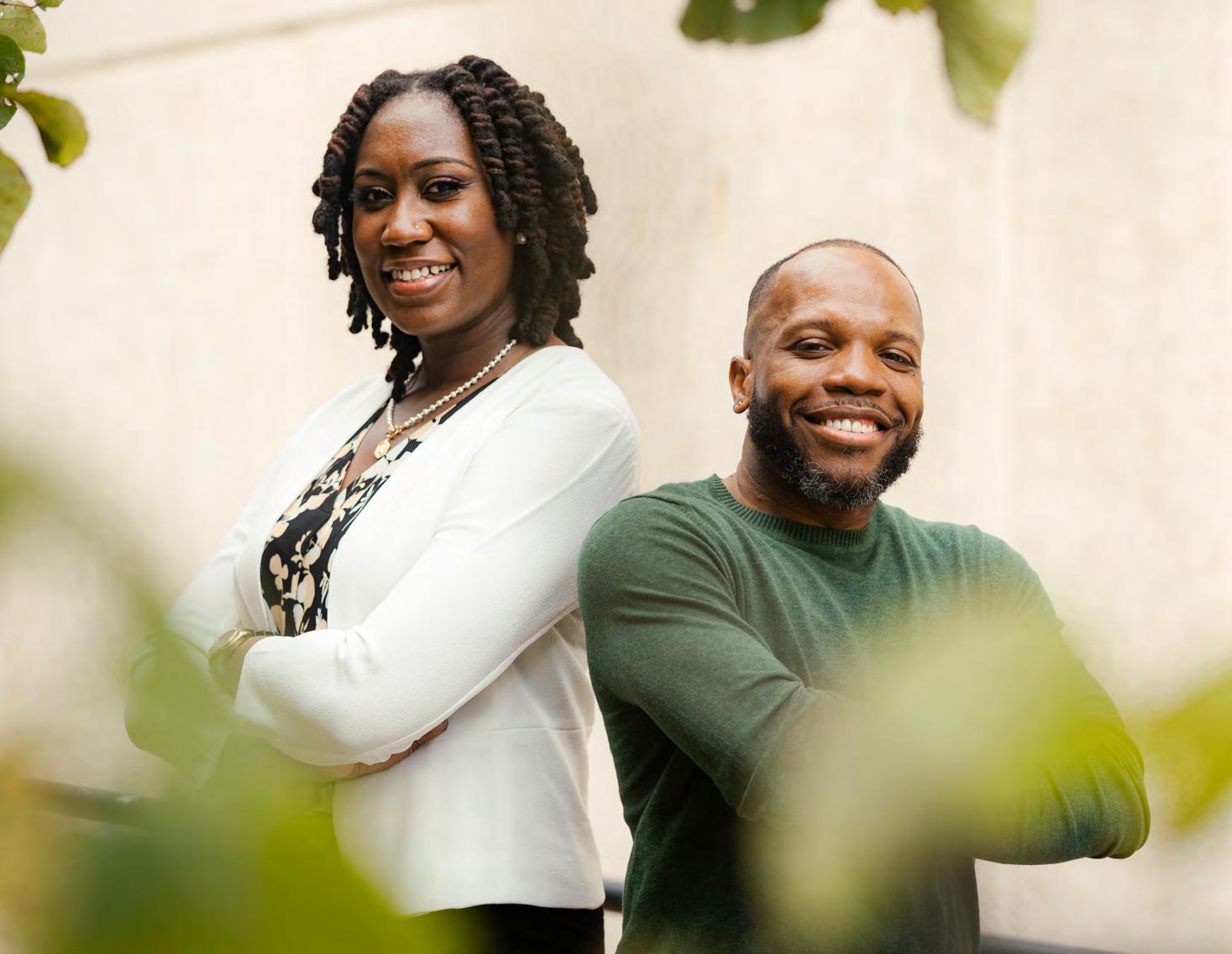
Benjamin has also served as a program administrator for an intergenerational social and youth development program, consulted on higher education program assessments as well as on personnel re
cruitment for an art studio, and, since her high school days, has served as a tutor for students.
“My younger sister she's always talking to me about being brave and stepping out, but I think because I value the transfer ability of my skills, expertise and compe tence, I'm always thinking about, 'How can I apply this skill, this expertise, this experience that I have to novel and new settings? How can I use it to break into something new?'”
Whether it was her informal work as a neighborhood tutor, or more structured experiences like teaching in a high school classroom or conducting research on edu cational quality, Benjamin has always real ized how important it was to have access to high quality education and to have the support needed to excel while pursuing it.
“I think I continue to do that throughout my career in education,” she said. “I'm al ways thinking about, 'Who doesn't have access to the resources that they need to be successful? What does support look like? What do challenges look like? Who needs additional support to become the best version of themselves?' Those are the questions I'm thinking about.”
Le Shorn Benjamin and Jerrod Henderson
University of Houston Cullen College of Engineering 79
A FOUNDATION FOR SUCCESS:
Student Spotlight on Annabelle Koehler
BY STEPHEN GREENWELL
For Annabelle Koehler, a senior student in the William A. Brookshire Department of Chemical and Biomolecular Engineer ing Department at the Cullen College of Engineering and the Honors College, the school has provided her with more than a place for her to earn her undergradu ate degree and to pursue a minor in En ergy and Sustainability.

STUDENTS
80 PARAMETERS Fall 2022
ANNABELLE KOEHLER
When it came to attending the University of Houston, Koehler said the biggest influences on her decision were the financial incentives and the smaller class sizes offered by the school. She was offered an Academic Excellence Scholarship, and in comparison to another school she was considering, she didn't feel like “just a number” in an overwhelmingly large student body.
“Especially being in the Honors College, it's a smaller environment,” she said. “You get to know your professors well, and have better re lationships with them.”
This is especially important to Koehler, given an aspect of her back ground. She attended Santa Fe High School in Texas, and on the fi nal day of school her senior year in May 2018, a mass shooting took place. Eight students and two teachers were killed, and 13 others were injured.
“I tell people that when I decided to go to UH, that was part of God's plan. He knows that if I had gone to another school, I probably wouldn't have stuck with engineering, or maybe even college,” she said. “I had a more difficult transition into college because I had some struggles with post traumatic stress. That having been my last day of school, whenever somebody slammed a door, or whenever topics like that got brought up, it was really hard. Since I had professors that knew me on a more personal level, they were a lot more understand ing if I needed to step out of the classroom, if I needed a break, or if I had an anxiety attack.”
Koehler immersed herself in college activities from the time she en rolled. She earned the Coogs Class of 2022 Freshman Engineering Scholarship, the Roy and Lillie Cullen College of Engineering Schol arship in Spring 2019 and the Honors College Outstanding First Year Student Award in May 2019.
Most recently, she earned the William A. Brookshire Scholarship in Spring 2021. In August 2018, she joined the Honors Engineering Program, and in August 2021, she became the social director of the UH branch of the American Institute of Chemical Engineering, and a member of the Society of Women Engineers.
“I immediately started helping out with recruiting. As an engineer ing ambassador, I helped send emails to prospective students. I gave tours, for the Cullen College of Engineering and the Honors College, and I also have helped with a lot of the female activity,” she said. “I was a counselor for G.R.A.D.E. Camp, a week long camp that we did specifically for young females to get them excited and interested in engineering, as well as Girls Engineering the Future Day.”
Koehler has also held several academic support positions.
“After those volunteering opportunities, I became a chemical process es teaching assistant,” she said. “I was a TA for our Chemical Process es class, which is the first Chemical Engineering course. Now I'm the assistant facilitator for a workshop for that class, where I help lead students through practice problems and get them ready for the tests.
I think it's really important for people in general to know that they can be whatever they want.
University of Houston Cullen College of Engineering 81
Koehler's grandfather originally worked at Union Carbide as an oper ator, but later started his own business doing instrumentation. Koe hler's father joined that company as well, and she would tag along as he worked. After earning her degree in May 2023, she hopes to work in the petroleum or energy industry – She would be the first in her immediate family to earn an engineering degree, and to work as an engineer instead of a contractor or operator.
“Growing up, I sometimes would go with them to the smaller plants, like the Hitchcock Waste Water Treatment Plant. I would go and just spin around in chairs in the control room, and my dad would show me different things. They'd always bribe me to go by promising we could get Mexican food after,” she said, laughing. “They'd be like, 'Oh, we can go to our favorite restaurant El Sombrero after if you come with me to the plant.' So, I kind of grew up knowing I'd become an engineer one day. They always told me that I would become an engineer one day.”
Koehler said that teachers and friends always pointed out that she had an “engineering brain.”
“I'm very analytical and I like things to have a plan,” she said. “I'm very structured and organized. If you saw my planner, I have almost every minute planned out, which is what I have to do because going to school while working part time can be really challenging without that structure.”
The past two years have been especially busy for Koehler. In that time span, she completed two co-ops for the Marathon Petroleum

Because she received support from her family, teachers and peers growing up, Koehler thinks it is important for her to provide similar encouragement to others. It's part of why she's so willing to volun teer her time for various organizations at UH, and part of why she still serves as a gymnastics coach in Santa Fe. She claims gymnastics prepared her for the self-discipline and integrity it takes to endure engineering school and is thankful to be able to instill those values in the gymnasts she coaches currently, including her little sister.
“I think it's really important for people in general to know that they can be whatever they want,” she said. “For example, I never felt like I could not be in engineering because I was a girl. Growing up, I didn't really see that many females in engineering, but I never thought of it as boy versus girl. I just always had a large support group saying ‘You can be an engineer, because you have the mind for it.' I really think that being an engineer is more about the mindset and being able to problem solve versus your gender, obviously.”
She gives thanks to God, her loving family, supporting faculty, and the amazing coaches and mentors she had growing up.
“Without those people, I wouldn't be where I am today,” she said.
Annabelle Koehler
Company – one at the Catlettsburg Refinery in Kentucky, and anoth er at the Saint Paul Park Refinery in Minnesota – and in Spring 2020, a study abroad program in Wales. She's also gone from Annabelle O'Day to Annabelle Koehler, after marrying her husband, Griffin, in May 2021.
STUDENTS
82 PARAMETERS Fall 2022
 BY STEPHEN GREENWELL of Houston Cullen College of Engineering
BY STEPHEN GREENWELL of Houston Cullen College of Engineering
Revitalizing THE THIRD WARD: UH NSBE Receives $10k Grant For Community Garden Revamp
University
83
Reflecting the organization's commitment to the community, the Dow Promise Program has awarded a $10,000 grant to the Uni versity of Houston branch of the National Society of Black Engi neers, to partner with the Blodgett Urban Gardens to revitalize a portion of the Third Ward Urban Farm across the street from Texas Southern University.


Michael Ojo, the Vice President External for UH NSBE, identified two contacts that got the project rolling – senior Chemical Engi neering student Rabbiyah Baksh, and Craig Dunham, a 1992 Chemical Engineering graduate of UH that is now a manager at Dow.
“Rabbiayh served as our 2019-20 president, and interned with Dow,” Ojo said. “She found out about this opportunity via a con nection in their African American network. Craig was willing to serve as our internal sponsor for the grant. We have always done community volunteering with Blodgett in the past, and when we read the program guidelines, we knew another collaboration would be a good fit.”
• Emphasizing Our Brand.
“Coming from a pandemic, UH NSBE wants to ensure people know who we are in the Cullen College of Engineering but also across the University of Houston Campus Community. This in cludes partnerships with other student organizations like SHPE and SWE, but also partnering with faculty and staff, like our advi sor, Dr. Jerrod Henderson, and the Engineering Career Center.”
• Creating Effective and Diverse Programs.
“Our UH NSBE mission statement focuses on three pillars – ac ademic excellence, professional success and positive community impact. UH NSBE wants to reach a wide audience with a variety of events to target niche groups and also propel the success of mi nority students in STEM at the University of Houston. Some unique events NSBE has had this past semester include Study Skills Work shop with Dr. Henderson, Sandwich Saturdays (Sandwich Deliv ery to the homeless around Houston), and Secure the Bag Study Nights (Career Fair study sessions to help members improve the interview skills, and prepare them for career fair success).”
• Invest in Ourselves.
“UH NSBE understands the future of our organization is the un derclassmen. Going forward our main goal is to invest in our selves, and that specifically includes investing in younger mem bers of NSBE and giving them leadership opportunities to foster their personal development. NSBE is big on leadership , and this
year we've given our members opportunities to lead events, and become more involved in the execution and planning of the or ganization as a whole. We started a Freshman Executive Board, which gives underclassmen the opportunity to see what it's like to be a NSBE officer.”
• Success at the NSBE Conference.
“In late March, UH NSBE will be traveling to our annual NSBE conference, located in Anaheim, California this year. Our main goal is to be able to sponsor as many members to make the trip to California and attend the conference. These conferences are known for changing lives with an abundance of professional opportunities, networking and leadership development oppor tunities. We want to give as many members as possible the op portunity to attend.
According to the project proposal, the organizers plan to prepare the garden beds for spring planting, to complete critical repairs to the irrigation system, and to make tools, materials and supplies available to maintain and sustain the garden. The project began in March with an official Day of Service.
UH NSBE has 150 members, Ojo said. He identified four major goals for the group going forward, and described each.
UH NSBE members volunteering at a previous community event at the Blodgett Urban Gardens.
STUDENTS
84 PARAMETERS Fall 2022
SANTIAGO EL AWAD
Earns Eisenhower Fellowship
BY STEPHEN GREENWELL
When Santiago El Awad was first awarded membership in the Dwight David Eisenhower Transportation Fellowship Program in the fall of 2019, as he was pursuing his master's degree in Civil Engineering at the Cullen College of Engineering, it was hard for him to process it all.

“It all felt surreal,” he said. “I knew this was a prestigious program from the Federal Highway Administration, where only about 150 to 200 fellows are selected yearly. It was reassuring that all the effort I had put into my research was paying off. That gave me even more motivation.”
Since that initial award, El Awad has received it again for the 2021 and 2022 academic years as well. The fellowship program provides merit-based support to students pursuing degrees in transporta tion-related disciplines.
El Awad is now a doctorate student working with Konrad J. Kra kowiak, Ph.D., an Assistant Professor of Civil and Environmental Engineering at the Cullen College of Engineering.
“Getting this award requires devotion, focus, and a lot of hard work,” he said. “Therefore, I keep myself self-disciplined, task-ori ented and organized. By taking this approach, my research has the best chance to succeed, create an impact and offer valuable contributions to civil engineering, construction materials and so ciety as well.”
El Awad graduated in 2014 from high school in Venezuela. He said the unstable political and economic situation in the country led to his decision to attend college in Houston, where his older brother, Salim, was already studying at the University of Hous ton.
“My parents, Gladys Ibrahim and Samir El Awad, made the a deci sion to send me to a foreign country to develop and pave my way as a professional,” he said. “As a family, we decided on Houston since my older brother was already here, completing his under graduate degree. I decided to apply to the University of Houston, where I began my undergraduate studies in the Fall of 2014.”
However, while family and location factored into El Awad's deci sion when it was time to pursue an advanced degree, it was the chance to work more with Krakowiak that swayed him.
“My mentor and academic advisor, Dr. Krakowiak, he has played a key role in my professional development,” El Awad said. “He has been an exemplary role model. He took me under his guidance as an undergraduate student, where he allowed me to intern in his materials research laboratory. Consequently, he offered me a research assistant position to pursue my master of science in Civil Engineering, where I graduated in August of 2020. I am now pursuing a Ph.D. under his guidance, and I'm expected to gradu ate in the spring of 2024.”
In addition to the DDETFP, El Awad has also received financial sup port from the University of Houston and a scholarship from Anton Paar, a manufacturer of high-end laboratory instruments. As he looks toward the future, El Awad said he was primarily focused on finishing the work of his doctorate.
“I still have a couple of years left in my Ph.D..” he said when asked about his plans. “For now, I can only say that I plan to keep im proving as a person and taking advantage of the opportunities life will undoubtedly give me. Whichever route I end up taking in life, I hope I can keep learning and developing professionally and one day, be able to inspire the new generation of upcoming engi neers. In the short term, I keep on working on my doctoral thesis such that it reflects the best of my original ideas and newly gen erated knowledge - hopefully by doing so, I will be able to provide valuable contributions to the field of civil engineering.” Houston
University of
Cullen College of Engineering 85
TRANSITIONING from Internship to Industry
BY STEPHEN GREENWELL
After completing an experience and exper tise-building internship last summer, Bio medical Engineering student Elizabeth Per ry is excited about the opportunity to build on that momentum with her studies at the Cullen College of Engineering.
She received the offer for the internship at Boston Scientific, a medical device manu facturing and research company with more than $9 billion in yearly revenue, on a vir tual call while she was attending the Black Engineering of the Year Awards STEM Con ference in February 2021. Perry attended the conference thanks to a fee waiver from PROMES.

“When I received the offer during the call, I was surprised that it would happen so smoothly,” Perry said. “There were so many other attendees and they saw my resume and wanted me as an intern. I was so thank ful and immediately told my family after wards.”
Perry completed the internship from May 2021 through August 2021, working an 8-5 schedule throughout.
“I got the opportunity to work in their Re search and Development Department,” she said. “My manager gave me a main project of developing a Graphical User Interface [GUI] through MATLAB for image process ing. In other words, it was an app that would help the engineers efficiently research im ages through endoscopes and improve the quality where needed. Since I was only there for three months, this was the framework for the GUI, and they should be able to easily add new features to it in the future.”
Perry added, “My manager also let me devel op test methods, and test the performance of endoscopes in my spare time of the work day. I would split my days into two halves – I
would perform tests in the lab in the morn ing, and then code in the afternoon. I en joyed being able to work on multiple things at once so that I wouldn’t get burnt out.”
After two years at the University of Arkan sas, Perry transferred to UH for academic reasons, and to be closer to home. Perry is a graduate of Kingwood High School in the Humble ISD.
“I have grown a lot and have met great people and mentors at UH, but I still stay in contact with friends at the University of Arkansas and we stay up to date on each other’s accomplishments,” she said. “During the time at UH, I’ve been able to get out of my comfort zone and grow as a person. For example, I became an undergraduate teach ing assistant [UTA] for ENGI 1331 my second semester at UH and then became a PROMES ambassador after a year. I encourage others to get out of their comfort zone a little from time to time.”
Once she got to UH, Perry identified two faculty members who have been significant, positive influences for her.
“My first actual mentor was Ms. Miner va Carter from PROMES,” Perry said. “She had reached out to me through email when I first transferred in Fall 2020 saying terms like 'Women of PROMES Student Leader' and then 'PROMES Scholar.' I was confused
at first as to why she wanted to mentor me, but Mrs. Carter definitely made the right choice in reaching out to me. She helps me set goals for each semester and mentors me on networking with other professionals, ap plying for scholarships and getting out of my comfort zone. The best thing she does is be ing honest with me on what I'm excelling at and what I need to improve on. PROMES and being a Women of PROMES Student Leader has contributed immensely to my growth.”
Perry also mentioned Dan Burleson, Ph.D., an Instructional Associate Professor, as an other mentor.
“I have been a UTA for him for a year now and have enjoyed helping students suc ceed,” Perry said. “He’s very relatable with all the UTAs and cares for the students just like we do. Dr. Burleson is open to listening to our ideas on ways we can improve the course and help students better. We also have occasional Animal Crossing conversa tions.”
Given how positive her internship experi ence was overall, Perry said it reinforced her desires for her career after she graduates in May 2023.
“At the end of the internship, I felt satisfied and proud of the work that I did,” she said. “The projects I worked on contributed to the company and its employees. I learned to be more confident in myself and the work that I do and to always ask questions if I need help.”
The idea of getting involved with industry is very appealing to Perry right now.
“After graduating, I want to go straight into an industry job,” she said. “Boston Scientif ic is an option, but I’ve also been interested in Abbott as well because they have loca tions in Texas. While I’m working and learn ing more about the field, I could go back to school and earn a master's if I think it’s needed to go further in my career."
"At this moment, I have no idea what I would do a master's in and would rather wait un til I have a defined goal. So far, I would like to work in Research and Development, but there’s still time left to learn new things.”
Elizabeth Perry
STUDENTS
86 PARAMETERS Fall 2022
QUYNH NGUYEN
Wins Hyundai Women in STEM Scholarship
BY STEPHEN GREENWELL
When Cullen College of Engineering student Quynh Nguyen read the email from the University Network notifying her that she had won a 2021 Hyundai Women in STEM Scholarship, she admits that it was a shock ing experience for her.
“Since it was a competitive scholarship, I was so shocked that I won it,” she said. “I was also on a call with my brother, so I immedi ately sent him a screenshot of the email to double-check that I read it correctly. It was hilarious, because I actually dropped to my knees in the living room and kept reading the email over and over again.”
However, it wasn't the first time that Nguy en's hard work had been recognized. The Biomedical Engineering undergraduate se nior has also earned a Society of Women Engineers Inspire Scholarship in May 2021 and the Premila Hariprasad Vyas Educational Trust Scholarship in June 2021.
Nguyen said she was first inspired to pursue engineering because of her father, Tot Nguy en, a mechanic.
“One time during Christmas, when I was in elementary school, I really wanted a Christ
mas tree for our house,” she said. “Since my parents couldn't afford one, my dad made a small Christmas tree for me out of tinsels and wires. This has motivated me to become an engineer that can utilize the resources around me and innovate meaningful solu tions.”
She also looks to her mother Vung Nguyen as a role model, and she values the example of sacrifice she provided from a young age.
“The biggest influence in my life is my mom,” Nguyen said. “She was put in an ar ranged marriage at the ages of 19 and 20. She left her family, her hometown, her edu cation to go start a family in a strange place.
I used to feel ashamed that my mom aban doned her dream of becoming a teacher, and she gave up her scholarship to Ha Noi University of Physical Education and Sports
her aunt Hong Nguyen and her uncle Long Huynh. She said she got the opportunity to study abroad when she was 14. Her biologi cal parents still live in Vietnam.
“They are the ones who taught me to have faith, to be compassionate and caring,” she said. “No matter what profession you are pur suing, you have to be a good person who lives not just for yourself but also for others. They always emphasize a proverb in Vietnamese that goes 'nghèo cho sạch, rách cho thơm,' or, 'Even if we must live in poverty, we must keep our good virtues' in English translation. Even if you encounter hardships and chal lenges, you have to keep your head high and don't ever lose your integrity and honesty.”
Nguyen was initially exploring out-of-state options for college, but she changed her mind after reflecting on the opportunities provided by UH. She's now glad she chose the school.

“It was one of the smartest decisions in my life,” she said. “I love the diversity here on campus. UH has a community for everyone, whether you are a woman in STEM, Vietnam ese or an anime nerd. You have people from different backgrounds that come together to collaborate and learn from each other.”
Nguyen identified two organizations – the Society of Women Engineers, and the Bio medical Engineering Society – as being es pecially important in her development.
to fulfill her parents’ wish for an arranged marriage. However, now when I look back on the sacrifices that she made, how she embraced her situation, how she valued her family and prioritized her filial duties above her own well-being... I have grown to respect the duality, versatility, and empowerment of the roles women take on. I am extremely grateful to all the women throughout history and especially in my life that have paved the way for young women like me.”
While attending high school at Concordia Lu theran in Tomball and now at the University of Houston, Nguyen has lived with another family that she is happy to call her parents,
“I think incoming Coogs must understand the importance of being involved in an or ganization,” she said. “I wouldn't have had the scholarship or got to where I am today without the help of these two wonderful or ganizations.”
Nguyen has the next few years loosely mapped out, but she's open to where oppor tunities take her after that.
“Moving forward, some of my goals are fin ishing my master’s degree in Biomedical En gineering at UH, then I want to work in the industry for two to three years, and I might come back to get my Ph.D.,” she said. “I also want to get a certificate in Engineering Data Science. I think there is much to explore in the Machine Learning and Artificial Intelli gence realm.”
Even if you encounter hardships and challenges, you have to keep your head high and don't ever lose your integrity and honesty.
- QUYNH NGUYEN
University of Houston Cullen College of Engineering 87

STUDENTS The Undergrad Journey Of Emi Diaz Emi Diaz Emi Diaz 88 PARAMETERS Fall 2022
My name is Emilia (Emi) Diaz, and I was born and raised in Ma racaibo, Venezuela. Growing up, I had the opportunity to live in Mexico, in Florida, and finally, in Texas. I transferred from Hous ton Community College to the University of Houston in 2018.

I have been fortunate to have an older sister, Paula Diaz, who also pursued a STEM career. She paved the way for me as she studied Petroleum Engineering at UH and volunteered a lot of her time to the Society of Hispanic and Professional Engineers. From early on in my college career, I got to see how important it is to give back and how STEM can empower those commu nities that don’t have the same access and opportunities I did growing up.
I knew that I wanted to make an impact early on, just like my sister did for me. I started my leadership journey when a group of students from HCC and I founded one of the first SHPE chap ters in a community college. The rest of the executive board and I inspired many students to pursue a four-year education and exposure to different industries and majors in STEM.
As soon as I transferred to UH, I knew I wanted to continue making an impact. This inspired me to run for SHPE Jr. Chair
of the SHPE-UH chapter. This experience opened my eyes to how little information there is for the many opportunities avail able for K-12 students. My time as SHPE Jr. Chair pushed me to run for vice-president external of SHPE-UH. This opportunity allowed me to serve as the regional representative for all the external affairs of the chapter.
During the 2019 Spring career fair, I obtained my first internship with Daikin North American as an Industrial Engineering intern. This experience allowed me to learn about lean manufacturing as I was a part of different projects in the Kaizen team.
Later that year, I attended the SHPE national conference, where I decided to accept a co-op offer in the Spring of 2020 to work in the Technical Operations office for Delta Air Lines in Atlanta, Georgia. I was part of the Maintenance Repair and Overhaul team, where I learned so much about the business side of the airline industry.
For the summer of 2020, I accepted an offer from Cisco Sys tem’s Supply Chain Operation team as a Technical Intern. My experience allowed me to work in a cross-functional environ ment that involved different projects. I also was able to work in a case competition where my team took second place.
I enjoyed my experience so much as a Cisco intern that I de cided to go back to the company for my last internship in the summer of 2021. This time I interned as a New Product Program Manager in the New Product Introduction projects. Once again, I participated in the case competition, where my team got first place. I fell in love with Cisco and with program management in the supply chain world, which is why I accepted my full-time of fer with Cisco to be a Product Lifecycle Supply Chain Specialist.
Walking into my senior year and having had the opportunity to be a leader taught me a lot about teamwork, professionalism and mentorship. It opened many opportunities for me to ex plore different industries and network with many remarkable mentors I can still count on today. I decided to give all of that back to the IISE-UH chapter for my senior year.
I ran for President of IISE-UH to maximize the opportunities for Industrial Engineer students. I struggled to find my place in the prominent engineering organizations, since most of their members were Mechanical Engineering or Computer Science majors. In IISE, I found a community of people that have gone through similar successes and struggles. I have been able to apply everything I have learned from my other leadership ex periences to grow the IISE chapter.
All in all, I would not be where I am if it was not for the many leaders that came before me. As I wrap up my last year at UH, I will leave knowing that being a leader has opened doors to be a part of outstanding leadership teams. These opportunities have allowed me to outshine my strengths and nourish my weak nesses as we all worked together to maximize opportunities and potentially change some lives, just like mine has.
The following student experience was written by Emilia (Emi) Diaz, an Industrial Engineering senior (and now recent graduate) at the Cullen College of Engineering and past president of the UH student chapter of the Institute of Industrial and Systems Engineers.
Emi Diaz at the Spring 2022 Commencement ceremony.
University of Houston Cullen College of Engineering
89
From Bogota
To UH To Tesla From Bogota To UH To Tesla
The following student experience was written by Juan Ramirez, a Mechanical Engi neering senior – and now graduate! – of the Cullen College of Engineering.

My name is Juan Ramirez, and I'm original ly from Bogota, Colombia. I was born there and raised there until the age of 8, when I came to the United States. I'm now 25. When I was younger, I moved a lot due to my moth er's job. I lived in Colombia, Miami, Boston, Providence, and now, Houston. I am also the first person in my family to graduate from a school in the United States.
I started college in 2016. In May 2022, I grad uated Cum Laude with a B.S. in Mechanical Engineering and a Minor in Math at the Uni versity of Houston. Upon graduation, I will start a full-time position as an Equipment Engineer with my dream company Tesla, working at the Megafactory located in Lath rop, California.
I had no idea what I wanted to do once I graduated high school. I wasn't a good stu dent, and I graduated in the bottom 75 per
cent of my class, but I knew that I had more potential and decided to attend Lonestar Community College. I soon started working in restaurants so I could save up to buy my first car, pay for school and help my mother. I did that for my first four years of college.
During those first years, I dedicated most of my time to my classes, and because of it, I was able to join a top-tier school, the University of Houston. By the beginning of my junior year. I knew I needed to do more than just get good grades. I decided to get involved in organizations – the Society of Hispanic Professional Engineers (SHPE), the National Society of Black Engineers (NSBE), and PROMES scholars.
I quickly saw the impact these organizations had in people's lives. It felt like a family as soon as I joined. Because of joining these or ganizations, I have met many mentors and past leaders that guided me professionally and academically.
SHPE has been the main reason for my suc cess. It opened doors that four years ago I
I quickly saw the impact these organizations had in people's lives. It felt like a family as soon as I joined.
JUAN RAMIREZ
STUDENTS
90 PARAMETERS Fall 2022
would have never imagined. I have gotten multiple scholarships and three internships from national conventions and career fairs, with big-name companies like Honeywell, Kiewit and Tesla.
I always knew I wanted to give back to the organization. During the COVID-19 Pandem ic, I became Career Fair Committee chair man at the Cullen College of Engineering, where I coordinated professional events for companies, oversaw our main event the spring and fall career fair, and most impor tantly, had the chance to help other students reach their career goals. By being part of the CFC, I had the chance to grow my network, become a leader, coach students profession ally and speak in front of many people about my experience.
During the fall of 2021, I had the opportu nity to intern with Tesla at the Gigafactory in Reno, Nevada. I had always dreamed of working there since I first heard about what they were doing. I mainly worked with the production and process team in the Energy manufacturing sector. I supported the pro cess engineering team and focused on con tinuous improvements in the manufacturing line.
I will be going back to Tesla after gradua tion and continue to accelerate the world's transition to sustainable energy. I would have never gotten this opportunity If I didn't make that decision to attend the SHPE Gen eral meeting four years ago. It completely changed my life.
Thinking of the place I am right now, it wouldn't have been possible without the support of my family, close friends, college colleagues and the grace of God. I want to give special thanks to Janice Quiroz Perez, the director of the Engineering Career Cen ter, and Dr. Jerrod Henderson, Assistant Professor in the William A. Brookshire De partment of Chemical and Biomolecular En gineering and the director of PROMES.
Both pushed me, and many other students, to be great! I plan to stay active with the Uni versity Of Houston and organizations at the school, to represent minorities in our com munity and to support as many college stu dents as possible.
STUDENT CONFERENCE HIGHLIGHTS
2021 Institute of Electrical and Electronics Engineers (IEEE) Engineering in Medicine and Biology Conference (EMBC)
Four students and a faculty member affiliated with the Electrical and Com puter Engineering Department at the Cullen College of Engineering had their research papers spotlighted at the 2021 Institute of Electrical and Electronics Engineers (IEEE) Engineering in Medicine and Biology Conference (EMBC).
Rose Faghih, Ph.D., formerly an Assistant Professor at UH, is an author on the papers and oversaw the work of the students. Faghih is now Adjunct Faculty at UH, and an Associate Professor of Biomedical Engineering at New York Uni versity's Tandon School of Engineering. Three UH graduate students – Saman Khazaei, Md. Rafiul Amin and Anan Yaghmour – and REU undergraduate student Maryam Tahir are other authors of these papers.
2022 IEEE Applied Power Electronics Conference
A doctoral candidate at the Cul len College of Engineering took home an outstanding paper pre sentation award at the 2022 IEEE Applied Power Electronics Conference in March.

Hussain Sayed, a doctoral can didate in the Electrical and Com puter Engineering Department and at the Power Electronics, Microgrids, and Subsea Electri cal Systems Center (PEMSEC), was awarded for his research presentation on GaN / reliabili ty. Sayed is a student of Harish Krishnamoorthy, an ECE Assistant Professor and the Associate Director of PEMSEC. For the past 35 years, APEC has served as the major confer ence for practicing power electronics professionals in North America.
Sayed described his research as working to improve the reliability of the DC-DC power converters based GaN devices for critical applications like data centers.
Hussain Sayed
University of Houston Cullen College of Engineering 91
A Look at the Graduates of the Cullen College STUDENT VOICES
The following student column was written by Aria Shankar, a biomedical engineering senior at the Cullen College.

In the Spring of 2022, about 1,000 students graduated from the University of Houston’s Cullen College of Engineering. As a whole, it is remarkable how UH has prepared a diverse group of students for their futures and instilled them with skills and values to take to their careers. But at an individual level, each one of these students have had their own paths at UH, from the minute they stepped into their first class as a freshman, to the moment they walked across the stage at Fertitta Center for graduation. I had the opportunity to interview four spring graduates to learn about their own personal journeys to become the successful graduates they are now.

Martin Reyes entered the University of Houston as an exploratory studies major. After joining the Honors Program, taking a variety of classes, and finding a passion for STEM, he decided on Biomedical Engineering for its diverse and versatile program. Martin earned the role of External Vice President of the Biomedical Engineering Soci ety (BMES) his senior year after participating as a dedicated mem ber since his freshman year.
His fondest memory of BMES is Go Baby Go, an initiative that pro vides modified ride-on cars to children with disabilities. He recalls delivery day, where he and his team were able to gift a refashioned car to a child with limited mobility. He remembers the feeling of sat isfaction of improving a life through a project that took a semester to complete and required real-world application of knowledge from their Circuits classes.
Similarly, Martin plans on impacting lives post-graduation as he studies to be an Optometrist at the UH College of Optometry. His interest in optometry began at a young age from frequent visits to the eye doctor. He told me that he always had terrible vision, so put ting on glasses was a great feeling, and made him realize how vision is underestimated as it is the way people interact with the world.
Along with his engineering coursework, Martin worked part-time as an optometry assistant during his junior and senior years of his un dergrad. He appreciates the Biomedical Engineering program at UH as it has allowed him to take courses such as “Advances in Vision Research” and other diverse electives that excite him and prepare him for graduate school.

Along with being elected to serve as president for Eta Kappa Nu, the electrical engineering honor society, during her senior year, Elec trical Engineering major Madison Hamby accomplished a handful during her time at UH. Madison completed a Controls System De velopment Co-Op at CenterPoint Energy from January to May of 2021. Madison shared that as the Texas winter storm and power crisis occurred during her co-op, she had a firsthand view of how these situations were controlled since working at an en ergy company.
Additionally, Madison was selected to participate in the Re search Experience for Undergraduates (REU) program at UT Austin, where she was assigned to a professor to study ma chine learning distributing edge devices. It was here that she found her passion for research.

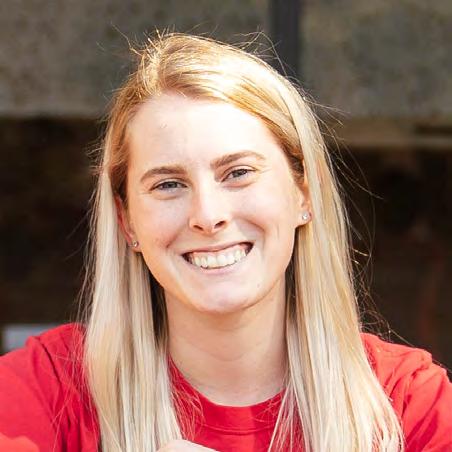 Martin Reyes
Madison Hamby
Trevor Eustaquio Regan Persyn
Martin Reyes
Madison Hamby
Trevor Eustaquio Regan Persyn
STUDENTS
92 PARAMETERS Fall 2022
During our interview, the topic of being a woman in a male-dom inated major was brought up, and Madison said that it was an advantage for her at UH. During her freshman and sophomore years, Madison was invited to be a counselor at UH Engineering’s G.R.A.D.E Camp, a STEM summer camp that introduces girls in 8th through 12th grade to science and basic engineering concepts. Here, Madison taught a group of girls to build and program a LEGO robot to navigate through a maze. She told me that this experience of being a mentor to younger aspiring women in STEM inspired her to become a professor, as there aren’t as many women teaching engineering.
Madison is returning to UT Austin in the fall to pursue a Ph.D. in Computer Engineering, and to continue research with her professor from REU. She explained that even though she enjoys working on large projects in the industry, the idea of making a small contribu tion to science with her name attached through research is inimi table.
Moving from Guam to Houston in 2014, Trevor Eustaquio was sure he wanted to major in petroleum engineering once deciding to go to school in the heart of the oil and gas industry. Transferring from Lone Star College, Trevor joined the small community of his class mates in this niche major and set foot in the technical coursework taught by industry-experienced professors.
Trevor participated in the PURS program, where he researched liq uid loading in gas wells under the mentorship of Dimitrios Geor gios Hatzignatiou in Petroleum Engineering. Along with research, Trevor has gained valuable internship experience as a Well Design Solutions Intern at Tenaris the summer before his senior year, and Engineering Analyst Intern at Occidental Petroleum during his final year of undergrad.
He mentioned that his required Production Engineering and Drilling Engineering classes prepared him for his internships, as the data he worked with was related to what he learned in his courses. He was able to learn about these opportunities from company information sessions and webinars hosted by Pi Tau Epsilon – the Petroleum Engineering Honor Society – which he was involved with since his freshman year, and served as president during his senior year.
During our interview, Trevor stressed the importance of profession al networking, and how becoming involved with campus organi zations and activities allows for valuable avenues and connections to the industry he pursues to work in. Trevor told me he went to every career fair hosted by the Cullen College of Engineering, and through networking at these events, he received interviews and job offers from multiple petroleum companies such as Schlumberger upon graduating.
Inspired by her father who is an engineer, as well as having a pas sion for working in healthcare, Regan Persyn was motivated to get involved throughout her time at UH as a biomedical engineering major. Serving as the vice president of BMES during the pandemic, Regan was promoted to be the interim president of the organiza tion when the previous president stepped down.
Though being thrown into the position and having to fulfill the role solely based on observation, serving as the President of BMES has been a rewarding experience for her. Regan was able to witness the growth of membership from the organization’s transition from virtual to in-person, as well as develop interpersonal soft skills from a leadership position and the opportunity to network with many faculty members from the Biomedical Engineering department.
Along with Go Baby Go, Regan’s favorite experience of BMES was Project CURE, a volunteer program that receives donated medical equipment, such as syringes, wound packs, and incubators, and packages it to developing countries for trauma crises.
When she is not running an organization or engaging in course work, Regan also works part-time at a fitness studio. She tells me that scheduling time to focus on hobbies that she enjoys outside of class has helped the academic burnout that many engineering students experience.
Following the bionanoscience track of the Biomedical Engineering course plan, Regan has taken classes such as Drug Delivery and Design and Biomedical Microdevices, which have influenced her to pursue a career in the medical device industry, where she looks for ward to work on electrical components to engineer the human body.
At the end of each interview, I asked the seniors what made their undergraduate experience memorable, as well as ad vice for incoming engineering students. They gave me many unique, as well as overlapping answers, so I’ll compile them in a short list.
• Involvement in campus organizations and events. This is a great way to make friends and find a group of people with similar interests.
• Professors that are passionate about the subject they are teaching.
• Discovering what excites you within engineering.
• Whether it be the person sitting next to you in class or an employer at a career fair, make connections with anyone and everyone.
• The IEEE Chili Cook-Off. Every one of them mentioned this!
• Learning from your failures. Seeing academic and personal im provement is satisfying and motivating when you understand how you are as a student.
• Finding a community of classmates knowing you’re all there to support each other.
These are just four of the many success stories from the Cullen Col lege of Engineering. Every semester, a number of students receive their diplomas and set off into their post-grad lives, each with their own individual stories of how they got to UH, what they gained during their time here, and how they embark into their futures with the memories of this institution.
University of Houston Cullen
College of Engineering 93
BY STEPHEN GREENWELL

We expect that this characterization will allow physicians to target treatment to the source of the pelvic floor dysfunction for each specific patient. NICHOLAS DIAS CHRONIC PELVIC PAIN MANAGEMENT: Research Spotlight on Alum Nicholas Dias
ALUMNI 94 PARAMETERS Fall 2022
A graduate from the Cullen College of Engineering received a first round of funding from the National Institutes of Health FastTrack program for research into chronic pelvic pain management, with close to $2 million potentially available as the research continues.
Nicholas Dias, Ph.D., is a research scientist working for HillMed, Inc., a Houston-based medical research firm. Dias also graduated from the University of Houston with a B.S. in 2015 and a doctorate in 2020, both in Biomedical Engineering.

His proposal, “An Novel Medical System for Quantitative Diag nosis and Personalized Precision Botulinum Neurotoxin Injection in Chronic Pelvic Pain Management,” was chosen for $251,964 in Phase 1 funding, for one year. As long as milestones are hit for Phase 1, an additional $1.7 million for three years of funding will be released.
Dias said his research at the firm centers on diagnosing and treat ing pelvic floor dysfunctions that complicate chronic pelvic pain (CPP).
“Specifically, we are developing a device that maps the activity of the deep pelvic muscles to help clinicians better characterize and locate pelvic muscle over-activity,” he said. “We expect that this characterization will allow physicians to target treatment to the source of the pelvic floor dysfunction for each specific patient. These personalized treatment regimens should lead to improved patient outcomes.”
For Dias, this need for personalized treatment regimens was part of a technical challenge that got him and kept him involved in the research.
“CPP is persistent pain in the lower abdomen or the pelvis with out an obvious ongoing disease process. The causes of CPP are multifactorial with many potential underlying sources,” he said. “Each patient with CPP may present with a unique combination of pain sources. It was this complexity that interested me the most. By leveraging advancements in high-density electromyo
graphic signal acquisition and processing, I believe that we can provide clinicians with a better picture of each patient’s pelvic floor functional status to allow clinicians to tailor treatments to each individual patient. I expect that our contributions can help people with CPP receive effective care faster to alleviate their de bilitating pain.”
Dias noted that several people – at UH and other organizations –have been instrumental in his research pursuits.
“I could go on and on in response to this,” he said, laughing. “There are so many people who had a positive impact on my ac ademic career. I must first recognize my Ph.D. advisor, Dr. Yingc hun Zhang, for giving me the tools, knowledge, and most impor tantly, the encouragement to keep searching for answers to these pressing questions.”
“My academic research would not have been possible without generous clinical knowledge from Dr. Christopher Smith at Baylor College of Medicine, and Dr. H. Henry Lai and Dr. Tracy Spitznagle at Washington University School of Medicine. These clinicians are world-renowned experts in chronic pelvic pain and generously provided this expertise during my Ph.D. studies. Finally, I must recognize Dr. Metin Akay for his gracious support, advice and enthusiasm for research, which piqued my early interests in bio medical engineering.”
The first portion of Dias' research began in September 2021 and wrapped up in August.
The grant is part of the Helping to End Addiction Long-termSM Ini tiative, or NIH HEAL InitiativeSM. It is an aggressive, trans-NIH effort to speed scientific solutions to stem the national opioid public health crisis. Launched in April 2018, the initiative is focused on improving prevention and treatment strategies for opioid misuse and addiction, and enhancing pain management.
Nicholas Dias
University of Houston Cullen
College of Engineering 95
BY STEPHEN GREENWELL

Solving the WATER CRISIS: Doctoral Grad Earns NSF Postdoctoral Fellowship
ALUMNI 96 PARAMETERS Fall 2022
Cynthia V. Castro, Ph.D., can describe firsthand the importance of networking and being thoroughly prepared. For the Cullen College of Engineering graduate, both aligned for her when it came to meeting a respected figure in her field, which led to her securing a National Science Foundation award for a fellowship at the University of Illinois Urbana-Champaign (UIUC).
Castro's proposal, “Green infrastructure scaling from local observa tions to regional applications as a coupled human-water system,” was selected for $174,000 in funding. She will be mentored by Murugesu Sivapalan (Siva), Ph.D., the Chester and Helen Siess Endowed Profes sor in Civil and Environmental Engineering at UIUC.
Castro was aware of Siva's academic reputation and made a point of introducing herself when he spoke at a UH department seminar.
“I learned about the speaking engagement from a colleague at UH, Dr. Hong-Yi Li, who had also worked with Siva,” Castro said. “I knew I needed to leverage this opportunity. At the time, I was working down town at the City of Houston Mayoral Office as part of an NSF INTERN opportunity, so I specifically requested to leave the office early that day.”
Castro had prepared some talking-points for after the seminar.
“To my surprise, Siva was highly interested with my thoughts regard ing the direction of socio-hydrology,” she said, describing socio-hy drology as a research field about how the world’s water crisis is com plex and deeply embedded with social processes. Such phenomena require new paradigms for understanding and managing water prob lems.
“I explained how we need to start including nature-based solutions, like 'green infrastructure,' into the socio-hydrology realm, especially since the United Nations recently asserted that nature-based solu tions can mitigate up to one-third of the global greenhouse gasses we need to achieve the Paris Climate Agreement. Siva agreed and invited me to Illinois to brainstorm on these ideas further.”
Unfortunately, this initial meeting was in February 2020, and the pandemic made a trip to Illinois no longer viable. However, Castro
remained diligent and shaped her long-term research vision based on further exploration of developments in the socio-hydrological field.
“The previous summer, I had spent several weeks at the library perus ing hydrological textbooks from the previous many decades, gaining inspiration about the theory of 'scale,' which describes how physical properties may shift as we, the observer, shift our lens of looking at the problem. Scale issues are quite important in watershed phenome na, as understanding the trade-offs across scale, both temporally and spatially, impacts how we may perform watershed modeling and our trust in the validity of the outcomes.”
Her accepted NSF proposal came about because she thought the field of scaling needed further development and attention, particularly re garding social phenomena embedded within the system.
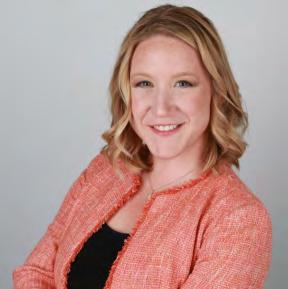
“At present, much of the fervent research about issues of scale in the water sciences has been reduced. I proposed that we needed to apply issues of scale not only to physical watersheds but also to the social processes occurring within the watershed. These processes influence the water system and are also being influenced by long-term chang es in things like climate, land use, agriculture, green space, develop ment, population growth and other things.”
Castro wrote these ideas into the fellowship paper, where she pro posed investigating issues of scale for nature-based solutions as a so cio-hydrological phenomena.
“I was nervous, as this particular fellowship only issues eight to 12 awards per year, and it is highly competitive,” she said. “To my delight, the hard work and many months of thought paid off, and I was noti fied in March 2021 of the good news.”
Castro thanked Li for steering her toward this networking opportu nity, and for advising her at various points while at UH. Previously, Castro earned the American Water Works Association scholarship.
For the logistics of her fellowship, Castro said, “I will be working hy brid between Texas and Illinois,” she said. “The entire department at UIUC overwhelmingly support this arrangement, and I look forward to being part of the UIUC campus and to network with their scholars.”
Cynthia V. Castro
University of Houston Cullen College of Engineering 97
Daniel Wong Named HOUSTON ENGINEER OF THE YEAR
BY STEPHEN GREENWELL
Daniel Wong, Ph.D., P.E., a distinguished graduate of the University of Houston's Cullen College of Engineering, was selected as the 2022 Hous ton Engineer of the Year.

Wong was honored at the 2022 Engineer of the Year Gala, which took place on Feb. 25 at the InterContinental Houston-Medical Center. Wong is President and CEO of Tolunay-Wong Engineers, Inc., which is headquar tered in Houston and has 10 offices in Texas and Louisiana. He is a licensed engineer in Texas, and an adjunct professor in the Civil and Environmental Engineering Department. Wong has given generously to the college in the past, and in June 2020, he established an Endowed Professorship, known as the Honorable Daniel Wong Endowed Professorship.

ALUMNI 98 PARAMETERS Fall 2022
At the gala, Roberto Ballarini – Thomas and Laura Hsu Professor and Department Chair – read the following speech:
The faculty, students and staff of the University of Houston’s Civil and Environmental Engineering Department are delighted that Dr. Daniel Wong was selected as the 2022 Houston Engineer of the Year. Dr. Wong is one of our most distinguished alumni, and we are extremely proud of him.
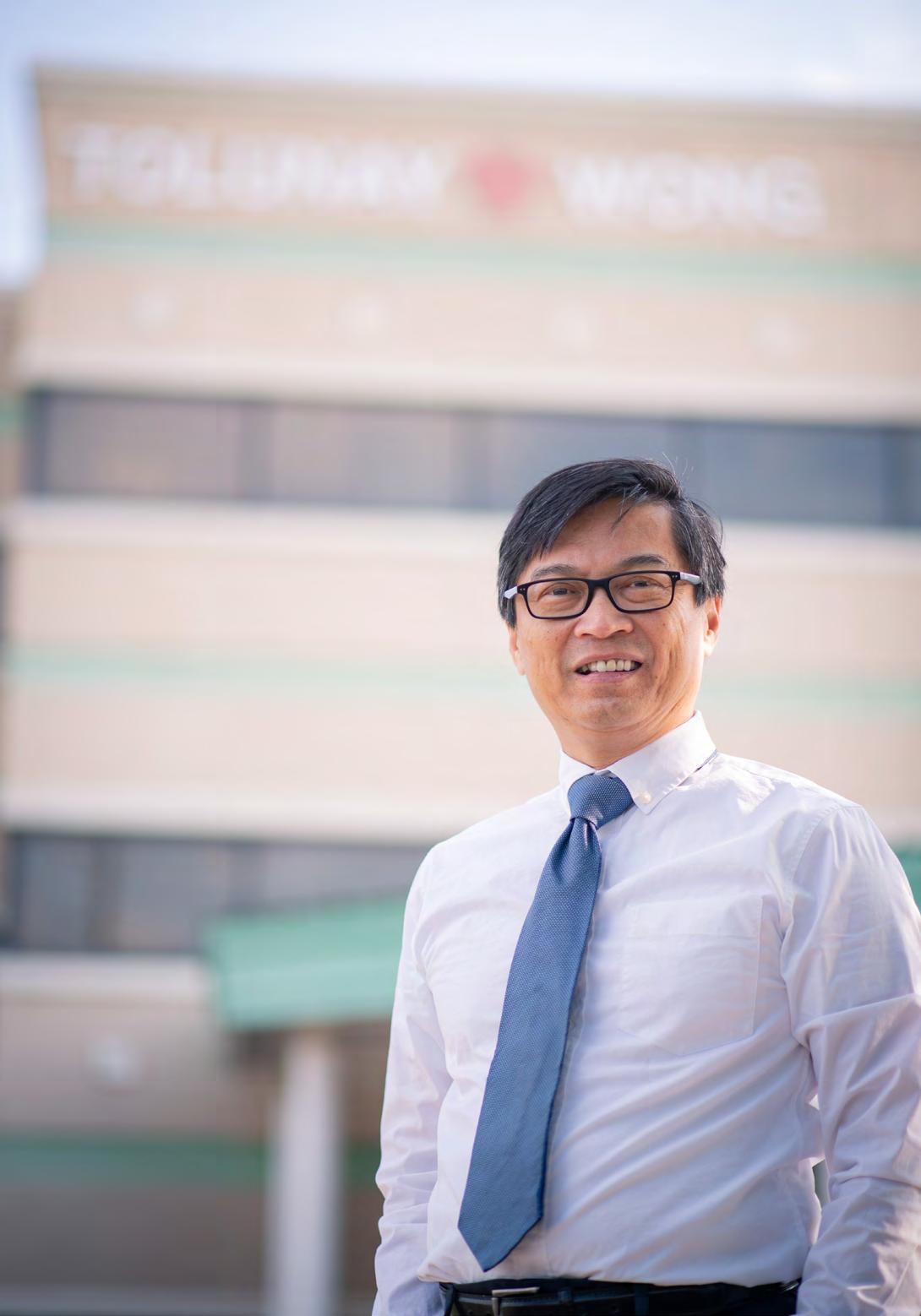
Dr. Wong left his native Macau in 1984, with only the shirt on his back, to pursue a doctorate in our Department. Under the guid ance of Professor Cumaraswamy Vipulanandan he completed his degree with a thesis that led to a publication and presentation that received the 1990 ASCE Texas Section John B. Hawley award for best paper.
While Dr. Wong could have gone on to a successful career in academia, as evidenced by the dozen or so research papers he published in prestigious journals, he decided to pursue a job in industry. I must note that Dr. “Vipu” is especially proud of his first doctoral student, having predicted early on that Dr. Wong would become a leader in the Texas engineering profession.
What can our Department be more proud of than an alumnus who used his technical excellence, extraordinary vision, exempla ry work ethic and distinctive leadership abilities to create a com pany that employs hundreds across the Southern United States, and that has improved its infrastructure? The answer is that in addition to excelling technically and in leading his company, Dr. Wong has dedicated a significant amount of his time and energy to serve his profession and his communities.
Dr. Wong was a past gubernatorial appointee to the Texas Board of Professional Engineers as a member for seven years (20062013) and as Chairman for an additional seven years (2013-2020). He is an active member of the Texas Society of Professional Engi neers, the American Society of Civil Engineers, and the American Council of Engineering, and was the recipient of the 2016 Texas Engineering Foundation Distinguished Engineer.
His community service has also been impressive. Dr. Wong served as At-Large Council Member for the City of Sugarland for six years (2002-2008), on the Board of the Houston-Galveston Area Coun cil, and the Board of the Texas Municipal League. In addition, he is an officer of the Ford Bend County Economic Development Coun cil and is a former board member of the Fort Bend YMCA and the Fort Bend American Heart Association.
But there is more. Dr. Wong has been one of the pillars of our undergraduate teaching program in geotechnical engineering. As a Senior Lecturer for many years, he inspires our students and provides them his “real world” experience.
As Department Chair I very much appreciate Dr. Wong’s unflinch ing support of our teaching and research missions, and of our stu dents, faculty and staff. He has proven to always be there for me when I need his advice and guidance. Dr. Wong recently estab lished, through a very generous gift, the Honorable Daniel Wong Endowed Professorship in Civil Engineering. This gesture speaks volumes for how much Dr. Wong loves our Department, and for his appreciation of his mentor Dr. “Vipu”, who is the inaugural recipient of this honor.
Congratulations Daniel.
Daniel Wong pictured outside Tolunay-Wong Engineers, Inc. headquarters.
University of Houston Cullen College of Engineering 99
LENS
BY JOHN LIENHARD
Good engineering means guessing how change will occur. But that’s hard to do. It’s a lot like bull-riding at the rodeo. A rider never knows just how the bull is going to zig or zag. Same with engineering. Too often, we have to ride such cusps.

Example: It was clear (even before the Wright Brothers) that airplane engines would have to be lighter-weight forms of the new internal combustion engines. Samuel Langley powered his new airplane with an engine based on an early car motor. Once launched, it sank like a stone into the Potomac River. Nine days later, the Wrights succeeded with their own light engine design. The Wrights saw which way their bull was zigging. Langley did not.

But that set the stage for a different kind of bull ride – one that lasted decades. Here’s how it went: A mixture of fuel and air burns explosively to drive engine pistons. So we have to cool their
cylinders. We can do that in either of two ways in an airplane: We can fit them with a jacket of cooling liquid. Or we can let air blow past them, and cool them like a huge fan.
That means either of two arrangements: We can line cylinders in a row when they’re liquid cooled. That lets us make the airplane thin and more streamlined. But then the airplane also has to carry extra machinery – more weight, more cost, more maintenance.
So what about air cooling? Combat airplanes needed strong en gines with many pistons. That meant arranging them in a circle facing the wind. So air-cooling meant more wind resistance. But it also took far less complication and cost. (Many WWI airplanes went further. They let the engine spin around a fixed crankshaft. The spinning engine then cooled itself nicely. But the engine also acted like a gyroscope and made flying somewhat tricky.)
A 1910 Wright Brothers' liquid cooled engine. Image credit: John Lienhard
LIENHARD’S
CULTURE & EVENTS
100 PARAMETERS Fall 2022
The Germans favored liquid cooling in WWI, but not entirely. The Allies leaned more toward rotary air-cooled engines. After the war, the new commercial aircraft favored air cooled engines. But there was also a new competition for speed, and racing planes were again undecided. Then, WWII: Now armies on both sides favored liquid cooling. But most navies used air cooling.
And the very first engines? The Wright Brothers used liquid cool ing. Glenn Curtiss and Santos Dumont used air cooling. Indecision went from the very beginning until jet engines burst on the scene and cylinders almost vanished. (But not quite. Today, most very light airplanes use air to cool only a few cylinders.)
So engineers rode a cusp throughout the first half of the 20th century. Back and forth. Two technologies, neither of which could win the day. Which way was the bull lurching? Then the ride end
ed as swiftly as being dumped from a bull. It did so as most large aircraft switched from piston engines to jet propulsion – in hardly the blink of an eye.

I’m John Lienhard, at the University of Houston, where we’re in terested in the way inventive minds work.
VIEW MORE PHOTOS AT enginespics.smugmug.com
Continental R-670, 7-cylinder, air cooled engine 1934.. Image credit: John Lienhard
WATCH THIS EDITION LIENHARD'S LENS
OF
COME TO LIFE AT: youtube.com/UHEngineering University of Houston Cullen College of Engineering 101
STEMINIST
In this episode, Ruby Patterson, a University of Houston Ph.D. candidate studying planetary geol ogy, talks about her research from Iceland, to the Moon, to Mars. Her past internship at the Lunar and Planetary Institute (LPI) focused on the Apollo Mission and she aims to publish a manuscript about the samples that will be returned from the Moon to Earth. This episode was hosted by Nicole Guinn, a Ph.D. student at the Cullen College of Engineering.

NG: Welcome Ruby to the podcast. Could you please state your name, what you are doing in school, and what you studied?
RP: Hi, I’m so glad to be here! My name is Ruby Patterson and I am a Ph.D. candidate here at the University of Houston. I’m a planetary geologist, which feels so cool to be able to call myself that, but basically I study the Moon and Mars through satellite images and physical samples, so things like meteorites or Apollo samples from the moon. Since the Moon and Mars are places that are so challenging to visit, I also go to places on Earth that are very similar to the Moon or Mars in some ways, and I study them up close. And these places are known as environmen tal analog sites. After I go to these places on Earth, I’m able to draw comparisons between the terrestrial locations and what we observe on the Moon and Mars.
Episode Excerpt: Moon, and Iceland, oh my!
CULTURE & EVENTS
SEASON 2 . EPISODE 19 . Mars,
PODCAST 102 PARAMETERS Fall 2022
NG: Thank you, Ruby. What’s an example of a terrestrial analog?
RP:
Oh, I’m so glad you asked! That is definitely one of the highlights of my work. A particular analog site would be Iceland. Iceland is considered an analog site because there are not very many people out there so it very easy to have undisturbed settings to do your work in, but also there is very little vegetation and all of the rock types are very similar to what we observe on the Moon and on Mars.
NG: Being a planetary geologist sounds pretty cool. Do you get to hold any pieces of Mars?
RP: Yes! That’s so awesome you asked that, yes. You can actu ally buy pieces of Mars on eBay and so any of you listen ers can actually buy little chunks of Martian meteorites yourself if you’re into that sort of thing. But there are lots of Mar tian meteorites that scientists all over the world study to get a better idea of what’s present and on the Martian surface and even the Martian subsurface. But also, we have this beautiful suite of Apollo samples that the Apollo astronauts brought back from their time on the lunar surface. That’s been a huge wealth of knowledge and understanding of the lunar history, but there’s still so much more that we need to find out about the Moon, which is one of the reasons why the Artemis program is kicking up because there’s still a lot we need to know.
NG:
And for those of you out there who aren’t super fa miliar with our Artemis mission, Ruby, could you give us some basic background information on it?
RP: Oh yeah, I’d be happy to. So, the Artemis mission, or the Artemis program, has several different missions planned. The long and short of it is that NASA is going to send the first woman and the first person of color to the lunar south pole. And the lunar south pole is really interesting because there’s very exaggerated topography. There are actually regions on the lunar south pole that never receive sunlight under any circumstances. And it’s in a lot of these permanently shadowed regions that wa ter ice has been detected and also dry ice, so carbon dioxide ice, and what scientists want to do is figure out is not only is how old this really intense topography and really unique terrain on the moon, but how old are different geologic events in the formation of our solar system, so the period of heavy bombardment and different bombardment periods of our solar system, but we’re also very interested in these ice deposits because we can break that down into components for rocket propellant and also breath able oxygen so that one day astronauts can stay on the lunar sur face for several days, or perhaps weeks at a time instead of just an abbreviated visit like what we observed in the Apollo mission.
NG: What sparked your interest in planetary science?
RP: I’ve always been a space nerd. Ever since I was a little kid, I would read those big picture books about space. I begged my parents to go to space camp when I was a kid. Al
though I was never able to go to space camp, I ended up going to a science camp in San Antonio, Texas where I grew up and I got to shake Sally Ride’s hand which was a transformational experience for me to say the least. I absolutely adored her and everything Sally Ride did. For those of you who don’t know, she was an American astronaut, and very prominent because she was one of the first female astronauts that NASA put up into space.
I’ve always loved space. I come from a family of geologists. My dad is an oil and gas geologist. My sister is also an oil and gas geologist. And so, I grew up with my dad visiting my elementa ry school classrooms and bringing his huge rock and crystal and fossil collections and showing them off to all my classmates and I felt so cool, like yeah, that’s my dad! That really sparked a love of geology when I was a child. It wasn’t until I was in community college in undergrad when in that period of my education that I even realized that planetary geology existed. I had never even thought about combining the two together, and that is where this grand love of planetary geology really began.
LISTEN TO THE FULL EPISODE AND OTHERS AT: www.egr.uh.edu/news/podcast
About the STEMINIST podcast:
The STEMinist podcast was conceived in part by the Cullen College of Engineering and Nicole Guinn, a Ph.D. student in the college’s geosensing systems engineer ing and sciences program, as a way to introduce an underrepresented topic: science communication. The podcast project seeks to improve science communica tion skills and give a voice to women in STEM fields. Guinn served as the podcast’s primary host for seasons 1 and 2. Topics have ranged from climate change, space exploration, career advice, work-life balance and plu ralistic ignorance.
STEMinist returned this fall for season 3. Listen to new episodes online, or start from the beginning, at www. egr.uh.edu/news/podcast or on Anchor, Spotify, or any where you get your podcasts.
University of Houston Cullen College of Engineering
103
SPRING 2022 COMMENCEMENT
The Spring Class of 2022 Commencement ceremony was held in May at the Fertitta Center. This year’s commencement speaker was Chris Angelides, the Honorary Consul of the Republic of Cyprus to Texas, and the Head of Energy Transition Program at Shell.






CULTURE & EVENTS
104 PARAMETERS Fall 2022
CAREER FAIR SPRING 2022


The College’s bi-annual career fair was held in-per son at the UH Hilton for the first time in two years after going virtual during the pandemic. The event was held over two separate days and was held in both in-person and virtual formats. 118 companies were present with more than 230 industry repre sentatives attending the event. More than 1000 students participated, and more than 600 video chats were held.



 University of Houston Cullen College of Engineering
University of Houston Cullen College of Engineering
105
IEEE CHILI COOK OFF




 The IEEE Chili Cook Off returned after a 2-year hi atus. The long-held event is a student and alumni favorite. Teams compete for prizes and bragging rights for the best bowl of chili. This year’s event was held in March.
The IEEE Chili Cook Off returned after a 2-year hi atus. The long-held event is a student and alumni favorite. Teams compete for prizes and bragging rights for the best bowl of chili. This year’s event was held in March.
CULTURE & EVENTS
106 PARAMETERS Fall 2022
SPRING 2022 WOMEN IN ENGINEERING CELEBRATION

The Cullen College’s Women in Red Trailblazers returned for their first in-person celebration after going virtual the past several semesters. The event was held at the UH Hilton and honored its annual Rising Star Awardee, given to a graduating female student with the highest GPA. This year’s Rising Star Award went to Sarah Hakam, a biomedical en gineering senior who was also named the Cullen College’s Outstanding Senior. The event was once again hosted by its leading Women in Red Trailblaz er, Cynthia Oliver Coleman, P.E.



 University of Houston Cullen College of Engineering
University of Houston Cullen College of Engineering
107
ENGINEERS WEEK CELEBRATION
The Engineering Alumni Association (EAA) hosted another successful event on Feb. 22 as part of the 2022 Engineers Week Awards program. This year’s theme was “Re-imagining the Possible” and rec ognized 50 UH engineering students for their out standing academic achievements and strong lead ership skills.
This event would not be possible without the sup port of the generous donors for this year’s program. More than $50,000 was raised from corporations, professional engineering organizations, Cougar alumni engineers, and friends of UH. The funds pro vide scholarships to each of the selected students.




CULTURE & EVENTS
To learn more about events and outreach at the Cullen College, visit www.egr.uh.edu/events or follow us on social media! UHEngineering @uhengineering University of Houston Cullen College of Engineering @uhengineering @uhengineering View more photos online at www.flickr.com/photos/cullencollege/albums 108 PARAMETERS Fall 2022
ENGINES OF OUR INGENUITY
NO. 1482: BLACK BOX
BY JOHN H. LIENHARD
Today, we ask what's inside a black box. The University of Hous ton's College of Engineering presents this series about the ma chines that make our civilization run, and the people whose inge nuity created them.
The word "black box" hasn't been part of our language for long. It first meant a closed set of electronic gear. Over time, it's come to mean any function hidden from sight. In fact, it's turned into a metaphor for a retreat from understanding. When we call the flight recorder of an airliner a "black box," we acknowledge that it's to be opened only in the most dire circumstances.
When I was a kid, we stocked radio tubes on the shelf like light bulbs. When one burned out, we replaced it. If a transistor fails in today's radio, we replace the radio. Radios are black boxes -- I have almost no idea what's in mine. Our computers, car transmis sions, and clocks have all become black boxes. Even their labels tell us they can be opened only by factory representatives!
How do you and I do with questions like, "What's a universal joint?" or "What does a carburetor do?" We're far less likely to know these things today because cars themselves have become black boxes. Car owners once looked right down into their Mod el-T transmissions; and when they broke, they had to know how to fix them.
Automobiles once taught us applied mechanics. Radios taught a whole generation about electronic circuitry. I got my grounding in internal combustion, aerodynamics, and electricity by building model airplanes. In 1943 we had to wire a coil, condenser, and battery together just to make the spark plug fire.
Now the personal computer is a black box. I might nerve myself up to open mine and replace a component. But don't even think about asking me to explain how my Pentium chip works.
The lingering question is, "What knowledge do we need?" Few of us have any reason for knowing the workings of an old Ford transmission. At the same time, I wish I knew more about the automatic transmission in the car that takes me to work.
The people who invented my transmission were the best of a gen eration that cut its teeth on Ford planetary gears. But today's pop ulation includes very few people who understand today's trans missions. Automobiles in the year 2050 will have to be built by people who don't understand the transmissions on today's cars.
They'll be supported by knowledge contained in computers that also lie beyond their understanding. So we're systematically being separated from the black boxes that serve us. As we handle so phisticated systems without looking inside the complexities that make them up, knowledge itself becomes black-boxed. Someone who knows about computers may know nothing about cars. John Donne's poetry can remain a black box for a student of Pushkin.
How do we teach our students that the boxes around them aren't Pandora's boxes -- that they can be opened? How do we teach them that what one fool can do, another fool can also do -- that they're smart enough to open anyone else's black box? Students have to know that invention inevitably means working inside black boxes.
I'm John Lienhard, at the University of Houston, where we're in terested in the way inventive minds work.
 The Engines of Our Ingenuity is a nationally recognized radio program authored and voiced by John Lienhard, professor emeritus of mechanical engineering and history at the University of Houston and a member of the National Academy of Engineering. The program first aired in 1988, and since then more than 3,000 episodes have been broadcast. For more information about the program, visit www.uh.edu/engines.
The Engines of Our Ingenuity is a nationally recognized radio program authored and voiced by John Lienhard, professor emeritus of mechanical engineering and history at the University of Houston and a member of the National Academy of Engineering. The program first aired in 1988, and since then more than 3,000 episodes have been broadcast. For more information about the program, visit www.uh.edu/engines.
LAST WORD

UH Cullen College of Engineering Office of Communications Engineering Building 2 4222 Martin Luther King Blvd, Suite E311 Houston, Texas 77204-4009 @UHEngineering



